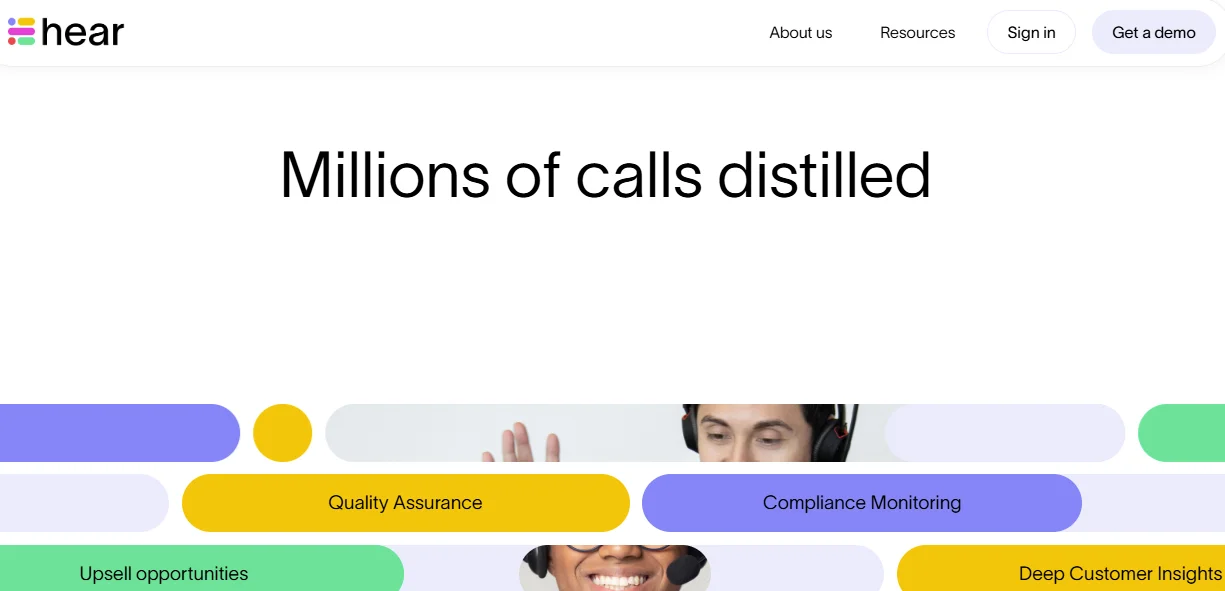AI-Driven Industry Insights for Smarter Contact Centers

Intent Prediction: Rewiring the Contact Center for Proactive Intelligence

- The Reactive Trap: Why Waiting is Expensive
- The Architecture of Anticipation
- Rewiring for Revenue and Retention
- The Evolve or Die Mandate
The Reactive Trap: Why Waiting is Expensive
Most contact centers operate on a model that was obsolete ten years ago. You wait for a problem to escalate. You wait for the phone to ring. You wait for the customer to threaten cancellation. By the time an agent picks up, the damage is already done. This is not service. It is damage control. Relying on lagging indicators like yesterday's CSAT scores or random 1% call sampling creates a blind spot that costs millions in lost revenue every year.
The industry standard of "being available" is no longer sufficient. While traditional leaders celebrate low Average Handle Time (AHT) on calls that never should have happened, advanced operators are eliminating those calls entirely. Revenue leakage happens in the silence between the problem occurring and the customer complaining. If your operating model relies on the customer to initiate the repair, you have already failed the experience test.
The Architecture of Anticipation
The shift from reactive to proactive requires more than new software. It demands a fundamental architectural change. We are moving toward an Agentic AI model where systems do not just record data but actively scan for intent. This is the difference between reading a transcript and predicting a behavior. By analyzing 100% of interactions, modern platforms identify subtle acoustic and semantic markers that precede a negative event.
"Prediction is the only metric that buys you time. Everything else is just a history lesson."
Consider the mechanics of churn. A customer rarely quits on a whim. There are signals—tone shifts, specific keywords, silence duration—that occur weeks in advance. Predictive analytics for customer churn allows leaders to flag these accounts before the cancellation call ever hits the queue. This rewires the workflow from "handling objections" to "preempting friction." You stop managing tickets and start managing relationships.
Rewiring for Revenue and Retention
Implementing intent prediction transforms the P&L. It turns the contact center from a cost sink into a strategic intelligence hub. When you know why a customer is calling before they speak, you shorten handle times and drastically increase resolution accuracy. More importantly, you unlock the ability to intervene. Forward-thinking leaders using Hear.ai have already utilized these early warning systems to secure a 20% reduction in inbound churn-related calls.
This creates a compounding efficiency effect. By intercepting complex issues early, you reduce the load on your tier-2 agents. Routine inquiries are deflected or automated, leaving your human talent to focus on high-value interactions. This is the autonomous contact center in practice. The system self-corrects. It identifies a compliance risk or a dissatisfaction trend in real-time, alerting supervisors instantly rather than waiting for a weekly batch report. The operational cadence shifts from weekly reviews to real-time orchestration.
The Evolve or Die Mandate
The gap between reactive centers and predictive operations is widening. Competitors are not just answering calls faster than you. They are preventing the calls you are still struggling to staff for. The technology to analyze 100% of voice data and predict intent is no longer theoretical. It is the new baseline for survival.
You can continue to staff for the fires you let burn, or you can architect a system that prevents the spark. The choice is binary. See what proactive intelligence looks like.

The Coaching Illusion: Why Subjective Feedback Kills Performance

Most contact centers operate under a dangerous delusion. Leaders believe they are coaching their teams to excellence. In reality, they are taking a big risk and could easily lose control of their customer experience. If your quality assurance relies on supervisors manually listening to calls, you are not managing operations. You are gambling.
The industry is shifting! While traditional call centers debate sample sizes, AI-native competitors have already automated 100% of their oversight. They have stopped guessing. If you are still relying on human sampling, you are already behind.
The Mathematics of Failure: The 1% Trap
Let’s look at the numbers that should keep you awake at night. The industry standard for manual QA covers approximately 1-2% of total interaction volume. This means you have a 98% blind spot across your entire operation. You are making strategic decisions based on a statistical margin of error that in any other situation would not be found acceptable.
This fragmentation creates a chaotic feedback loop. A supervisor might catch one bad call out of fifty and reprimand an agent who performed perfectly on the other forty-nine. This isn't data-driven management. It is anecdotal management. Relying on manual scorecards for coaching is like trying to reconstruct a movie by looking at three random frames. You miss the plot, the context, and the outcome.
Revenue performance success metrics don't provide the full picture either. Even if an agent's sales or retention results are considered good, they could still be potentially much better, or an agent could be creating a bad reputation for the company, along with an additional wide range of brand and compliance issues.
Key Reality Check:
The Bias Problem: Why Agents Actually Quit
Subjectivity is the silent killer of agent retention. When feedback depends on which supervisor is listening and what mood they are in, the data becomes useless. Research indicates that "idiosyncratic rater bias" accounts for over half the variance in performance ratings. The score tells you more about the supervisor's bias than the agent's skill.
This inconsistency creates friction. Agents perceive feedback as unfair because, mathematically, it is. They are being judged on a tiny, unrepresentative sliver of their work. This leads to disengagement and churn. Agents crave objective truth. They want to know exactly how they performed across all their calls, not just the one where they got unlucky.
"You cannot build a high-performance culture on a foundation of subjective guesses."
From Supervisor to System Architect
The solution requires a fundamental shift in role definition. We must move from reactive monitoring to proactive architecture. AI-native platforms analyze 100% of voice calls in near real-time. This eliminates the blind spot immediately. Every pause, every interruption, and every tonal shift is scored against objective benchmarks.
This changes the game. Supervisors save 70% of their time previously wasted on random listening. They stop being data collectors and become system architects. They use the intelligence hub to spot systemic patterns—like a flaw in the pricing script or a competitor's new offer—and fix the process, not just the person.
The AI-Native Shift:
Conclusion: The Darwinian Choice
The era of manual sampling is over. The market will punish those who cling to it. Companies that have switched to automated, 100% coverage are seeing 30% reductions in compliance violations and massive leaps in conversion rates. They are operating with the lights on.
You have a choice. You can continue to coach based on guesses and bias, watching your best agents leave, your customer experience suffer and your revenue leak. Or you can rewire your operation for total visibility.
Do not wait for the quarterly review to realize you are obsolete. See what 100% intelligence looks like today.

Revenue Leakage Exposed: Your Support Center is a Gold Mine

- The Cost Center Fallacy
- Silence is Expensive (and Predictable)
- Architecting Revenue Defense
- Evolve or Fade
Your P&L has a hole in it. While leadership scrutinizes marketing spend and sales cycles, a massive stream of revenue is quietly draining out of your contact center. Walk into most operations today and you see teams optimized for speed. They chase Average Handling Time (AHT) while ignoring the gold mine of intelligence flowing through their headsets.
This is not an operational oversight. It is strategic negligence. Every customer interaction holds a binary potential: it either builds equity or erodes it. If you are still relying on random call sampling, you are blind to 98% of these pivotal moments. The market leaders are not just answering phones anymore. They are orchestrating a shift from cost center to revenue engine.
The Cost Center Fallacy
The probability of selling to an existing customer is 60-70%, compared to just 5-20% for a new prospect. Yet, most support agents are trained to resolve tickets, not recognize buying signals. A customer mentions a life change, a new business need, or a dissatisfaction with a competitor. In a manual environment, these moments vanish the second the call ends.
This is where revenue leakage accelerates. Without comprehensive customer intelligence, you miss the context that drives conversion. Forward-thinking organizations have stopped treating support calls as administrative burdens. They utilize AI to surface missed cross-sell and upsell opportunities instantly. If your system cannot flag a buying signal in real-time, you are effectively handing that revenue to a competitor who can.
Silence is Expensive (and Predictable)
Churn does not happen abruptly. It broadcasts itself in tone, hesitation, and specific keywords weeks before a cancellation. The problem is that traditional QA—listening to 1% of calls—is a statistical gamble you will always lose. You cannot fix what you do not hear.
Silent attrition is the killer of profitability. Customers rarely scream before they leave; they express subtle frustration that manual monitoring misses. By the time a formal cancellation request comes through, the opportunity to save the account has dropped to near zero. Deploying predictive analytics for churn transforms this dynamic. It moves you from autopsy to intervention. Identifying at-risk customers based on 100% of their interaction history allows retention teams to act while the customer is still listening.
Architecting Revenue Defense
Fixing this requires a systems mindset. You cannot patch a leaking dam with a chaotic mix of spreadsheets and subjective supervisor feedback. You must rewire the operation to be AI-native. This means deploying an architecture that analyzes every second of every call, categorizing intent and sentiment without human fatigue.
Consider the operational impact of total visibility:
- Real-time alerts replace weekly reports.
- Objective data replaces gut-feel coaching.
- Revenue signals are routed to sales teams automatically.
Companies utilizing Hear.ai to monitor these metrics have seen a 30% increase in conversion rates on identified opportunities. This is not magic. It is simply the result of removing blind spots. When you stop guessing, you start growing.
Evolve or Fade
The era of the reactive contact center is over. The technology to capture every dollar of value from your customer conversations exists, and your competitors are likely already implementing it. You can continue to let revenue leak through the cracks of manual processes, or you can architect a system that turns every conversation into a strategic asset.
Do not wait for the quarterly report to show you what you missed.

The Real Benefits of AI Summarization in Contact Centers

So much data, so little time.
Every day, contact center agents handle a flood of customer interactions, each packed with valuable information that often gets buried in post-call notes or lost in manual reporting. Between documenting calls, updating CRMs, and keeping up with performance targets, there’s little room left for what matters most: the customer.
That’s where AI summarization changes everything. With tools like Hear’s AI-powered Summarizer, contact centers can instantly transform long, complex interactions into concise, structured summaries that capture every key point without manual effort.
The result? Agents spend less time on after-call work, managers gain real-time visibility, and operations become more efficient while customer satisfaction rises.
The Science Behind Hear’s AI Summarization
At its core, AI summarization uses natural language processing (NLP) and speech recognition to listen, understand, and condense conversations into clear, actionable insights.
When a customer interaction begins, whether by phone, chat, or video, Hear’s AI listens in real time. It transcribes the full exchange, identifies intent, key actions, and outcomes, and analyzes tone and sentiment throughout.
After the call, Hear’s model instantly generates a summary that includes:
- The reason for the customer’s contact
- The issue or request discussed
- The resolution or next steps
- Follow-ups or commitments made
- Sentiment and emotion cues
Because this process is fully automated, agents no longer need to type out notes or fill in long forms. The summaries integrate directly into the CRM or QA system, saving time and reducing the risk of human error.
And thanks to machine learning, Hear continuously improves by learning company-specific terminology, product names, and service nuances to ensure summaries are always accurate, relevant, and aligned with your brand’s voice.
With Hear, every customer conversation becomes a structured insight that your teams can instantly analyze, act on, and learn from.

Common Benefits of AI Summarization in Contact Centers
Implementing AI summarization is one of the fastest ways to modernize your contact center. It doesn’t require a complex rollout or long onboarding process, just plug it in and watch efficiency rise.
Here’s how teams typically benefit from Hear’s summarization capabilities:
Reduces after-call work
Agents can cut up to a minute of admin time per call, freeing them to handle more interactions or spend extra time resolving issues effectively.
Boosts compliance and accuracy
By automatically capturing and structuring every detail, summaries ensure nothing is missed, improving both regulatory compliance and record accuracy.
Improves quality assurance
Supervisors can review summaries instead of entire transcripts, allowing faster QA cycles and more comprehensive coverage of all interactions.
Streamlines reporting and analytics
Because summaries feed directly into Hear’s interactive dashboard, performance tracking and trend analysis become seamless.
Enables faster onboarding
New agents can review high-quality summaries from top performers to learn patterns, phrasing, and best practices, shortening the ramp-up period.
Hear’s summarization helps contact centers turn every conversation into measurable data and every minute saved into a better experience.
The Hidden Benefits You Might Not Expect
Beyond productivity and accuracy, AI summarization has deeper advantages for your people and your operations.
Let’s explore what often goes unnoticed but makes all the difference.
Hidden Benefits for Agents
1. Less Stress, Less Burnout
Manual note-taking and repetitive forms are mentally draining. Hear removes that burden, allowing agents to focus entirely on the customer. With less pressure to multitask, they stay present, engaged, and less prone to burnout.
2. Better Focus, Better Calls
Agents who aren’t distracted by administrative tasks listen more attentively and empathize more effectively. Hear’s instant summaries mean they can dedicate their full attention to each caller, improving both service quality and first-call resolution rates.
3. Confidence Through Consistency
Every call automatically documented means agents have full visibility into their performance. Instead of waiting for occasional feedback, they can review summaries, identify patterns, and take ownership of their progress.
Empowered agents deliver better conversations, and better conversations build stronger customer relationships.
Hidden Benefits for Managers
1. Data-Driven Coaching
Hear’s summaries aggregate call data into clear patterns. Managers can instantly spot gaps in product knowledge, compliance issues, or behavioral trends, making feedback more targeted and actionable.
2. Continuous Visibility
With structured summaries across every agent, managers don’t need to manually audit random samples. They get a holistic view of the entire team’s performance in minutes, not days.
3. Discovery of Growth Opportunities
By analyzing summaries at scale, managers can uncover hidden themes in customer conversations such as new upsell opportunities, recurring complaints, or process inefficiencies that would otherwise go unnoticed.

Hidden Benefits for Operations
1. Compliance and Risk Management
Hear automatically detects and flags potential compliance risks. Its summaries include key phrases, actions, or omissions that may require follow-up, helping teams prevent issues before they escalate.
2. Seamless Data Flow
Summaries feed directly into CRMs, QA dashboards, and reporting tools. This creates a continuous flow of structured information that drives decision-making across the organization.
3. Operational Efficiency
Every minute saved on manual reporting is a minute reinvested in improving customer experience. Over time, those small savings compound into significant cost reductions across the contact center.
4. Improved CX and Retention
When agents are less overwhelmed and managers more informed, customers feel it. Shorter calls, faster resolutions, and more personalized interactions lead to measurable improvements in satisfaction and loyalty.
AI summarization doesn’t just make operations faster, it makes them smarter.
Why Hear’s Summarization Stands Out
Not all summarizers are built for the complexity of a contact center. Many generic tools capture words but miss context. Hear’s solution is designed specifically for customer intelligence, with contact-center workflows at its core.
Hear’s differentiators:
- Purpose-built for contact centers, handling multi-speaker audio, real-time dialogue, and dynamic scripts
- Custom summary formatting, letting teams choose structure and tone based on their use case
- Privacy-first architecture with automatic redaction of sensitive data for full compliance
- Seamless integrations with systems like Genesys Cloud, Zendesk, and Salesforce
- Part of a larger intelligence ecosystem that includes sentiment analysis, agent scoring, and proactive alerts
Hear doesn’t just summarize conversations, it turns them into intelligence that drives action.

The Bigger Picture: From Summaries to Strategy
AI summarization is often the first step toward broader AI transformation. Once call data is structured and searchable, organizations can start uncovering insights that reshape how they operate, from customer sentiment to agent performance trends and business opportunities.
With Hear, your contact center evolves from a cost center into a strategic value hub where every interaction fuels better decisions, smarter automation, and stronger results.
Get Started with Hear
Adopting AI summarization is simpler than you think and more rewarding than you imagine.
With Hear, you can:
- Save hours of manual work every week
- Improve compliance accuracy
- Boost agent satisfaction and performance
- Turn conversation data into a real business advantage
See how Hear transforms your contact center from reactive to proactive.
Book your free demo today and experience AI summarization that truly listens, learns, and delivers.
.png)
Using Predictive Analytics for Customer Churn

It's generally known that retaining an existing customer is easier and 5 to 25 times less costly than acquiring a new one. It's also usually true that saving a departing customer is easier than trying to win them back later.
But how do you know when a customer is about to leave? And what can you do to retain them?
In today's guide, we discuss how you can use predictive analytics for customer churn to foretell when a customer is looking to leave. We'll also explore some simple strategies for retaining them successfully.
What is Predictive Analytics?
Predictive analytics is the process of identifying patterns and forecasting future trends, events, or outcomes based on historical and current data.
In the context of a contact center, predictive analytics involves using historical and current communication data, statistical models, artificial intelligence (AI), and machine learning, among other techniques.
Our aim is to analyze agent-customer interactions and customer behavior to predict future events and outcomes, such as agent performance, customer behavior, and interaction volumes.
Key Benefits of Using Predictive Analytics for Churn
Based on the explanation above, let's note that predictive analytics both considers and predicts customer behavior.
One of the most critical aspects of customer behavior forecasted through this process is customer churn, which refers to the likelihood of a customer leaving the interaction or making a purchase.
But why is predicting customer churn important for contact and call centers? Let's review a few key reasons:
- Reduced Customer Churn: By identifying at-risk customers and addressing their issues early, you can retain more customers.
- Improved Customer Satisfaction: Solving problems proactively and personalizing interactions can lead to a better overall customer experience. You can achieve this easily because you already have a better understanding of customer preferences and behavior.
- Increased Efficiency: Improved forecasting enables you to manage your resources more effectively and streamline operations, ultimately making your contact centre more efficient.
- Improved Decision-Making: Data-informed insights empower you to make strategic and forward-looking decisions, rather than merely reacting to events and outcomes as they occur.
Data Sources for Customer Churn Prediction
By combining diverse datasets, you gain a comprehensive view of customer behavior and experience, which enables you to leverage the benefits of predictive analytics for churn prevention.
Below are the key data sources you can use in customer churn prediction and prevention.
- CRM Data: Your Customer Relationship Management (CRM) software can provide customer demographics, contact details, and their overall history with the company.
- Contact Center Logs: Your call or contact center logs can show call records, support tickets, detailed agent-customer interactions, chat transcripts, common issues, and the resolutions achieved.
- Service Requests: These include details on customer-reported complaints, issues, and whether they were resolved efficiently.
- Customer Feedback: You can get data from feedback forms and surveys, Net Promoter Score systems, and direct customer comments regarding your services or products.
- Product or Service Usage Data: Your contact center can track how frequently and how customers use a certain product or service. Usage reviews are ideal for showing customer engagement and potential disinterest.
- Other Peripheral Sources: Your customer churn data can come from other sources like web analytics, mobile app analytics, and social media signals. For example, you can check browsing history, app usage patterns, and prevailing customer sentiment on social media.

Predictive Analytics Techniques for Churn
Having these data sources alone isn't enough. You’ll need to apply the right techniques to excel at customer churn predictive analytics.
Let’s check out some artificial intelligence and manual methods you can try.
1. Artificial Intelligence
You can use AI for customer churn prediction through various ways that may include:
Rule-Based Expert Systems
In a rule-based system, you use predefined company rules created by industry experts to infer potential churn risks. The rules are typically structured as “IF-THEN” logic.
For example, IF a customer calls more than three times a week and expresses dissatisfaction, THEN you can flag them as a potential churn risk.
Sentiment Analysis Through Natural Language Processing (NLP)
NLP algorithms for sentiment analysis review agent-customer interactions to detect negative sentiments, frustration, or disengagement.
Under this option, you can flag a customer for proactive retention if they frequently use negatives like “cancel” or “switching vendors”.
Knowledge Graphs for Behavior and Relationship Analysis
Contact centers can utilize knowledge graphs to connect customer data points, including interactions, billing issues, and product or service usage, to identify patterns and relationships that indicate potential churn risk.
If a customer has a history of frequent complaint tickets, billing disputes, and recent downgrades in service tier, you can note them as a churn risk.
Intelligent Process Automation (IPA)
Your contact center can use AI-enabled automation to monitor event sequences and trigger churn alerts.
For example, a missed payment → reduced usage → call surge sequence can indicate a high risk of churn and the need for you to follow up.
Customer Journey Analytics (CJA)
You can use AI-driven Customer Journey Analytics for a comprehensive view of entire customer journeys, rather than relying solely on the last interaction.
Identifying hidden patterns and reasons for potential churn is easier when you consider multiple touchpoints across the entire journey.
Machine Learning
For customer churn prediction using machine learning (part of AI), you can try these four methods:
- Logistic Regression: As a statistical method, logistic regression is ideal for predicting the probability of a binary outcome. For example, whether a churn will occur or not.
- Decision Trees: Create a tree-like customer churn prediction model that outlines various decisions and their likely consequences. You can use this method to identify factors that lead to churn.
- Random Forest: This is an integrated method that combines multiple decision trees to enhance the accuracy and reliability of churn prediction.
- Neural Networks: These are complex models that can master intricate patterns from massive datasets. They are typically effective when a deep learning approach is required for more accurate predictions.
As an AI-powered conversation intelligence platform for contact centers, Hear can:
- Automate and use predictive analytics to review agent performance and customer interactions to forecast churn.
- Automate and conduct sentiment analysis to detect negative sentiment and other churn signals.
- Send timely alerts for customer frustration, negative language, and other indicators of churn risk.
- Analyze 100% of your customer interactions at scale across chat, voice, and email for comprehensive churn prediction.
- Surface product or service feedback directly from conversations as part of the data needed to predict churn.
Discover why top contact centers use Hear for churn detection.

2. Manual Techniques
Instead of using artificial intelligence for predictive customer analytics, you might want to use manual methods that rely on predefined metrics, human analysis, and basic data reporting.
Such methods are ideal for small contact centers with limited data and may include:
- Customer Surveys and Feedback Analysis: Ask your customers directly about their satisfaction and likelihood of staying with your business. Negative comments or low scores for customer satisfaction (CSAT) or Net Promoter Score (NPS) are early indicators of churn.
- Agent Observations and Escalation Logs: Your agents can proactively identify frustrated or at-risk customers and provide notes or escalation flags that you can review manually to detect potential churn risks.
- Historical Trend Analysis: You can manually analyze past churn cases to identify common customer behaviors like reduced call frequency and frequent complaints. Simple spreadsheets can help you track these trends over time.
- Churn Rate Monitoring by Segments: Tracking churn rates based on customer type, service plan, region, and other relevant segments can be helpful. A spike in a certain segment can indicate issues that require your attention.
For faster results, it's best to use modern contact center conversation analytics software to leverage diverse artificial intelligence capabilities.
Steps to Implement Predictive Analytics for Churn
These techniques are easy to implement if you follow the right steps. Here's what to do:
- Define Churn Early: Establish what churn means for your contact center. Is it a service downgrade, prolonged customer inactivity, or account closure?
- Gather and Sync Data: Collect data from all relevant sources, including call logs, CRM, customer feedback, support tickets, and more. The data should be clean, accurate, and consistent.
- Identify Key Indicators: Determine which customer behaviors or signals you want to associate with churn, such as negative sentiment, short wait times, and high complaint frequency.
- Adopt Conversation Intelligence Software: Select and deploy the best conversation intelligence platform tailored to your specific needs. For example, if you want to analyze 100% of interactions across multiple channels, you can use Hear.
- Monitor and Improve Continuously: Track how the platform performs, update what churn means for your center, and redefine or add key indicators. Refine the process based on outcomes and new customer behavior trends.
How to Act on Churn Predictions
You don't stop at generating churn predictions. You must take action to ensure you use them as learning and improvement insights.
Acting on churn predictions can take many forms, including:
- Proactive and Personalized Engagement: You can reduce the risk of churning using contact center intelligence software by segmenting at-risk customers and delivering personalized messages. These can be targeted special offers, exclusive loyalty rewards, or product recommendations to make them feel valued.
- Coach Your Agents: Use the predictions to identify coachable moments. Train your agents to implement churn prevention tactics before, during, and after every customer interaction.
- Integrate Feedback into Strategies: Use the feedback and outcomes of your retention efforts to update and refine your intervention strategies and the predictive churn process itself.
- Close the Feedback Loop: Once the right retention measures have been applied, follow up to confirm the customer’s satisfaction or monitor if the risk of churn has reduced.

Challenges in Predictive Churn Analytics
The entire process of learning how to predict customer churn, implementing, and acting on insights doesn't always go smoothly.
You are likely to encounter the following challenges:
- Data-Related Issues: Your data quality may be subpar, resulting in unreliable predictions. Combining data from different sources into a single view can be difficult. You'll want to use a customer data platform to make it easier to collect and synchronize data.
- Customer Behavior Issues: Customer behavior and preferences evolve over time, necessitating proactive measures to capture and adapt to changes in real-time.
- Operational Issues: Identifying at-risk customers while they are still active can be tricky. Translating churn predictions into concrete, actionable retention strategies that prevent churn proactively is also tricky.
Ensure you apply proper measures to mitigate these challenges. For example, use the right software to identify at-risk customers while they are still active.
You can also collaborate with various stakeholders and domain experts to redefine churn, understand customer journeys, and effectively act on the insights gained from these predictions.

Frequently Asked Questions (FAQs)
Let's wrap up with a few questions about predictive churn analytics.
What is the Difference Between Customer Churn and Customer Retention?
Customer churn is the loss of customers over a specified period, whereas customer retention refers to the ability to retain customers during the same period.
For a contact center, churn can also indicate the percentage or number of customers who quit interactions midway. Retention marks the number of customers who remain engaged in an interaction until their issue is resolved.
What Tools Are Available for Churn Prediction?
There are many tools available on the market that have churn prediction and prevention abilities.
For instance, Hear is one of the best AI-powered solutions for boosting customer retention by detecting sentiment and churn signals.
How Does Predictive Analytics Differ From Descriptive Analytics?
Predictive analytics uses data to forecast what might happen in the future, while descriptive analytics focuses on understanding past events and identifying patterns, trends, or relationships within the data.
Descriptive analytics answers the question, “What happened?”. Predictive analytics provides answers to the question, “What is likely to happen?”.
What Metrics Indicate High Churn Risk?
The metrics below can tell you if your customers are at a high risk of churning:
- Low Customer Satisfaction Scores (CSAT)
- Low Net Promoter Scores
- Influx of support tickets
- Influx of negative reviews and feedback
- Declining product or service usage
- Slow response to communication (a customer who is slow to respond)
- Decreased customer activity, such as reduced interactions
- High first response time.
Conclusion
Through predictive analytics for customer churn, your contact center can identify at-risk customers, why they are about to leave, and how you can retain them.
The best way to predict customer churn is to use modern contact center conversation intelligence software with AI capabilities.
Hear fits the bill nicely as a robust contact center intelligence platform with diverse AI capabilities for predicting and preventing customer churn.
With Hear, you can analyze 100% of agent-customer interactions at scale across multiple channels to uncover issues and insights to curb churn proactively.
See how predictive analytics can transform your churn prevention efforts - Try Hear today.

Call Center Monitoring: Why It Matters, and How to Get It Right

The success of any call center hinges on two elements: agent performance and service quality.
These metrics provide valuable insights into your call center operations, highlighting inefficiencies and opportunities for improvement. But how do you measure these metrics?
Well, that’s where call center monitoring comes in, giving you a clear picture of your call quality, agents’ abilities, and overall performance. With effective monitoring, you may also be able to maintain a strong customer satisfaction score (between 75% to 85%).
In this guide, we cover more benefits of call center monitoring, the metrics to track, and the best software to use.

What is Call Center Monitoring?
Call center monitoring involves tracking and analyzing data and analytics to enhance customer experience (CX), improve agent performance, and drive business outcomes beyond basic compliance.
This systematic process involves:
- Setting clear and reasonable objectives
- Using tools to collect and analyze data
- Creating a feedback loop to implement changes
- Empowering agents through targeted training
When done right, it helps identify and address pain points in the customer experience, preventing frustrations and simplifying agents’ work. This is particularly important given that up to 63% of consumers believe companies need to listen more to their feedback.
The process also offers valuable insights into your agent performance, call center operations, and customer sentiment. Using these insights, managers can make appropriate decisions about agent training, resource allocation, and business investment.
Key Benefits of Call Center Monitoring
When you have the right tools and strategies, call center quality monitoring offers multiple benefits to your business, including:
- Better customer experience: Reviewing calls and customer interactions helps address frustrations, reduces wait times, and ensures personalized support, resulting in happier customers.
- Enhanced agent performance: Agent evaluations and regular feedback pinpoint areas for skill improvement, allowing managers to design targeted training programs and create an effective call center agent scorecard to boost performance.
- Data-driven insights: Call monitoring tools generate powerful analytics and reports to support data-driven decisions on training, staffing, and process improvements.
- Enhances compliance: Monitoring helps managers ensure agents adhere to scripts, policies, and legal guidelines, supporting regulatory compliance and reducing risks.
- Cost-savings and efficiency: Data-driven insights enable managers to improve resource allocation and optimize workflows, boosting cost-savings and efficiency.
Call monitoring allows businesses to ensure that employees adhere to protocols and deliver timely support, creating a consistent customer experience that drives positive outcomes.

The Importance of Call Center Monitoring
In call centers, a common target for managers is answering 80% of calls within 20 seconds (80/20). While this may seem feasible for small call centers, it’s a different story for those handling over 100 calls a day.
But with the right strategy, it’s possible, and that’s where call center monitoring comes into play.
Real-time monitoring in call centers provides managers with immediate visibility into agent performance, customer experience, existing workflows, and operational capabilities. They can easily pinpoint issues, such as dropped calls and poor bandwidth, and implement effective fixes.
It provides insights for training purposes, enabling improvements in performance, efficiency, and productivity across the board. These insights are vital in offering targeted, personalized feedback to help agents, empowering them to be more helpful, empathic, and responsive to customers.
The outcome? Improved customer experience, better operational efficiency, and data-driven decision-making.

Types of Call Center Monitoring
There are several methods or types of call center monitoring you can use to track and assess your call center’s performance, agents' abilities, and call quality, including:
- Call recording software: You can also tape all calls made to your company to provide a comprehensive record for analysis, training, and evaluation.
- Workforce management software: This software gives managers tools to support agents in real-time, such as assisting during live calls, evaluating performance, and reviewing the effectiveness of call scripts.
- Speech analytics: This monitoring type delves into call content, extracting valuable data, such as the emotion, intent, and sentiment analysis of every customer.
- Automatic call scoring: You can use software to monitor and score each call an agent completes to gather data on agent performance and customer experience.
While you can deploy these methods individually, a comprehensive call monitoring platform offers all of them under one roof. You can use them at will to gain invaluable insights and optimize workflows for a seamless call center performance.

How Call Center Monitoring Works
Call center monitoring works by observing customer and agent interactions in real-time or reviewing call recordings to assess call quality, agent performance, and adherence to standards.
It involves using various tools, such as manual listening, call recording software, or AI-powered speech analytics.
The process has three major steps:
- Data collection: Managers and quality assurance teams gather data from various sources through screen monitoring, call recording, live listening, speech analytics, and customer surveys.
- Evaluation and analysis: The collected data is analyzed to assess several aspects of call center operations, such as agent performance, call quality, customer sentiment, compliance, and efficiency.
- Feedback and improvement: Managers use the insights from the analysis to make informed decisions and drive improvements through training, coaching, process refinement, and performance optimization.
The process also involves multiple roles, which vary from one call center to another. For instance, some call centers use managers or supervisors while others rely on quality assurance specialists to track and monitor all operations.
In large operations, data analysts may also play a key role, interpreting metrics, providing insights to support continuous improvement, and helping CX teams unlock the benefits of speech analytics.
How Hear Approaches Call Center Monitoring
Call center monitoring is not just about listening in on calls and giving feedback. With the right software, it becomes a powerful method for uncovering actionable business intelligence and streamlining workflows.
And that’s what we offer at Hear, a next-generation call center monitoring system designed for 100% interaction coverage across channels and AI-powered, real-time monitoring.
Hear streamlines the monitoring process, whether you handle 10 or 100 calls a day. Our platform offers:
- Compliance monitoring: Hear uses agentic AI to evaluate calls, ensuring compliance and minimizing risk.
- Automated quality assurance: Our system scores 100% of customer interactions against predefined criteria to ensure high-quality interactions.
- Deep customer insights: Hear supports natural language processing (NLP) to detect customer sentiment and churn signals, enabling you to improve customer experience and retention.
- Agent performance evaluation: Our solution features an automated agent evaluation tool for faster onboarding and accurate performance insights.
- Advanced reporting: Hear generates smart summaries for every interaction to provide insights and reports that guide your team.
- Seamless API integration: The software provides API integrations to extend functionality and enable custom connections to drive automation.
With Hear, you get a unified central platform for tracking every interaction, spotting patterns, and making confident, data-driven decisions.
For instance, the call issue analysis feature helps you identify the top call blockers and quickly resolve the problems that hamper productivity. Also, the dual-LLM framework delivers reliable AI output, simplifying QA scoring, compliance flagging, and sentiment analysis.
Want to learn more? Request a demo to see how Hear’s data dashboards simplify call center monitoring.

Key Metrics to Track in Call Center Monitoring
Call center monitoring isn’t helpful if you don’t know what to track; in fact, you’d be flying blind, leading to errors, missed opportunities, and constant challenges.
Instead, there are certain metrics you can track to understand your call center performance and operations, including:
- First call resolution rate (FCR): This metric measures the percentage of customer issues resolved on the first call, without follow-ups, callbacks, or call transfers.
- Average handle time (AHT): This shows the total time an agent spends on a customer call, including hold time, talk time, and after-call work.
- Call abandonment rate: This represents the percentage of callers who end calls before speaking with an agent.
- Escalation rate: This is the percentage of customer calls or interactions that require intervention from a manager or higher-tier support.
- Customer satisfaction score (CSAT): This shows how satisfied a customer is with a service interaction.
- Net promoter score (NPS): This measures a customer’s loyalty and their likelihood to recommend your company.
Each of these metrics is crucial in evaluating your agent performance and call center operations. They can help you pinpoint issues and address them before they escalate, improving call center quality assurance, agent engagement, and customer experience.
Best Practices for Call Center Monitoring
You can ensure impactful call center monitoring by implementing best practices that support cohesion and motivate your team.
These include:
- Setting clear KPIs that align with business goals for seamless tracking.
- Monitoring calls regularly to assess agent performance and identify issues.
- Providing continuous agent training to fill knowledge gaps and support career development.
- Investing in effective call center monitoring systems to simplify the process and optimize operations.
- Promoting transparency and feedback to create a transparent workplace culture.
The above best practices can help you maximize the impact of your call quality monitoring efforts, creating a collaborative, supportive, and holistic environment for agents to thrive.

Frequently Asked Questions (FAQs)
Here are answers to common questions we encounter from our users:
How Does Call Center Monitoring Differ From Call Center Analytics?
Call center monitoring is about observing agent activities and call quality to ensure smooth operations and compliance.
Call center analytics, on the other hand, involves processing data to uncover deeper insights, patterns, and trends that inform strategic decisions.
What is the Difference Between Passive and Active Call Monitoring?
Passive call monitoring means observing customer interactions without disrupting or altering the calls.
Active call monitoring is more hands-on, as it involves intervening in calls, providing feedback, or even taking over a live call.
Can Call Center Monitoring Improve Employee Retention?
Yes, call center monitoring enables managers to identify issues agents experience, provide timely coaching, recognize high performers, and prevent agent burnout, improving employee engagement and retention.
Conclusion
Effective call center monitoring offers significant value — customers who receive a great experience are likely to make additional purchases or recommend your business.
So, every call is an opportunity to offer value to customers and gain invaluable insights into your call center operations. To that end, you must deploy the right call monitoring system to track KPIs, gather data, and evaluate agents.
That’s where Hear excels, offering a central AI-powered platform that streamlines call monitoring, agent performance evaluation, and compliance tracking. It also provides seamless API integration and advanced reporting tools to centralize your operations.
Ready to harness the power of call center monitoring? Book a demo to discover how Hear’s 100% interaction coverage simplifies the process.

Customer Intelligence Software: Strategies and Benefits

Using modern technology, it's now easy to transform raw customer data into practical insights that can help your business and contact center improve customer experience outcomes.
You can experience better customer engagement, increased sales and revenue, and long-term customer retention.
But what specific kind of technology do you need, what's the best tool for you, and how can you apply it to achieve these results?
Let's explore customer intelligence, what it means, and how the right tool can transform your business or contact center operations.
What is Customer Intelligence?
In a contact center setup, customer intelligence (CI) is the use of data analytics and artificial intelligence to collect, sort, and analyze customer data from agent-customer interactions to improve the customer experience through personalized engagement.
After analyzing customer data, particularly from agent-customer interactions, you can gain actionable insights that help personalize customer interactions and relationships, ultimately enhancing the customer experience and driving business growth.
We’ll discuss the benefits and key elements of customer intelligence shortly.
Customer Intelligence vs. Business Intelligence: Key Differences
Let’s start with the differences between customer intelligence and business intelligence (BI):
| Feature | Customer Intelligence | Business Intelligence |
|---|---|---|
| Relationship and Scope | CI is a specialized subset of BI, focusing on deep insights into customer behavior, needs, and interactions with agents. | BI is an overarching framework that provides a company-wide view into its operations across sales, marketing, finance, and customer service. |
| Data Type | Relies on experiential, sentiment-based, and behavioral data. | Relies broadly on transactional, financial, and operational data. |
| Primary Objective | Improve customer relationships and experience. | Improve overall business strategy and performance. |
| Orientation | Outward-looking at the customer. | Inward-looking at the business. |
| Main Action | Personalize messaging and interactions and tailor services for individuals. | Support strategic decision-making for the business as a whole. |
Quick Note: Contact center customer intelligence tools turn agent-customer conversations into actionable insights, which are typically referred to as “business insights or business intelligence”.
For example, you can gain revenue insights on upselling or cross-selling opportunities by analyzing text, email, or voice conversations.

Benefits of Customer Intelligence
As mentioned, customer intelligence ultimately drives business growth. The practice delivers connected advantages that lead to this main benefit.
These can include:
- Personalized Interactions: Contact center agents use customer intelligence to tailor support, offers, and recommendations to specific customers. As a CX leader, you can base targeted personalization on a customer's buying history, past service issues, needs, preferences, and interactions with their agents.
- Improved Customer Experience: You can foster better customer engagement and experiences once you understand customers’ pain points through conversation analysis. The insights from these analyses help you fine-tune your processes and close experience gaps, leading to higher customer satisfaction and loyalty.
- Improved Agent Empowerment: Contact center leaders use insights from conversation analytics to deliver targeted coaching to their agents. You can train them to resolve issues more efficiently and cultivate better relationships with customers.
- Data-Driven Decision-Making: Customer intelligence analytics explain the “why” behind certain customer behavior and agent performance. You can use these insights to make better decisions about customer service, marketing, sales, and overall business strategy.

Core Components of Customer Intelligence
For the benefits to be realised, your customer intelligence process must encompass several key components.
The most critical ones include:
- Data Collection and Integration: You must gather data from every customer interaction touchpoint across channels such as CRMs, emails, chat, social media, web analytics, and phone calls. For a contact center, your main considerations will be email, text, and voice interactions. Next, consolidate the data into a unified, centralized platform for profiling and analysis.
- Data Analysis and Insights Generation: Use a contact center conversation intelligence platform that supports techniques such as sentiment analysis and predictive customer analytics to analyze the data and uncover insights.
- Insights Visualization and Reporting: Conversation intelligence platforms typically present the insights in the form of visualizations, dashboards, or reports. These presentations make the insights easy to study and understand for decision-makers.
- Actionable Applications: Use the insights you gain from the conversation analyses to personalize customer experiences, optimize your operations and agent performance, and make strategic decisions.

Types of Customer Intelligence Data
A clear understanding of various data types for customer intelligence makes it easy to apply them for actionable insights.
Consider data types such as:
1. Interaction Data
Interaction data includes information collected from customer interactions that happen across various text, voice, and email channels.
The data can include email exchanges, support tickets, chat transcripts, and call logs.
Interaction data helps improve agent performance and customer interactions once you address common issues like poor agent communication skills or difficult customers.
2. Sentiment Data
Conversation intelligence software can review your customers' emotions and sentiments during engagements with your agents and brand.
Sentiment data shows whether your customers are satisfied and how they perceive your business, enabling you to address negative sentiment early and prevent churn.
3. Behavioral Data
With behavioral data, you extensively cover how customers interact with your business.
Besides assessing their interactions with your call or contact center, you can also track their activity on your website, app, or social media.
Behavioral data makes it easy to understand customer behavior, which can inform your agent performance optimization strategies.
Pro Tip: While these three data types are related to customer engagement, you don't have to limit your contact center data to them only.
You can leverage other types of data, including:
4. Demographic Data
Demographic data captures the identifying characteristics of your customer base, such as gender, age, geographic location, income, and education.
You can use this data to segment and group your customers, making it easy to keep track of the segments or groups that typically interact with your customer service agents.
5. Psychographic Data
Your customers' lifestyle choices, opinions, hobbies, attitudes, and interests fall under psychographic data.
You can use the data to train your agents to engage customers in personalized ways that resonate with customer interests, preferences, and values.
6. Feedback Data
Feedback systems like reviews, customer surveys, ratings, Net Promoter Scores, and Customer Satisfaction Scores can provide data that directly relates to and stems from customers' experiences.
Such feedback data offers practical insights that can help improve your services, products, agent performance, and overall customer experience.
Note: The key is not to limit yourself to data that's only directly related to customer service. You'll want to integrate it with cross-departmental data from sales, finance, and marketing teams to gain a more holistic view of the customer beyond contact center interactions.

Our Customer Intelligence Software
All these types of data require analyzing through customer intelligence tools. Since there are plenty of solutions available, you may be spoiled for choice.
In this section, we'll discuss Hear as the customer intelligence solution for customer experience leads and contact centers.
Here's what you can do with Hear:
- Analyze 100% of the customer interactions across email, voice, and chat at scale to obtain extensive data for analysis.
- Detect customer sentiment that indicates the likelihood of customer churn.
- Uncover actionable business insights at scale through conversation analysis, including upselling and cross-selling opportunities for increased revenue.
- Obtain clear reports through interactive customer intelligence dashboards that provide unlimited visibility into customer sentiment and agent performance.
- Flag compliance risks associated with agent mistakes, incomplete data, or inconsistent monitoring.
- Deliver better customer experience through enhanced agent performance and personalized customer service.
- Boost operational efficiency by reducing average handling time and increasing first-call resolution rates.
- Surface product feedback directly from customer conversations.
With these and other capabilities and benefits, Hear stands out as an advanced customer intelligence platform for CX-focused teams in sectors such as insurance, finance, telecom, and e-commerce.
Uncover actionable insights from every agent-customer conversation — schedule a personalized demo today.

How to Implement a Customer Intelligence Strategy
Once you have the right customer intelligence software, it should be easy to formulate and implement a reliable strategy.
Here's what to do:
- Define Goals and Objectives: Determine what you want to achieve with customer intelligence. For example, you may be looking to increase customer loyalty, uncover new revenue streams, reduce churn, or enhance the customer experience.
- Gather and Integrate Customer Data: Collect relevant data from all your voice, email, and chat interactions and consolidate it into your Customer Data Platform (CDP).
- Use Customer Intelligence Software: Apply AI customer intelligence tools for speech analytics, trend identification, sentiment analysis, predictive analytics, and surfacing insights.
- Act on Insights: Use the insights to personalize interactions, optimize customer journeys, enhance agent performance, and identify business opportunities in the form of upsell and cross-sell chances.
- Cultivate a Customer-Centric Culture: Promote a customer-first mindset amongst your team members by ensuring they prioritize customer satisfaction.

Challenges and Solutions in Customer Intelligence
The customer intelligence journey isn't without challenges.
You can expect the following issues:
- Data Management and Integration Problems: Obtaining and handling vast amounts of data from multiple channels can be overwhelming. You may find it difficult to extract valuable insights.
- Data Privacy and Security Issues: Contact centers deal with sensitive customer information, which can be difficult to protect from breaches, leaks, or compliance violations.
- Agent Training: Upskilling agents to personalize interactions, work with advanced customer intelligence technology, and manage difficult customers can be tricky and costly.
You can apply different solutions to deal with these and other challenges. Consider the following:
- Using cloud-based customer intelligence platforms that rely on artificial intelligence for conversation analysis.
- Implementing robust agent training programs to reskill and upskill agents as well as increase their confidence in new techniques and technologies.
- Investing in omnichannel solutions that offer unified data and consistent customer experiences across multiple channels to gain better insights.
- Establishing clear guidelines for the use of AI, including being transparent about AI usage, recording conversations, and analyzing them for insights.

Frequently Asked Questions (FAQs)
We'll wrap things up with quick answers to questions people usually ask about customer intelligence:
Is Customer Intelligence the Same As Market Research?
Customer intelligence is different from market research.
Market research is a specific process that collects data about specific customer segments or the market as a whole to inform strategic business decisions.
Customer intelligence is a broader and more continuous process of understanding individual customers to personalize messaging, customer experiences, and business strategies.
The two processes work together, as market research provides the foundational data that supports customer intelligence.
Market research and customer intelligence combine to provide a more comprehensive picture, enabling businesses to develop more effective marketing strategies.
What is the Relationship Between Customer Intelligence and Predictive Analytics?
Customer intelligence and predictive analytics are complementary processes that work together to enhance decision-making and various business operations.
In a contact center, customer intelligence provides the raw data and understanding of customer behavior.
Predictive analytics uses this intelligence to forecast and project future customer behavior, needs, and potential challenges.
Predictive analytics transforms the insights from customer intelligence into actionable forecasts and projections and proactive solutions that support personalized service, improved efficiency, and better customer retention.
How Do Companies Measure the ROI of Customer Intelligence?
You can measure the ROI of customer intelligence at your company using predefined KPIs, quantified costs and benefits, and the formula: ROI = (Benefits - Costs) ÷ Costs x 100.
After establishing your customer intelligence objectives, you can define key performance indicators (KPIs) such as Net Promoter Score, churn rate, and Customer Retention Rate.
Next, calculate the costs and benefits related to customer intelligence. These can include software, training, and personnel fees.
Quantify benefits such as increased revenue, reduced customer service costs, improved operational efficiency, and risk reduction.
Apply the basic ROI formula. For example, if your customer intelligence initiatives generated an annual gain of $30,000 from an investment of $10,000, the ROI is:
ROI = (Total Benefits - Total Costs) ÷ Total Costs x 100
ROI = ($35,000 - $1,0000) ÷ $10,000 x 100 = 250%
Conclusion
Adopting a robust customer intelligence platform at your contact center can be a gateway to reduced churn rate, increased customer retention, and improved customer satisfaction.
To achieve these benefits, the platform must have capabilities such as predictive customer analytics, sentiment analysis, and intuitive reporting.
With Hear, you can apply these capabilities to analyze 100% of your agent-customer interactions — via voice, email, and chat — to gain insights for improving customer service alongside other business operations.
See how customer intelligence can transform your CX outcomes — get started with Hear today.
.png)
From CX Executive to System Architect

Rethinking Management in the AI-Powered Contact Center
Walk into any modern contact center today, and you’ll see the beginning of a profound transformation. The familiar hum of human voices hasn’t disappeared, but layered over it are new signals: AI-driven prompts on agent screens, voice bots handling tier-1 queries, automated summaries populating CRM systems in real time. At first glance, it all seems like progress; a smarter, more efficient version of what we’ve always done. But beneath that surface lies a growing tension that most operations leaders are only beginning to confront.
As we add more AI into the contact center, we’re not just improving processes. We’re creating a radically more complex system, one that blends human decision-making, algorithmic logic, behavioral nuance, and machine learning models that change over time. And this isn’t just a technical challenge. It’s a managerial one. The tools we’ve used to supervise, optimize, and scale human performance don’t translate cleanly to a hybrid environment.
If we’re serious about operational excellence in the age of AI, we need to stop thinking like supervisors and start thinking like system architects.
Complexity Is No Longer Linear; It’s Layered
Managing a contact center has always been difficult. Coordinating dozens or hundreds of agents, tracking service quality, managing workflows, and optimizing schedules. It’s an exercise in real-time logistics.
But when AI enters the picture, complexity doesn’t just increase; it becomes layered. Instead of managing people and processes, you’re managing people, processes, and machines that also learn, adapt, and behave in ways you can’t always predict.
One bot might escalate too aggressively because its sentiment model is drifting. Another might start hallucinating responses after a backend LLM update. A predictive routing system might suddenly bias traffic in unexpected ways due to a shift in customer behavior it wasn’t trained for.
These aren’t bugs in the traditional sense. They’re emergent properties of complex, interacting systems. And the more AI we deploy, the more likely it is that failure points will occur, not in isolation, but across interfaces between human and machine.
Agentic AI: Systems That Manage Systems
One of the more promising concepts in this domain is what researchers have begun calling agentic AI—an architecture where individual AI components (voice agents, QA modules, routing systems) are managed by a higher-order layer of intelligence. Think of it as a digital operations manager that continuously monitors performance, identifies drift, flags anomalies, and adjusts workflows in real time.
This is not unlike how the human brain manages complex behavior. We don’t consciously process every sound, emotion, or sensation. Different brain regions handle those tasks, and a higher-order executive function integrates and prioritizes them. The modern contact center needs something similar. Not more dashboards. No more alerts. But AI that manages AI.
We’ve Been Here Before—Sort Of
In the early days of cloud infrastructure, DevOps teams faced a similar inflection point. Systems became too large, too dynamic, too interconnected for manual oversight. The answer wasn’t more engineers; it was orchestration frameworks like Kubernetes that allowed teams to manage services declaratively, at scale.
Contact centers are approaching a similar moment. The difference is that here, the stakes are emotional. Every flaw in the system has a human cost, a frustrated customer, a burned-out agent, a missed opportunity. And every improvement has outsized returns.
What This Looks Like in the Real World
Imagine an environment where every customer conversation, whether with a human agent or an AI, is continuously analyzed for tone, clarity, compliance, and outcome. Where quality assurance isn’t a monthly sample, but a 100% real-time layer. Where AI doesn’t just assist the agent, it evaluates itself, flags inconsistencies, learns from human corrections, and rebalances its behavior accordingly.
This isn’t speculative. AI voice agents today already respond with sub-second latency and human-like fluency. But as the Wall Street Journal recently reported, that fluency comes with a new kind of risk: these bots can sound competent while being completely wrong. Without meta-supervision, without AI watching the AI, these systems don’t scale. They unravel.
Platforms like Sprinklr, Cognigy, and several enterprise pilots are starting to implement orchestration layers that sit above the AI stack, not to replace humans, but to let humans focus on the exceptions, the strategy, the things machines can’t (yet) do well.
From Management to Design
This evolution isn’t just technical. It requires a shift in mindset.
Traditional contact center managers focus on metrics like average handle time, customer satisfaction, and adherence. These remain important, but they’re no longer sufficient. The emerging role is that of a system architect, someone who understands how human workflows and machine behavior interact, and who can design systems that are resilient, adaptive, and intelligent by default.
In this model:
- Managers become designers of AI–human workflows.
- Supervisors become curators of machine learning feedback loops.
- Trainers become data stewards, shaping the signals that train the AI.
It’s not about doing the same job faster. It’s about redefining the job altogether.
The Future Is Not Just AI-Powered; It’s AI-Managed
We often talk about the autonomous contact center as a distant vision: fully self-improving operations, minimal human intervention, proactive engagement across all channels. But in truth, the road to autonomy begins with orchestration. Not just adding more intelligence, but adding the right kind of intelligence, intelligence that watches, learns, adapts, and ensures alignment across the system.
That means AI managing AI. Not because it’s trendy, but because the complexity demands it.
What the Future Actually Needs
AI is not a tool you can simply add to the contact center and expect magic. It’s a force that changes the geometry of the system. If we treat it like a plugin, we’ll end up with fragile systems and frustrated teams. But if we embrace it as a new foundation, if we reimagine management as a form of systems thinking, we can build something far more powerful than anything we’ve seen before.
The contact center of the future doesn’t need more supervisors. It needs architects.
.png)
Your Contact Center KPIs Are Stuck in the 90s. Here’s What the Future Looks Like.

We’re obsessed with measuring speed and efficiency. But new AI lets us finally measure what truly matters: value, trust, and intelligence.
If you manage or lead a customer-facing team, you know the drill. You live and die by a sacred set of acronyms: AHT, FCR, SLA, CSAT, NPS.
- Average Handle Time (AHT): How fast did we get them off the phone?
- First Call Resolution (FCR): Did we solve it in one go?
- Service Level (SLA): How quickly did we pick up the phone?
These are the stopwatch metrics. For decades, they’ve been the gold standard for running an “efficient” contact center. They keep the machine humming and the costs under control.
But they also tell a dangerous lie.
They tell you your operation is successful when agents rush through complex problems. They tell you you’re winning when you’re just deflecting customers. They tell you the speed of the car, but not if it’s heading toward a cliff.
The Problem: We’re Measuring Logistics, Not Value
The old KPIs were designed for a different era, an era of telephony, not technology. They are fundamentally incapable of measuring the true value of a customer conversation.
- They optimize for cost, not growth. A low AHT looks great on a spreadsheet, but what if it comes at the cost of a customer who leaves, confused and frustrated, for a competitor?
- They measure speed, not substance. They can’t distinguish between a 5-minute call that solves a root cause and prevents future calls, and a 5-minute call where an agent just reads a script and closes the ticket.
- They keep managers focused on firefighting, not strategy. When your primary goal is to keep AHT down, you’re not looking for trends, insights, or opportunities. You’re just watching the clock.
In the experience economy, your brand is defined by the quality of these interactions. Measuring them with a stopwatch isn’t just outdated; it’s strategic malpractice.
The Game-Changer: Agentic AI and Deep Data Access
For years, we had no choice. How could you possibly know what was really said in ten thousand hours of calls? You couldn’t. So we measured the container, the call’s duration, instead of the content.
That has now changed, completely.
The revolution is being driven by new Agentic and Autonomous AI technologies. This isn’t just a simple transcription. This is AI that can listen, understand, and analyze 100% of your customer conversations in real-time. It provides deep access to unstructured data that was previously a black box, turning every conversation into a rich stream of intelligence.
This technology allows us to move beyond the stopwatch and ask bigger, better questions:
- Did we build trust on that call?
- Did we reduce future effort for the customer?
- Did we uncover an insight that could help our product team?
To answer these questions, we need a new set of metrics.
From Stopwatch Metrics to Value Metrics
These new conversation-centric KPIs are designed to measure business impact, not just operational efficiency. While there are many emerging metrics in this space, here are some of the powerful new KPIs that are becoming the new standard:
1. Average Value Time (AVT) Instead of measuring the total handle time, AVT measures the percentage of the call spent on actual value-creating activities—like problem-solving, educating the customer, and building rapport—versus wasted effort like long silences, hold times, or repeating information. A long call with a high AVT is infinitely more valuable than a short, useless one.
2. Trust Signal Score This goes way beyond basic sentiment analysis. The AI is trained to detect specific phrases of relief, confidence, and gratitude. Think of hearing a customer say, "Oh, that makes perfect sense now," or "Thank you, I really appreciate you explaining that." This KPI quantifies whether you strengthened or weakened the customer relationship on a call.
3. Customer Love % Forget chasing a 7 or 8 on the NPS scale. This metric focuses only on your true promoters (the 9s and 10s) and enriches that data with conversational proof. The AI verifies the high score by finding moments of unsolicited praise within the conversation itself. This helps you understand exactly what behaviors create die-hard fans.
4. Insight Yield What percentage of your calls contain actionable intelligence for the rest of the business? This KPI tracks every time a customer mentions a competitor, points out a product flaw, or reveals a misunderstood marketing message. It turns your contact center from a cost center into a priceless R&D and business intelligence hub.
5. Effort Elimination Index First Call Resolution tells you if you solved today's problem. This metric tells you if you prevented tomorrow's. It measures how effectively an agent proactively solves the next issue, educating the customer on how to self-serve or anticipating a follow-up question. It’s the ultimate measure of a proactive, customer-centric experience.
The Shift: From Cost Center to Intelligence Hub
When you change what you measure, you change your business.
By adopting these value-centric KPIs, the contact center transforms. It’s no longer a line item on the budget to be minimized. It becomes a growth engine.
Managers stop being taskmasters and start being coaches, guiding agents on how to build trust and eliminate effort. And agents, freed from the tyranny of the stopwatch, are empowered to deliver genuinely fantastic experiences, knowing their success is measured by the value they create.
The future of customer experience won’t be judged by how short your calls are. It will be judged by how valuable your conversations become. It’s time to put down the stopwatch and start listening.
.png)
Top Call Center Quality Assurance Software Compared: Features, Cost & More

As a CX leader, you know that having the best call center quality assurance software is a critical necessity for a modern contact center.
But how do you ensure the software you choose addresses the real issues that reduce performance rather than just analyzing interactions?
In this guide, we explore the best QA tool to help you solve inefficient processes, disconnected data, and the gap between QA, training, and agent empowerment to drive better performance.
TL;DR - Best Call Center Quality Assurance Software
Since there are so many call center quality assurance tools, you may be spoiled for choice. You can choose from leading software such as:
- Hear
- MaestroQA
- Balto
- Calabrio ONE
You'll need a platform that unifies quality, compliance, and coaching into one ecosystem to improve customer service and agent performance.
Hear fits the bill as an AI-powered call center conversation intelligence platform for automating quality assurance, monitoring compliance, and generating actionable insights.
With Hear, you can analyze every customer interaction to ensure your performance monitoring, coaching recommendations, and service quality are consistent for optimal customer satisfaction.
Book a demo today to see Hear in action and learn more about its transformative features.

Why Quality Assurance Matters in Call Centers
Quality assurance (QA) is important in functional, customer-centric call centers for several reasons:
- Ensures Consistency in Customer Experiences: With QA, you can ensure your agents deliver a consistent level of service regardless of who interacts with a customer. Your customers will know what to expect, and this reliability will make them trust you more.
- Aligns Service with Business Goals: A robust QA system ensures your agent-customer interactions align with your broader business goals. For example, you might be looking to boost sales conversions, improve retention, or increase first-call resolution.
- Upholds Brand Reputation: Usually, your call center is the most direct touchpoint between your business and its customers. QA ensures your agents speak the correct language, follow approved scripts, and represent your brand professionally to maintain its reputation.
- Drives Continuous Improvement: The structured evaluations and feedback in QA promote a positive culture of learning and development. Your agents know you support them rather than just supervise them, which boosts their morale and performance.

What Is Call Center Quality Assurance Software?
Call center quality assurance software is a type of tool or platform that call centers use to monitor, evaluate, and enhance the quality of agent-customer interactions.
The goal of the software is to ensure your agents meet performance standards, comply with internal and external regulations, and ultimately enhance customer satisfaction.
Call center QA software systems usually do the following:
- Monitor 100% of voice calls.
- Evaluate agent performance against your predefined criteria.
- Identify trends in agent performance and common challenges.
- Highlight areas for improvement and provide feedback you can use to coach your agents.
- Automate evaluation using artificial intelligence (AI) to improve efficiency and consistency.
- Monitor key performance indicators (KPIs) like customer satisfaction scores and average handling time.

Benefits of Using QA Software in a Call Center
We've already seen why QA matters. We can take an extra step and see how to make it scalable and efficient in high-volume situations through practical benefits:
- Automated and Scalable Monitoring: Most leading call center quality assurance software can review 100% of agent-customer interactions. Automation makes this happen at a fraction of the time it would take a human to do the same manually, saving time and labor.
- Actionable Performance Insights: Modern call center QA tools have built-in analytics and dashboards that uncover trends or patterns rather than just score calls. They offer actionable insights to help you make informed business decisions, such as how to improve the performance of certain agents.
- Smarter Feedback and Coaching: Instead of vague feedback, you can share exact conversation segments and performance metrics. The result is more targeted and constructive coaching that helps your agents improve faster.
- Better Compliance and Risk Management: Call center quality assurance tools can automatically flag violations such as mishandling sensitive data or missing disclosures. With this flagging and instant alerts, you'll stay compliant with internal and industry regulations to avoid costly penalties.
- Better System Integration and Operational Efficiency: Many QA platforms integrate with CRMs and telephony systems to unify customer data. Integrations also create a smoother experience for both agents and customers through more efficient workflows.

Core Features to Look for in Call Center QA Software
You'll want to prioritize the following core capabilities to ensure you comprehensively evaluate how your agents perform, adhere to compliance standards, and improve customer experience.
- Automated QA and Compliance Monitoring: Look for a tool that automates various call center QA processes, such as call scoring and compliance tracking. Monitoring compliance against regulatory or internal guidelines helps reduce legal risks and ensure you are always audit-ready.
- Speech Analytics: Ensure the software can automatically transcribe and analyze voice conversations to detect keywords, patterns, compliance issues, customer sentiment, and opportunities for sales or improvement.
- Sentiment Analysis: A good tool should measure the emotional tone of a conversation during a live call or post-call to offer insights into customer experience and any risks of losing customer loyalty.
- Risk and Alert Monitoring: Ensure you can get timely notifications during live calls or post-interaction reviews to note compliance issues, upsell signals, or customer frustration. These notifications help you and your agents take timely action.
- Comprehensive Reporting: Opt for a tool that analyzes your calls and generates reports tailored to your needs. Check for reports regarding customer feedback on products, first call resolution, churn intent, and call topic.
- Predictive Analytics: Want to embrace proactive planning? Look for software that uses predictive customer analytics to project future events, such as seasonal interaction spikes, customer churn, and high-performing agents.
- 100% Interaction Coverage: The software should monitor and analyze 100% of calls to promote consistent service quality and performance tracking.
- Agent Performance Tracking: Your preferred software should be able to track how your agents perform based on 100% of their interactions. You can use metrics such as first-call resolution, average handling time, and customer satisfaction score.
- Interactive Dashboard and Natural Language Querying: A good tool should enable you to explore data, run reports, and generate insights by simply asking questions in a natural language. These attributes make analysis fast and more accessible even to non-technical users.
Besides these elements, you can also consider aspects such as scalability, integration with CRM and telephony systems, and customer feedback collection.

Top Call Center QA Software
Let's check out some of the best call center QA software you can use for effective quality assurance.
1. Hear

Hear is your trusted partner for tailored services to turn your call center into an autonomous entity.
We understand the challenges you face as CX leaders. We go beyond just analyzing interactions and become part of your growth story by handling every aspect of your quality assurance precisely.
As more than just a service provider, we are a strategic partner that offers key benefits and solutions such as:
- Predictive analytics to identify performance trends.
- Covering 100% of interactions instead of random samples to ensure consistent performance tracking, coaching recommendations, and service quality.
- Automated QA scoring and compliance flagging for objective agent evaluations and proactive risk management.
- Conversational dashboard with natural language querying to make data, reports, and insights fast and accessible.
- Fast, no-code integrations with CRMs and telephony systems, saving you implementation time and ensuring smooth data flow.
- Boosting customer experience and retention by detecting sentiment and churn signals.
- Instant alerts for frustration or risks so you can act in time.
- Operational efficiency by reducing average handling time and increasing first-call resolution rates.
- Speech analytics to uncover compliance issues and help reduce churn risks.
- Surfacing insights and sales opportunities that benefit both customers and the business.
Our AI-powered platform is also user-friendly to ensure a better experience for both technical and non-technical users.
Transform your call center from a cost center into a value-generating hub with Hear.
2. MaestroQA
MaestroQA bridges the divide between agent-customer interactions and quality assurance through detailed agent evaluation and grading.
The conversation data platform combines modern QA and voice-of-customer (VOC) analytics to improve customer service strategies.
3. Balto
Balto is mainly an agent-facing QA tool focused on highlighting agent disputes and delivering performance grades with AI-based explanations directly to the agents. You can use the platform if you are looking to combine both AI and manual call scoring.
4. Calabrio ONE
As an integrated call center software platform, Calabrio ONE merges workforce optimization and analytics with automated QA management, but focuses more on call recording and screen recording capabilities.
How to Choose the Right QA Software
To choose the right software to improve quality assurance at your call center, you'll want to use the holistic approach below.
- Define Your Needs and Goals: Identify the most critical KPIs you want to track and improve. Next, establish quality standards for your interactions, such as adhering to scripts and problem-solving skills. Ensure the software is easy to scale and can accommodate your team's current and projected workload.
- Consider Core Features: Ensure the software has all or most of the essential features we've discussed above. Prioritize automation to free up time for your agents, supervisors, and other team leaders so they can focus on more strategic work.
- Evaluate Several Software Options: Consider top call center quality assurance software based on aspects such as user-friendliness, vendor support and training, cost and ROI, and integration capabilities.

Common Challenges and How to Overcome Them
The quality assurance process isn't always rosy. You can expect to encounter the following frequent issues.
- Limited Interaction Sampling: Traditional QA methods analyze only a small percentage of calls, which can lead to inconsistent service quality and missed opportunities to mitigate risks or improve your processes. You can implement a modern tool with automated QA capability to review 100% of your interactions for sentiment, specific keywords, and compliance violations.
- Poor Agent Training and Development: Inadequate or inconsistent training can lead to agent mistakes that negatively affect the overall quality of your service. To solve this, invest in comprehensive agent training programs that cover product knowledge, interaction handling procedures, customer service skills, and how to use your QA software effectively.
- Inefficient Workflows: Most call centers still rely on manual processes and disconnected systems for QA, resulting in time-consuming manual data entry, manual report generation, and increased risk of human errors. You'll want to use modern software to streamline and automate your workflows through centralized data storage, automated report generation, and integration with CRM platforms.
- Lack of Actionable Insights: You may not always get actionable insights for your agents and supervisors. It's not enough to simply identify areas of concern. You must understand why they happen and how to address them. The right software can provide targeted feedback and coaching insights based on detailed data analysis.

Frequently Asked Questions (FAQs)
Let's wrap this up with quick answers to frequently asked questions about call center quality assurance software.
What Is the Average Cost of Call Center QA Software?
The cost of call center QA software varies widely depending on the vendor, features included, number of users, user experience, integration, and vendor support.
Generally, you can expect to spend below $10 for low-cost options and $65 to up to $175 or more for top-tier options on a per-user-per-month basis.
What Is the Role of AI in QA Scoring?
AI automatically analyzes interactions for tone, sentiment, empathy, compliance, and resolution effectiveness to assign a score.
The process ensures you evaluate agents objectively at scale, which reduces manual effort, provides actionable insights for coaching and improvement, and enhances overall service quality.
How Long Does It Take to Implement QA Software in a Call Center?
It can take a few weeks to several months to implement QA software in a call center, depending on the complexity of the software, the size of your call center, change management, and your specific needs.
The time is usually split between planning and preparing, installing and configuring the software, testing and piloting, rolling out, and ongoing optimization.
How to Measure the Effectiveness of QA Teams?
You can measure the effectiveness of your call center QA teams using preset goals and metrics. For example, you can require a certain service level, first call resolution rates, customer satisfaction scores, or average handling time.
You can set and measure specific expectations for your team against these metrics, including communication skills, adherence to procedures, and product knowledge.
Conclusion
Selecting the best call center quality assurance software is easy now that you know the features to look for and the aspects to consider.
With the right software, you can enjoy improved agent performance, better customer service, and operational efficiency.
As an AI-driven conversation intelligence platform, Hear helps you enjoy these advantages through turnkey solutions that benefit both your customers and the business.
You can analyze every customer interaction across voice, chat, and email and obtain practical insights to improve your processes or train your agents for better service delivery and agent performance.
Discover why top call centers use Hear for QA—book a detailed demo today.

How Contact Centers Can Reduce Churn Risk with CC Intelligence Software

Customer churn is a major concern for contact centers. Losing customers not only affects revenue but can also harm brand reputation. Research from G2 shows that increasing customer retention by just 5% is significantly more cost-effective than acquiring new customers.
The good news? Conversation intelligence software and call center analytics now offer advanced tools to proactively detect churn risk by identifying frustration, monitoring sentiment, and predicting potential churn signals. These insights go beyond traditional call center quality management, helping you take meaningful actions before it's too late.
In this blog, we’ll explore six key strategies to reduce churn risk and enhance customer retention using contact center analytics software and call monitoring software.
1. Leverage Predictive Analytics to Stay Ahead of Churn
Understanding churn risk before it escalates is essential. Predictive analytics in call center analytics software helps detect patterns in customer interactions, allowing contact centers to anticipate dissatisfaction and take proactive steps.
For example, if a customer repeatedly contacts support about the same issue, conversation intelligence software can flag this as a high churn risk.
Actionable Tip: Use predictive analytics from conversation intelligence software to forecast customer behavior trends and adjust agent training accordingly.
2. Monitor Negative Sentiment with Speech Analytics
Tracking customer sentiment is one of the most effective ways to assess churn risk. Customers who express dissatisfaction with phrases like “This is the worst experience” or “I’m really disappointed” are at high risk of leaving.
With speech analytics call center software, you can automatically flag negative sentiment and escalate high-priority cases before they result in customer churn.
Actionable Tip: Implement call center quality monitoring software to track negative sentiment trends and identify common customer pain points.
3. Train Agents to Set Clear and Realistic Expectations
One of the leading causes of customer churn is frustration due to unmet expectations. When customers say things like “I was told this would be fixed” or “This isn’t what I expected,” it often signals service gaps that need attention.
By analyzing interactions with call monitoring software, you can identify areas where agents need training to improve expectation management and reduce frustration.
Actionable Tip: Use call center analytics dashboards to monitor recurring complaints and adjust training materials to ensure agents provide accurate and realistic expectations.
4. Address Customer Complaints Before They Escalate
Customers who request immediate action—such as refunds or escalations—are often at risk of churning. Phrases like “You need to fix this now” indicate customer dissatisfaction, requiring immediate resolution.
With call center monitoring software, you can detect these signals early and equip your team with customer retention strategies to address them.
Actionable Tip: Provide agents with predefined customer retention offers based on insights from conversation intelligence software to prevent churn risk.
5. Reduce Repeated Contacts to Lower Customer Effort
Customers who need to call multiple times for the same issue experience frustration that leads to customer churn. Research from The Effortless Experience found that 96% of customers who have high-effort experiences become disloyal, compared to just 9% of those who experience seamless resolutions.
Using call monitoring tools, you can flag repeat callers and take corrective action to reduce friction.
Actionable Tip: Implement call center quality monitoring to analyze frequent issues, retrain agents, and improve first-call resolution rates.
6. Improve Agent Performance with Conversation Intelligence
Beyond detecting churn risk, conversation intelligence software helps evaluate agent performance. By analyzing call center agent interactions, you can identify training gaps and improve service quality.
If certain agents struggle with customer retention, personalized training can be developed to strengthen communication skills and reduce churn risk.
Actionable Tip: Use insights from call center analytics dashboards to design data-driven training programs that boost customer satisfaction and retention.
Conclusion: The Future of Contact Center Retention
Reducing customer churn requires a strategic and data-driven approach. By integrating conversation intelligence software, call center analytics, and call monitoring tools, you can detect churn risk early, train agents effectively, and enhance customer experience.
Ready to transform your contact center’s retention strategy? Discover Hear can help you reduce churn risk, enhance agent performance, and strengthen customer relationships—all while improving your bottom line.
.png)
We’re Funded: Fueling the Vertical Agentic Platform for Contact Centers with Vertex Ventures

We’re Funded: Fueling the Vertical Agentic Platform for Contact Centers with Vertex Ventures
We’re excited to share that Hear has secured an investment led by Vertex Ventures.
This isn’t just funding; it’s fuel for a mission that’s already helping CX and operations leaders transform how they work. Hear is building the first vertical agentic platform for contact centers, delivering three core outcomes to our customers:
- Unlocking the full value of customer interaction data: analyzing 100% of conversations across all channels and turning them into structured, real-time insights.
- Evolving operations toward autonomy: using AI to detect patterns, cluster intent, and build playbooks that adapt over time.
- Driving measurable business results: reducing churn, improving compliance, coaching agents, and accelerating revenue.
This investment helps us scale these capabilities further, helping more organizations move from reactive service to adaptive, insight-driven operations.
From Reactive to Autonomous
For too long, contact centers have been locked in manual workflows, siloed data, and delayed reporting. We’re changing that by giving teams a system that learns from conversations and acts on them, surfacing what matters and continuously improving how issues are resolved.
“This isn’t another analytics tool,” said our co-founder and CEO, Noam Fine.
“We’re building an intelligence layer purpose-built for contact centers, one that turns reactive teams into proactive, high-impact operators. With Vertex’s support, we’re scaling the vertical agentic platform that CX has been waiting for.”
Why Hear?
Most platforms monitor. Hear moves.
We don’t just show you what happened, we help your team understand, adapt, and take action in real time. From churn prediction to compliance risks and agent performance, we surface answers with no manual work, no tagging, and no dashboards. Just clarity.
Backed by Visionaries
We’re proud to welcome Vertex Ventures to this journey. Their belief in agentic AI and experience supporting category-defining platforms make them a perfect partner for this next chapter.
“Hear is on its way to becoming the agentic intelligence platform for the next generation of contact centers. They’re solving a real, urgent problem in a massive market, tackled by an exceptional team with exactly the right experience. From day one, they’ve built an AI-native company, not chasing hype but delivering immediate, tangible value. The customer feedback says it all: the pain is real, and the impact is undeniable. This is just the beginning, and we’re thrilled to be part of the journey.”
— Tami Bronner, General Partner at Vertex Ventures
Our customers say it best
As we grow, nothing is more rewarding than hearing directly from the CX leaders who use Hear every day.
"What we love most about Hear is how easy it is to use. It gives us insights we never thought were possible, and it does it all without any complicated setup. Hear has changed how we run our contact center and made our customer service so much better."
Andreea Soleriu, Call Center Director at MedicalCor
"Hear is highly effective; it condenses our conversations and provides a clear snapshot of the representative's situation, which used to be difficult to diagnose from a technological standpoint."
Linoi, Contact Center Manager at Cellcom
The team behind the mission
As we celebrate this milestone, we couldn’t be prouder of the team behind Hear. Turning conversation data into action takes more than AI—it takes a team committed to your success.

What’s Next
This investment allows us to:
- Expand across the U.S. and Europe
- Accelerate AI development and adaptive automation
- Deepen impact across compliance, retention, coaching, and revenue
- Help more teams shift from static reporting to self-optimizing operations
The journey to autonomous CX starts now, and we’re just getting started.
If you lead a contact center, CX team, or operations org and want to move faster, act smarter, and finally use all the insight locked inside your conversations, we’d love to show you what Hear can do.

What Is Quality Automation and How to Implement It

Struggling with manual quality management processes in a contact center is so 1990s. Given modern technological advancements, quality automation is a necessity now more than ever before.
After all, it's the 21st Century, and you must be able to automate agent performance evaluations, tracking and reporting metrics, and compliance monitoring.
You can use Hear, a modern AI-powered conversation intelligence platform for contact centers, to streamline quality assurance automation.
Hear can automatically analyze and score interactions, monitor compliance, and offer actionable insights for agent coaching and training.
Can't wait to automate quality management? Book a comprehensive Hear demo today.
What Is Quality Automation and Why It Matters
Quality automation in a call or contact center is the use of technology or software to streamline and improve how the center monitors, evaluates, and manages agent-customer interactions.
For these centers, quality assurance (QA) is the most important part of quality management, which is why they prioritize it over automation in quality control for several reasons:
- Promotes Better Efficiency: Automating reduces manual effort and allows your quality management team to focus more on strategic tasks using the time they free up.
- Reduced Human Error: Automating repetitive tasks minimizes human error to ensure your QA processes, such as evaluating agents, are always consistent, fair, and accurate.
- Improved Agent Performance: Evaluating agents automatically leads to timely feedback and data-driven insights that CX leaders can use to provide targeted coaching and training. As a result, your agents improve their performance and deliver better customer service.
- Enhanced Compliance: Modern quality automation systems monitor interactions and flag potential issues to help you ensure your agents comply with company, legal, and industry standards or regulations.
- Improved Customer Satisfaction: One of your ultimate goals is to ensure your customers' issues are resolved and they are happy with your service. With quality automation, you get a framework for improving your processes on an ongoing basis to deliver consistent high-quality service. Better service increases customer satisfaction and loyalty.

Core Components of Quality Automation
Contact center quality automation can include the key elements below.
- Automated Interaction Monitoring: Modern quality assurance automation tools can automatically record, transcribe, and analyze calls based on established criteria. For example, you can prioritize customer sentiment, adherence to scripts, and certain keywords. These tools can also handle other forms of agent-customer interactions, including chat and emails.
- Automated Agent Evaluation and Scoring: Instead of manual evaluation, you can use modern tools to automatically analyze and evaluate customer interactions. You can also score them against predefined criteria through automated quality assurance scoring.
- Performance Analytics and Reporting: Quality automation software can generate detailed reports and provide dashboards that track key metrics related to call and contact center quality assurance. You can see where your agents need to improve, which means you can make data-informed decisions for continuous improvement.
- Compliance Management: Your contact center must comply with specific internal and external policies and regulations. Quality automation helps you ensure that agents adhere to these requirements by flagging potential violations and sending instant alerts.
- Multichannel Support: Modern quality automation platforms can handle interactions across multiple channels like voice (calls), chat, and email. You get a holistic view of agent performance and customer experience, which allows for consistent quality assessment and management across different touchpoints.
- Automated Insights for Personalized Coaching: You can use modern conversation intelligence software to get instant insights that can help you tailor feedback, coaching, and training to individual agent needs based on their performance data.

Types of Quality Automation
You can use different types of quality automation to become an autonomous contact center. These automations mix technological enablers like AI with functional applications like speech analytics for better results. Let's check out a few.
1. Artificial Intelligence (AI)
Artificial intelligence (AI) recognizes patterns in agent-customer interactions or agent performance, personalizes agent coaching, and helps you make data-informed decisions.
AI is useful in:
- Predictive analytics to forecast quality issues
- Evaluating agent performance without manual input
- Auto-scoring interactions at scale across calls (voice), chat, and emails
- Generating summaries, insights, and suggestions based on customer conversations using large language models (LLMs) in Generative AI
2. Machine Learning (ML)
A branch of AI, machine learning is the use and development of self-improving systems that learn from historical data.
In a contact center setup, you can use ML in:
- Anomaly detection, such as unusual agent behavior
- Refining your scoring models based on QA outcomes
- Trend analysis to optimize agent coaching.
3. Natural Language Processing (NLP)
Natural Language Processing is another branch of AI that helps you interpret human language in both text and speech, and can be used in:
- Speech-to-text transcription for calls
- Churn intent and sentiment analysis to understand customer emotions
- Detecting compliance phrases and soft skills, such as empathy

4. Speech and Text Analytics
Text and speech analytics help you analyze interactions on a large scale and can be used in:
- Identifying keywords, topics, and customer sentiment
- Flagging low-quality or non-compliant interactions
- Estimating customer satisfaction
5. Software Integrations
Your contact center conversation intelligence software should connect with your other software for uses such as:
- Synchronizing QA tools with CRMs, analytics tools, and telephony systems
- Centralizing performance data for detailed reporting and analytics
6. Co-Pilot Assistance
While most contact center tools act as agent-side assist platforms, some software systems act as co-pilot assist platforms for CX team leads.
A co-pilot assist platform can be used in:
- Visibility into agent performance through interactive reporting or conversational dashboards with natural language querying
- Predictive analytics for customer churn, performance trends, seasonal interaction volume spikes, and high-performing agents
- Instant coaching recommendations based on live or post-interaction speech/text analysis and sentiment analysis
- Instant alerts to help reduce churn risk, customer frustration, and compliance breaches
- AI-driven quality assurance, including monitoring and improving various QA metrics
- AI-based compliance monitoring

How to Implement Quality Automation Effectively
You'll need a strategic approach that combines automation with human input to succeed at quality automation. What must you do?
- Establish Smart Quality Standards and Metrics: Set quality standards that you can measure and achieve across all customer interactions. Prioritize metrics or Key Performance Indicators (KPIs), such as customer satisfaction and agent productivity, that are critical to your operations. Align these metrics and quality standards with your overall business goals and customer experience objectives.
- Choose the Right Tool: Select the best automation tool that integrates with your technology stack and aligns with your business objectives.
- Conduct Automation Tests with the Tool: Perform different automation tests for your most critical and frequent tasks. You can test things gradually, beginning with analyzing interactions, scoring, and generating reports on selected metrics.
- Balance Automation with Human Input or Oversight: Use quality assurance and automation analysts to periodically review the results of the tool you've chosen. Monitor its automated scores to see if it's accurate and identify potential biases in the automated processes themselves. That's not all. Combine the insights from the tool with human knowledge to guide your agents on areas where they need to improve.
- Monitor, Maintain, and Improve the Process Continuously: Ask your agents and supervisors for feedback on the effectiveness of the automation and the tool itself. Monitor how automating things affects quality metrics. Adjust your automation rules, scoring criteria, and feedback systems to maximize the results you expect.

Metrics to Track in Quality Automation
You can track a mix of efficiency, performance, and impact metrics across QA, agent performance, and customer experience to see whether your quality automation process is effective.
Evaluate crucial metrics such as:
- QA Coverage: Check whether you can now analyze 100% of interactions, especially across multiple channels. A higher coverage means more data, better insights, and increased visibility into agent performance and customer sentiment.
- QA Efficiency: Analyze how long you now take to analyze and score interactions. Automated QA significantly reduces the time to free up your team for other strategic activities.
- Agent Performance Trends: Look for significant changes in quality scores, empathy, and script adherence, among others. You should be able to identify and improve agent behavior faster.
- Improvement in KPIs: Monitor how automation improves metrics such as first-call resolution (FCR), compliance adherence, customer satisfaction scores (CSAT), and average handling time (AHT). For example, ensure QA scores are objective and consistent across all interactions and fair across all agents. Your average handling time should reduce without compromising first-call resolution and customer satisfaction.

How to Choose the Right Quality Automation Tools
Besides identifying your QA pain points and goals, let's discuss other important considerations when selecting quality automation software.
- Analytics and Reporting: Choose a tool with an interactive dashboard, detailed reports, and comprehensive performance tracking.
- Ease of Use: The tool should have an intuitive or user-friendly interface that your agents can navigate and use with minimal learning required to optimize adoption.
- Flexibility and Scalability: You should be able to customize various aspects of the tool to adapt to your specific QA scoring criteria, workflows, or business rules. The tool should also accommodate increasing interactions and agent numbers as your business grows.
- Integration with Systems: The software should connect with your CRM, analytics tools, and telephony systems. You'll want to avoid manual data entry and switching between systems, which can make achieving consistent data a mere imagination.
- Investment and Return on Investment: Evaluate the total cost of the tool, including the initial purchase price, implementation, ongoing subscriptions, and training costs. Estimate the potential return on investment without forgetting factors like increased agent productivity, improved customer satisfaction, and reduced operational costs.
As a quality automation tool for contact centers, Hear meets these criteria perfectly.
You can integrate Hear with your existing CRM and telephony systems and adapt it to your scoring criteria.
You can also improve key metrics, increase operational efficiency, and generate reports from an easy-to-use, chattable dashboard.
Check out Hear today to turn your contact center into an autonomous entity and value-generating hub.

Common Mistakes to Avoid in Quality Automation
Making inevitable mistakes in the automation of quality assurance can render your efforts fruitless. You must avoid the following costly mistakes.
- Lack of a Clear Strategy and Goals: Automation efforts without a well-defined strategy and goals can be ineffective and result in wasted resources and limited impact. Establish clear goals from the onset regarding which processes you want to automate, the metrics to measure, and how you'll integrate the results into your overall quality management strategy.
- Not Consulting Stakeholders: Implementing automation without the input of your agents and supervisors can lead to poor ownership. Consult with your agents, supervisors, and top leaders to get enough buy-in and contextual feedback based on real needs.
- Delayed Coaching and Training: Delivering feedback, coaching, and training to your agents when it's too late can dilute effectiveness. Your agents may repeat the same mistakes, further reducing effectiveness. Use instant feedback mechanisms that allow for timely feedback shortly after the interaction or analysis.

Frequently Asked Questions (FAQs)
Here are answers to common contact center quality automation questions to wrap up the guide:
How Does Quality Automation Differ from Test Automation?
Test automation is a subfield of quality automation that specifically deals with automating the execution of tests to verify the practicality of a solution and identify defects before deployment.
As the broader aspect, quality automation continuously monitors and evaluates agent interactions to ensure consistent service quality.
Is Cloud-Based Automation Better Than On-Premise?
Cloud-based quality automation generally offers superior benefits over premise-based automation. The former is more scalable, cost-effective, flexible, and faster to deploy.
An on-premise automation strategy is ideal if you prioritize infrastructure and data control, particularly if your industry has strict security requirements or compliance needs.
Can Automation Improve Regulatory Compliance?
Automation can significantly improve regulatory compliance in a contact center through automated interaction analysis and compliance monitoring.
Monitoring interactions for compliance helps you identify mistakes sooner and address them in time before your agents repeat them.
Conclusion
Effective quality automation can be a gateway to improving contact center operational efficiency, agent performance, and customer satisfaction.
You must first understand your needs, choose the right automation tool, and implement it correctly to achieve these results.
Hear stands out as a highly effective contact center quality automation tool. With Hear, you can automatically analyze and score 100% of conversations across voice, email, and chat at scale.
You can also integrate Hear with your existing systems, automate compliance monitoring, and improve various QA metrics.
Request a demo today to discover why top contact centers use Hear for quality automation.

13 Call Center Quality Assurance Metrics Every Team Should Track

Like most call centers with inefficient manual processes, you might be struggling with limited visibility into agent performance, incomplete data, and compliance risks resulting from inconsistent monitoring.
Assessing the right call center quality assurance metrics can solve these and many other problems, but it can be tricky.
In today's guide, we'll explore the most essential metrics you need to monitor to ensure better agent performance, operational efficiency, customer experience, and business success.
Pro Tip: You can use Hear, our call center conversation intelligence software, to analyze 100% of calls for the crucial data you need to measure different metrics.
Hear also helps you improve key metrics like first-call resolution and customer satisfaction score through coaching recommendations and monitoring resolution quality across calls.
Discover why top call centers use Hear to streamline QA — get a detailed demo today.
What Are Call Center Quality Assurance Metrics?
Call center quality assurance metrics are key data points CX leaders use to measure, evaluate, and improve the effectiveness and efficiency of call center customer service and agent performance.
These metrics help assess how agents perform, indicating where you can improve the overall customer service and experience.

Why Quality Assurance Metrics Matter
Quality assurance (QA) metrics or key performance indicators (KPIs) come in handy for CX leads, call center directors, and QA leads struggling with poor agent performance, manual QA processes, and poor compliance.
The metrics are important in:
- Ensuring Service Quality Is Consistent: Quality assurance KPIs help you establish and maintain consistent service standards across all calls, regardless of the agent handling them.
- Promoting Customer Satisfaction: With the right QA metrics, your agent-customer interactions can meet or exceed certain expectations, which leads to customer satisfaction scores and positive experiences.
- Optimizing Operational Efficiency: QA metrics can show where your processes are inefficient, allowing you to apply targeted improvement solutions. Optimal processes and agent performance can reduce the operational costs related to call handling and customer service in general.
- Supporting Business Goals: Positive customer experiences help build a strong brand reputation. You can also increase sales and revenue from repeat customers and upsell opportunities identified in calls. Improved customer satisfaction, compliance, and operational efficiency promote the overall success of your call center.

13 Call Center QA Metrics to Track
We can break down the most important call center quality assurance metrics into the main categories below.
A) Agent Performance and Efficiency Metrics
You can track the following agent-related metrics.
- Average Handling Time (AHT), which measures the average number of minutes an agent spends on a call and its follow-up activities (After-Call Work or ACW).
AHT = (Total Talk Time + Total Hold Time + Total After-Call Work Time) ÷ Total Number of Calls
- Average Speed of Answer (ASA), which measures responsiveness in terms of the number of seconds that pass before an agent answers a call.
ASA = Total Wait Time of All Answered Calls ÷ Total Number of Calls Answered
- First Call Resolution (FCR), which monitors the percentage of calls in which an agent resolves a customer's issue in the first interaction without the need for an escalation or follow-up call.
FCR = (Total Calls Resolved on First Interaction ÷ Total Calls) x 100
- Agent Turnover Rate, which measures the rate at which agents leave your call center since this has a direct impact on training costs and service quality.
- Agent Occupancy Rate, which tracks the percentage of time your agents are actively handling customer calls or related activities.
Agent Occupancy Rate = (Total Call Handling Time ÷ Total Logged-In Time) x 100
- Quality Assurance (QA) Score or Quality Score, which is a broader grade an agent gets depending on a QA checklist that can include aspects such as tone, empathy, script adherence, problem resolution, and more.

B) Compliance and Adherence Metrics
These include:
- Compliance score, which generally monitors how well your agents follow the established customer service protocols, company policies or processes, and industry or legal regulations.
- Schedule adherence, which measures how closely your agents stick to their assigned schedules (such as shifts, log-in time, and breaks), ensuring there are enough agents available when the need arises.
- Schedule compliance, which monitors whether an agent completes their required work hours to ensure enough total time worked rather than just punctuality.
- Script compliance, which checks if your agents follow your predefined call scripts to meet company and legal requirements.
C) Customer Experience and Satisfaction Metrics
These include:
- Customer Satisfaction Score (CSAT), which is usually collected using surveys and feedback forms to measure how happy customers are with their call interactions. Based on the American Customer Satisfaction Index, Apple currently has the highest CSAT score of 85% against an average score of 81% in the personal computers industry.
- Net Promoter Score (NPS), which is usually collected through surveys to monitor customer loyalty and the likelihood that they will recommend a company on a scale of 1-10. You then group them into Promoters (Score 9-10), Passives (Score 7-8), and Detractors (Score 0-6).
NPS = % of Promoters - % of Detractors
- Customer Effort Score (CES), which tracks customer experience in terms of how much effort a customer had to apply to get their issue resolved. (The idea is to reduce customer effort such that they don't have to exert themselves to reach their goal and be happy with your service.)
%20Compliance%20and%20Adherence%20Metrics.webp)
How to Measure QA Metrics
When it comes to measuring QA metrics correctly, you'll need a holistic approach to get an all-around view of agent performance, operational efficiency, and customer experience.
Consider the steps below.
1. Identify Your Preferred Goals and Metrics
Set clear goals regarding the specific call center performance aspects you want to improve, such as resolving more issues on the first interaction. Go for useful metrics that match the goals.
2. Create Scorecards, Checklists, and Customer Surveys
Create a detailed call center quality assurance scorecard or a checklist to monitor performance against the selected metrics.
Emphasize key elements such as call handling, soft skills, product knowledge, and adherence to standards or procedures.
You'll use the scorecard to uncover areas of strength and weakness and offer constructive feedback to your agents.
You can also create surveys and feedback forms to collect customer feedback on satisfaction and areas where you can improve service.
3. Monitor, Analyze, and Score Calls
Listen to live calls or review the interactions after the call to evaluate how your agents perform based on your established criteria and the scorecard or checklist.
4. Analyze Customer Feedback
Review the customer data from the surveys and feedback forms to gauge the relevant metrics and identify patterns, trends, and areas of concern.
5. Continue Monitoring and Reporting Metrics
Keep monitoring the metrics you've selected to assess the overall performance of your call center on an ongoing basis.
Look for trends and patterns related to your metrics to identify potential issues and opportunities to improve quality assurance, agent performance, and customer service.
6. Use Call Center QA Software to Scale
If you handle a high volume of calls, consider using call center quality assurance software to scale the process.
For example, you can use Hear, a conversation intelligence platform for call centers, to streamline how you measure metrics and monitor quality.
Hear uses AI to analyze 100% of calls, automate QA scoring, flag compliance risks, and offer actionable business insights to improve agent performance and overall customer service.
Hear also helps reduce call handling time, increase FCR, and improve customer satisfaction, which drives operational efficiency.
Ready to monitor and improve various call center QA metrics? Book a demo today.

Challenges in Measuring QA Metrics
Regardless of the size of your call center, you are likely to encounter the following challenges when measuring QA metrics.
- Subjective Evaluations: Your human evaluators may interpret quality standards and scorecard aspects differently, leading to inconsistent feedback and coaching recommendations.
- Limited Call Sampling: If you use manual processes or traditional QA methods, you only analyze a small percentage of calls. Reviewing random calls can result in poor agent evaluation and biased insights.
- QA KPI Manipulation: Some agents may prioritize certain metrics for QA that favor them more and compromise genuine customer satisfaction. The customer experience is likely to suffer if agents rush calls or leave issues unresolved.

Best Practices for Enhancing Call Center QA Metrics
To overcome these and many other challenges, below are some best practices you can turn into ongoing habits.
- Set Clear Quality Standards: Identify clear and measurable quality standards with objective evaluation criteria and minimal room for subjectivity.
- Use Conversation Analytics Software: Implement interaction analytics software, such as Hear, to automate call center quality assurance. For instance, Hear can analyze 100% of your calls and assign QA scores automatically.
- Offer Comprehensive Training: Adequate training is necessary to sensitize your agents on the importance of measuring the metrics.
- Prioritize Customer Experience: Balance operational efficiency with positive customer experiences based on first-call resolution, customer satisfaction, and other relevant metrics. Encourage your agents to prioritize customer needs and build strong relationships with them as necessary.
- Review the Metrics and Measurement Process Regularly: Liaise with the agents and evaluators to review and update the metrics and measurement process regularly. Consistency is critical to ensuring fair measurement, evaluation, and training.

Frequently Asked Questions (FAQs)
Here are answers to common questions leaders often have regarding call center QA metrics.
Are There Industry Benchmarks for Call Center QA Metrics?
Different industries have different benchmarks for various call center QA metrics. For example, a CSAT score of 85% or higher is generally seen as advantageous.
Most call centers typically create their own benchmarks. For instance, you can set an FCR target of 75%, allow only 2% of compliance errors, or choose a minimum acceptable QA score of 80%.
How Do You Ensure QA Metrics Are Aligned with Business Goals?
To ensure QA metrics align with business goals, you must first identify and understand the goals. The next step will be to select or create relevant metrics that directly match those goals.
When identifying business goals, engage all the relevant stakeholders, including business analysts, top leaders, and agents.
Can QA Metrics Be Used in Multilingual Call Centers?
You can use QA metrics in multilingual call centers if you apply the right adaptations. Standardize the metrics and adapt them to each language while considering cultural contexts, regional dialects, and communication styles.
You can also ensure your QA team is linguistically diverse, such that you have native speakers or staff members fluent in the languages you use to monitor different metrics.
Can QA Metrics Predict Customer Churn?
QA metrics can predict customer churn in different ways. Low CSAT scores and Net Promoter Scores can stem from low customer satisfaction levels, acting as strong indicators of potential churn.
As an AI-powered tool, Hear can analyze various QA metrics and criteria like customer sentiment to predict and help you reduce churn risk.
Conclusion
Monitoring and analyzing relevant call center quality assurance metrics can significantly impact how your agents perform and ensure consistent service quality.
Since there are so many metrics to consider, you'll want to focus on the most important ones. In this guide, we've covered 13 critical QA KPIs, including average handling time, customer satisfaction scores, and compliance scores.
The right call center software can save the day by automating various aspects of the process. For example, you can use Hear to automate quality assurance scoring, an important overall metric.
Hear also analyzes all your calls at scale, ensuring you have enough data to measure your preferred metrics and uncover areas for improvement.
Request a demo today to see Hear in action and learn more about its QA capabilities.

How to Create an Effective Call Center Agent Scorecard

Your call center agents are one of the key lifelines of your business, but staying on top of their performance at scale can be tricky.
You'll need the right system, and a call center agent performance scorecard comes in handy. With an effective scorecard, you can see the successful agents, those who need guidance, and where your processes require improvement.
Our guide today covers what makes call center scorecards effective, the metrics you need to track, and the best software to help you make your scorecards more efficient.
TL;DR - How to Evaluate Call Center Agent Performance
Let's start with a quick overview of how to evaluate how your call center agents perform.
1. Define Clear Objectives: Align scorecard metrics with business goals and customer expectations.
2. Select Key Performance Metrics: Focus on relevant key performance indicators (KPIs) such as AHT, FCR, CSAT, QA scores, and adherence to standards.
3. Use a Weighted Scoring System: Prioritize metrics based on their impact, giving more weight to the ones that have higher impact.
4. Incorporate Both Quantitative & Qualitative Measures: Balance tangible data with qualitative aspects such as call quality, empathy, and soft skills.
5. Customize for Roles: Since agents have different roles, tailor scorecards for inbound vs. outbound roles, junior vs. senior agents, and any specialized roles you may have.
6. Ensure Transparency & Agent Buy-In: Share your performance evaluation criteria and scoring logic with agents to secure their buy-in.
7. Review & Update Regularly: Refine your scorecard to ensure it remains relevant as business needs evolve.
8. Use Data and Insights for Coaching: Use the results from your scorecards to help you offer personalized feedback and training to your agents.
As mentioned, you'll need the right software to help you ensure your scorecards evaluate agent performance efficiently.
With Hear, a comprehensive call and contact center software solution, you can automate and optimise various agent performance evaluation processes.
For example, you can automate quality assurance (QA) scoring to ensure your performance tracking, service quality, and coaching recommendations are consistent.
Book a demo today to see what Hear can do for you.

What Is a Call Center Agent Performance Scorecard?
A call center agent performance scorecard is a structured system that call centers use to track, measure, and improve how their agents perform against certain predefined quantitative and qualitative KPIs.
You can look at the scorecard as a report card that shows the areas where your agents excel and where they need to improve through targeted guidance and coaching.
Call Center vs. Contact Center Scorecard
A call center scorecard focuses primarily on phone calls (voice-based agent-customer interactions), and follows metrics such as first-call resolution and average call handling time.
A contact center scorecard is broader and includes various communications channels besides voice, including chat and email.
Contact centers go beyond the key metrics for call centers to cover advanced ones such as response time, customer engagement, and resolution rates.

The Importance of Performance Scorecards in Call Centers
Whether you run a small or large call center, you'll find that scorecards are important in ways such as:
- Ensuring Consistency in Evaluation and Service Quality: Scorecards provide a standardized way to assess agent interactions and performance, ensuring consistent service delivery and adherence to industry or company quality standards.
- Enhancing Customer Experience: A good scorecard focuses on key metrics like customer satisfaction, which helps optimize customer journeys for a better experience.
- Optimizing Efficiency and Productivity: Scorecards help uncover areas where your processes are inefficient, such as long call handling times. You can address these to improve agent productivity, reduce costs, and optimize how you allocate resources.
- Motivates Agents to Do Better: Clear performance expectations and feedback allow your agents to identify their strengths and weaknesses. Recognizing and rewarding high performers can motivate them to improve their performance.
- Enabling Continuous Improvement: Scorecards provide valuable data you can use to spot trends, track progress, and make informed decisions on how to improve your processes or train your agents. Reviewing and updating them regularly ensures they evolve and adapt to meet the changing needs of customers and the business.

Call Center Agent Performance Metrics
You can include several metrics or KPIs in your scorecards as discussed below.
1. Call Efficiency Metrics
Include the following metrics to track how efficiently your agents handle calls.
- Average Handling Time: This measures the average duration of calls, including the hold time, conversation time, and post-interaction work related to the call.
- Number of Calls Handled: With this metric, you can track the volume of calls each agent handles within a given time.
- First Call Resolution: You can measure the percentage of calls resolved in the first interaction to see how effective your agents are at handling issues.
- Service Level: Use this metric to see the percentage of calls your agents answer within a specific timeframe, which is typically a set number of seconds.
2. Customer Satisfaction Metrics
You'll want to loop in various metrics related to customer satisfaction score, such as:
- Customer Satisfaction Score: You can measure how customers are satisfied or pleased with the service they received. The metric works well when you use feedback forms or surveys.
- Customer Effort Score (CES): This metric gauges how much effort a customer puts in to resolve an issue.
- Net Promoter Score (NPS): You can track this metric to gauge customer loyalty and their willingness to recommend your company or business to others.
3. Agent Productivity and Adherence Metrics
Consider the following metrics to see how your agents maintain productivity and adhere to different aspects.
- Adherence to Scripts: Monitor how closely your agents follow predefined scripts and procedures.
- Schedule Adherence: Check how closely your agents stick to their scheduled work hours.
- Occupancy Rate: This metric measures the percentage of time an agent is actively involved in customer interactions or related tasks.
- Quality Assurance Score: The QA score shows the quality of agent interactions based on various predefined criteria.
- Average Order Value (AOV): The AOV measures the average sales an agent generates during calls.

How to Create an Effective Performance Scorecard
Let's now explore the steps for creating and implementing a practical scorecard for measuring call center performance.
- Define Your Goals: Set the goals you want to achieve with the scorecard. For example, you can purpose to increase operational efficiency and improve customer satisfaction.
- Set Your Key Performance Indicators: Select relevant and measurable metrics that match business objectives.
- Establish Scoring Criteria: Set unbiased scoring criteria for each metric to ensure the evaluation is fair for each agent.
- Prioritize and Assign Weights to Metrics: Determine the importance of each metric and give more weight to high-impact metrics that align with business goals.
- Design the Scorecard Layout and Develop a Template: Use a simple format that highlights scores, weights, and agent performance per category. Create a user-friendly call center agent scorecard template that is easy to use and understand for all agents.
- Customize for Roles: Adjust the metrics and weightings based on agent roles, such as inbound vs. outbound sales, since their expected outcomes are different.
- Set Performance Targets or Benchmarks: Establish realistic, data-driven goals to measure against.
- Pilot the Scorecard: Test your scorecard with a small group of agents and tweak based on their feedback.
- Implement and Train: Roll out the scorecard fully and provide training to agents and supervisors on how to use it effectively. Ensure everyone understands how you'll use it to evaluate performance.
- Monitor and Review: Regularly track agent performance and provide feedback based on the scorecard data.
- Update and Refine: Monitor how you use the scorecard and its effectiveness. Check that it remains relevant and update it to reflect new goals, feedback, or operational changes.

Best Tools to Enhance Scorecard Efficiency
When choosing the right tool to enhance the efficiency of your scorecard, you'll want one that prioritizes automation, instant feedback, and data-driven insights.
Let's consider the top options.
1. Hear

Hear is an AI-driven call and contact center conversation intelligence platform that helps you improve agent performance, boost operational efficiency, and enhance customer experience.
With Hear, you get the following solutions:
- Practical Feedback: Hear allows for instant feedback based on calls to help you guide your agents on how to improve.
- In-depth Reporting: Hear analyzes your calls to create reports customized to your needs. The reports include call topics, customer feedback on products, churn intent, and first-call resolution.
- Automation: You can use Hear to eliminate manual call reviews. Our software automatically creates summaries for every call. Besides 100% call coverage, Hear also automates quality assurance scoring.
- Comprehensive Agent Evaluation: Hear can help you evaluate how agents perform based on 100% of their call interactions and your preset qualitative and quantitative metrics. You can monitor metrics such as empathy, problem solving, information accuracy, listening skills, self-presentation, service language, resolution, and compliance.
- Data-Driven Decision Making: Hear uses an Interactive Insights Chat to provide data-informed recommendations to help you train your agents.
Check out Hear today to see how you can use it to transform agent performance.
2. Observe.ai
While Observe.ai offers automated scorecards, Hear provides a more comprehensive solution that includes instant feedback, deeper post-call analytics, and advanced coaching recommendations.
3. Cresta
Cresta uses real-time agent assist solutions to improve agent productivity during live calls through real-time suggestions.
While Cresta offers prompt checklists that an agent might miss easily, Hear offers continuous call center agent performance monitoring, detailed AI call analysis, and advanced AI-driven insights for detailed agent development.
4. Cogito
As an AI tool specializing in real-time emotional intelligence, Cogito helps users improve scorecard efficiency based on agents' voice tone, empathy, and customer sentiment.
Hear goes beyond the emotional intelligence element by monitoring resolution quality and churn signals across calls to improve customer satisfaction scores and retention.

Common Pitfalls to Avoid in Scorecard Development
You'll want to avoid various common mistakes when developing your call center scorecards. These include:
- Overemphasizing Speed Over Quality: You might focus too much on average handling time, which might make your agents rush through calls. According to a Salesforce study, 69% of agents agree that it's difficult to balance between speed and quality in customer service. To avoid the issue, ensure you balance average handling time with quality metrics like agent empathy and customer satisfaction.
- Inconsistent Scoring: If you use subjective scoring methods, your evaluators will interpret data and criteria differently. Your agents' assessments will be biased, unfair, and erratic. Instead, use clear and objective scoring guidelines, and train your evaluators regularly on how to apply your scorecards consistently.
- Not Adapting to Change: Failing to update your scorecards to reflect changes in technology, business priorities, and customer or agent needs can lower agent performance. Review and update your scorecards regularly to ensure they still align with current business goals.

Frequently Asked Questions (FAQs)
Have questions about call center agent performance scorecards? We've got the answers.
How Is a Call Center Scorecard Different From a QA Evaluation?
A call center agent scorecard measures agent performance based on specific metrics like first-call resolution and customer satisfaction.
A quality assurance evaluation is a broader process that assesses the quality of calls based on specific preset criteria and standards, including agent performance metrics.
What's the Ideal Frequency for Updating Scorecard Metrics?
You can review and update your scorecard metrics regularly, ideally on a weekly, monthly, or quarterly basis.
The frequency depends on agent performance trends, effectiveness of the metrics, organizational culture, and the size of your operations.
Can Scorecards Be Used in Remote Call Centers?
You can use agent scorecards in a remote call center just as you would in an on-site center and achieve similar results.
As a remote call center, you'll want to add tailored criteria such as adherence to remote work policies, including punctuality and planned breaks.
Conclusion
Using a call center agent performance scorecard is a great way to not only improve agent productivity but also improve customer satisfaction and operational efficiency.
While making the scorecard can be easy, ensuring its efficiency can be tricky. You can use Hear as a modern call center software solution to automate QA scoring and identify upselling opportunities to improve your agents' average order value.
Hear also helps you track and improve various agent performance metrics like average call handling time, first-call resolution, customer satisfaction score, and compliance.
Get started with Hear today to transform agent performance and customer satisfaction.

Quality Assurance Monitoring: Benefits, Tools, and Best Practices

Monitoring calls for quality assurance is a great way to ensure consistent service quality and high levels of customer satisfaction at a contact center.
However, quality assurance goes beyond just monitoring calls. You can also monitor interactions across other channels, such as email and chats.
With the right conversation intelligence tool, you can analyse 100% of customer interactions across various channels to get a well-rounded view of agent performance and customer satisfaction.
You can use Hear to improve your quality assurance monitoring process through automation, instant data-informed insights, and time savings.
For example, Hear automates QA scoring and compliance flagging, helps reduce handling time, and surfaces insights that benefit both customers and the business.
Ready to automate QA monitoring and other processes? Book a demo today.

What Is Quality Assurance?
In a contact center, quality assurance (QA) is the process customer experience team leaders use to monitor, measure, and improve the quality of agent-customer interactions and overall service delivery.
The process involves reviewing calls, emails, or chats to assess an agent's compliance with protocols, communication skills, product knowledge, and overall customer experience.
Difference Between Quality Assurance and Quality Control
While they are related and meant to maintain high service standards, quality assurance and quality control (QC) differ in several ways.
QA focuses on ensuring an agent's performance meets industry standards and a client's quality requirements. The practice is proactive in preventing errors by improving training and processes.
QA includes agent training, designing call scripts, improving process consistency, monitoring interactions for coaching, setting quality standards, and continuous improvement.
On the other hand, QC is a reactive, inspection-oriented approach that focuses on service quality by identifying and correcting errors after they occur.
You can use QC to see how your agents or processes deviate from set quality standards.
Your QC process should include reviewing completed interactions, call scoring, checking interactions for poor service or errors, identifying process or tone breaches, and handling escalation.

The Importance of Quality Assurance Monitoring
Quality assurance monitoring provides the following benefits:
- Improved Customer Experience: You can identify and address customer pain points to ensure consistent and positive interactions. The return will be higher customer satisfaction and loyalty.
- Better Agent Performance: Regular monitoring and feedback allow for targeted coaching, which empowers your agents to improve their skills and confidence. The agents will then be able to handle customer interactions better and enjoy increased job satisfaction.
- Consistent Service Quality: QA monitoring ensures all your agents adhere to the quality standards and procedures you've established, which helps ensure the level of service is fairly uniform across all interactions.
- Improved Regulatory Compliance: QA monitoring helps you ensure that all interactions comply with relevant company policies and regulations to avoid penalties.
- Informed Decision-Making: Through QA monitoring, you get valuable data-driven insights into agent performance, customer behavior, and operational efficiency. These help you make better informed decisions.

Types of QA Monitoring
You can use several types of contact center QA monitoring to achieve different results depending on the focus.
Some common types of QA monitoring include:
- Random Monitoring: You can use AI to analyze calls, chats, or emails at random to spot trends.
- Targeted Monitoring: With targeted monitoring, you review specific interactions based on criteria such as escalation, high-value customers, or long call durations. This option investigates known issues or high-risk areas further to help you improve processes.
- Scorecard-Based Monitoring: You can use a premade scorecard to evaluate agent performance across areas such as tone, accuracy, script adherence, and compliance. The practice ensures you get consistent, fair, and measurable reviews that lead to better performance tracking, coaching, and reporting.
- Speech Analytics: Automated call center quality assurance can help you analyze all customer interactions for certain keywords, sentiment, and compliance. AI enables you to monitor at scale and detect patterns to experience the benefits of speech analytics, such as increased compliance, improved agent performance, and better customer experience.
- Side-by-Side Monitoring: As a customer experience leader, you can listen live or sit with your agents through interactions. You get the opportunity to provide instant feedback and coaching, which works well for new hires and agents who need to improve.
- Silent Monitoring: You can do quality assurance call monitoring by listening to calls live, but without the agent or customer knowing. The idea is to observe natural customer and agent behavior without influence.
- Recorded Monitoring: This is a post-interaction approach where you review recorded calls and play them back to evaluate the interaction more closely. You get a thorough, analytical view of interactions over time, helping you identify long-term trends and ongoing coaching needs.
- Customer Feedback Monitoring: You can ask customers to share feedback after interactions to align quality assurance with actual customer experience. This tactic can help you close the gap between your internal perception of QA and how customers perceive it externally.

Quality Assurance Monitoring Tools
Monitoring quality assurance manually is overwhelming. The good news is that modern tools can automate the process, especially through artificial intelligence. You can explore these top QA monitoring tools.
1. Hear

Hear is a robust AI-driven conversation intelligence platform for contact centers, which can help you with quality assurance monitoring through:
- Automating Quality Assurance: Hear automatically scores and reviews 100% of your customer interactions, rather than random samples, using consistent and customizable criteria. With this comprehensive cross-channel approach, you can ensure consistent service quality, performance tracking, and coaching recommendations.
- Tailored Coaching with Data-Driven Insights: You can improve agent performance through objective feedback and coaching based on insights from real agent and customer behavior. Hear supports objective and personalized evaluations when you analyze all interactions instead of using the subjective sampling approach.
- Tracking KPIs and Surfacing CX Issues: Hear's dynamic dashboards let you monitor critical agent metrics or Key Performance Indicators. You can spot customer experience issues that may cause friction and address them proactively.
- Faster, Smarter Decision-Making: Hear automatically detects trends and surfaces instant insights to show what is working and what is not without sifting through tedious manual processes. For example, Hear helped Shift make critical decisions that enabled it to achieve 30% fewer compliance violations, 25% faster issue resolution, and 20% improvement in agent performance.
- Efficient QA Processes and Methodologies: Through AI-powered automation, Hear reduces the effort and time you spend on manual activities like call reviews. You can refocus the time and energy you save on agent coaching, high-value business strategy, and emergent problems.
Transform QA monitoring into an efficient business function today — try Hear now.
2. Enthu.ai
As a QA tool, Enthu.ai offers sales performance insights and basic compliance tracking for small and mid-sized contact center teams.
3. Scorebuddy
You can use Scorebuddy if you prioritize simple, automated QA processes with both agent-facing tools and leadership-facing tools, such as QA scorecards.
4. Talkdesk
Talkdesk is a customer experience platform ideal for contact centers looking for basic compliance tracking, workforce management, and QA automation for enterprise-level environments.
Metrics and KPIs Used in QA Monitoring
To improve call center quality assurance, you must prioritize key performance indicators (KPIs) to measure and improve agent performance and overall customer satisfaction.
Here are some common QA metrics you can track to assess how effective, efficient, and customer-centric your operations are.
- First Call Resolution (FCR): This metric measures the percentage of customer issues an agent resolves during the first interaction. A high FCR shows efficient problem-solving, reduces the need for repeat calls, minimizes operational costs, and improves customer experience.
- Average Handling Time (AHT): You can use this metric to see the average time an agent takes to handle a customer interaction, including the talk time, hold time, and after-interaction work. A lower AHT can mean greater efficiency, but this must balance with effective problem resolution.
- Customer Satisfaction (CSAT): This score measures how your customers are satisfied with their interactions with your contact center. High CSAT scores mean positive customer experiences, strong agent performance, and overall contact center effectiveness.
When you use Hear, you can track and improve these metrics in one platform.
For example, Hear improves CSAT by monitoring emotion, tone, and the quality of resolution across calls.
Your FCR also improves because Hear gives you contextual feedback and instant suggestions that you can share with your agents.

Best Practices to Implement in Quality Assurance Monitoring
Applying the right best practices in contact center quality assurance monitoring can ensure consistency, enhance agent performance, and improve customer satisfaction.
Let's check out some of the top best practices in quality assurance you can apply.
- Define Clear and Consistent Quality Standards: Create well-defined benchmarks for customer service protocols, regulatory compliance, and performance, including metrics like call handling times. Teach your agents these standards, including how you measure them.
- Combine Different QA Monitoring Methods: Blend various monitoring methods or types to achieve a comprehensive overview of agent performance and customer experience. For example, use silent monitoring, side-by-side monitoring, and recorded monitoring to spot immediate performance issues and capture long-term patterns.
- Use Quality Assurance Monitoring Software: Look for a contact center conversation intelligence platform that can analyze 100% of voice, email, and chat interactions, flag compliance issues, and automate quality assurance scoring. Ensure the platform offers alerts and insights to help you see agents who need training or coaching, or how you can improve your services in general.
- Build an Open Feedback Culture: Encourage open and honest communication between agents and their supervisors and other CX leaders. Let the agents assess themselves and each other to foster a collaborative environment. Your feedback should be constructive, specific, and tied directly to measurable outcomes. Celebrate agents who not only deliver top-notch services but also incorporate feedback accurately.

Frequently Asked Questions (FAQs)
Here are answers to common questions to wrap up today's guide.
What Are the Common Challenges in QA Monitoring?
You may encounter common QA monitoring challenges such as pushback from agents, agent burnout, biased insights due to limited interaction sampling, insufficient customer feedback, and a lack of training resources.
You can avoid various challenges with Hear. For example, the ability to analyze 100% of interactions across different channels eliminates the insight bias caused by random interaction sampling.
How Does QA Monitoring Differ Across Industries?
QA monitoring varies significantly across industries due to differences in product or service characteristics, operational contexts, and regulatory requirements.
Industries like manufacturing focus on the quality of physical products, while service industries like contact centers prioritize service quality in terms of customer interactions and agent performance.
Who Should Be Responsible for QA Monitoring in a Team?
Quality Assurance managers are typically responsible for overseeing QA monitoring. They establish processes, define quality standards, and lead the QA team, among other roles.
CX leaders help the managers fulfill their role through guidance and support by offering customer insights and collaboratively developing customer-centric solutions.
That being said, it takes collective effort to monitor QA, and all team members should contribute.
How Can Small Businesses Implement Effective QA Programs?
As a small business, you can implement an effective QA program through clear goals and standards, constructive feedback to agents, using modern and budget-friendly tools to automate processes, and fostering a customer-centric culture.
Conclusion
Effective contact center quality assurance monitoring can help you make smarter decisions faster, improve agent performance through data-driven coaching insights, and reduce business costs through time and financial savings.
The trouble is that conducting the process manually is overwhelming, which is why you need a modern tool to automate various activities.
For example, with Hear, you can automate QA activities such as scoring and call reviews. You can also monitor critical agent performance metrics to uncover issues that may jeopardize your overall customer experience.
Book a demo today to see how you can streamline quality assurance with Hear.

Rethinking AI Adoption in the Contact Center: From One Off Tools to Full System Intelligence

In the current wave of enterprise AI adoption, contact centers have become a primary testing ground. It’s where automation meets urgency, where customer sentiment meets real time execution. Yet most organizations approach AI as if they’re picking tools off a shelf adding one bot here, a sentiment tracker there, an agent assist tool in the middle. This approach offers quick wins, but yields limited transformation. The real potential of AI in the contact center does not lie in incremental tools. It lies in rethinking the system entirely.
To illustrate the point, consider a simple analogy: personal AI adoption.
The Image Generator vs. the AI Operating System
Imagine you discover a cutting edge AI image generator. It’s powerful, intuitive, and drastically reduces the time it takes to produce visual content. For marketing or design work, it’s a game changer. But it touches only one part of your daily workflow.
Now imagine adopting a multimodal tool like ChatGPT. It’s not confined to one domain; it assists with writing, summarizing, brainstorming, learning, decision making, coding, image generation, and more. Its value doesn’t lie in outperforming a single tool, but in improving everything you do. It doesn’t replace one skill; it elevates your entire baseline of capability.
This is the difference between AI as a tool and AI as a system of intelligence.
The same choice confronts contact center leaders today.
Incremental AI: The Comfortable Path to Minimal Disruption
The enterprise appetite for AI is growing, but the instinct to contain it is strong. It’s easier to frame AI as a bolt-on chatbot for FAQs, an agent assist plug-in for real time scripting, or a predictive routing module for better queue management. These point solutions offer local efficiency, but they rarely shift the organization’s intelligence frontier.
Why? Because their impact is compartmentalized. They streamline functions, not systems. A bot that reduces call volume by 10% is valuable, but if the underlying training, analytics, quality assurance, and managerial workflows remain unchanged, the operation continues to behave like a legacy system.
Incremental AI tools often create more fragmentation, not less. They produce disconnected data silos, demand additional human oversight, and rarely integrate seamlessly into existing strategic workflows. The ROI is real, but shallow.
Foundational AI: Building Intelligence into the Operating System
By contrast, foundational AI doesn’t aim to optimize a part; it aims to rewire the whole. It views the contact center not as a set of functions to automate, but as an interconnected network of people, conversations, workflows, and decisions, all of which are candidates for intelligence augmentation.
This approach allows AI to touch every layer of the contact center:
- Training & Onboarding: AI dynamically adapts learning content to each agent’s performance profile.
- Live Operations: Real time copilot tools adjust based on context, customer sentiment, and escalation thresholds.
- Routing & Workflows: Conversations are dynamically routed to human or AI agents based on complexity and skill match.
- Post Call Insights: AI performs 100% QA scoring, extracts trends, summarizes calls, and feeds back to both product and CX.
- Managerial Reporting: Data becomes queryable in natural language, and insight replaces intuition.
Here, AI is not a feature. It is the organizing principle of the contact center.
Strategic Costs of a Piecemeal Approach
The hidden downside of incremental AI adoption is the operational tax it imposes. When AI tools are introduced in isolation:
- Integration debt accumulates. Each new tool demands its own data pipeline, governance layer, and training protocol.
- Context is lost between systems. A bot may know what the customer asked, but the agent may not know how the bot responded.
- Managerial complexity rises, not falls. Human supervisors end up managing not just agents, but the misalignment between fragmented tools.
Perhaps most critically, this approach reinforces the old paradigm: humans are the glue that holds the system together. In a truly intelligent contact center, that role is played by AI itself, managing AI, monitoring human performance, and continuously optimizing the orchestration of both.
From Toolstack to Intelligence Fabric
What’s needed is a shift from assembling a toolstack to constructing an intelligence fabric, a layer of AI that permeates the entire contact center, learning from every interaction, optimizing every touchpoint, and surfacing insights across every function.
This is not about replacing humans. It’s about eliminating friction, freeing human potential, and designing an environment where both people and AI can perform at their best. When AI is applied systemically, it doesn’t just make the contact center more efficient. It makes it self-improving.
Rethinking the Implementation Playbook
This reframing demands a new kind of implementation strategy. Instead of asking “Where can AI help?” we must ask:
“What would this operation look like if it were AI native from the ground up?”
- What workflows would disappear?
- What data would become instantly actionable?
- What roles would shift from supervision to strategy?
Most importantly:
What becomes possible when intelligence is no longer something we add to the edges of the system, but something we embed at its core?
AI Is Not the Upgrade; it’s Your New Foundation
The contact center is no longer a place to patch with point solutions. It’s a strategic nerve center for customer insight, brand experience, and operational excellence. Adding AI incrementally is tempting; it promises improvement with minimal disruption. But only by embracing AI holistically can we unlock the full potential of automation, intelligence, and human-machine collaboration.
In a world moving this fast, the future belongs not to those who adopt AI, but to those who rearchitect around it.

How to Improve Call Center Quality Assurance

According to a worldwide study by the Qualtrics XM Institute, poor customer service costs businesses over $4.7 trillion in revenue annually.
While your customer service may be optimized, there's always room for improvement. You can be more proactive and holistic to increase customer satisfaction and revenues.
In this blog, we'll explore how to improve quality assurance in a call center through tried and tested steps and practices.
We'll also discuss how you can use modern technology, such as artificial intelligence, to make the process better, including the best AI-powered platform to help you enhance operational efficiency and customer experience.
TL;DR - Call Center Quality Assurance Checklist
Let's kick this off by listing the top steps to include in your contact center quality assurance checklist. We'll discuss each step in greater detail later in the blog.
- Develop a clear quality assurance strategy
- Implement a comprehensive conversation monitoring system
- Implement a comprehensive training, feedback, and reward program
- Invest in modern quality assurance technology
These steps can take time to bear great fruits, but the right technology can help you achieve significant results within the shortest time possible before trouble comes calling.
With Hear, an AI-powered conversation intelligence platform, you can monitor and analyze all your conversations to gain real-time insights for improving customer experience and boosting operational efficiency.
Transform your quality assurance and customer experience today - try Hear now.

What Is Call Center Quality Assurance?
Call center quality assurance (QA) is the systematic process that businesses use to ensure that customer service interactions are precise, compliant, professional, and efficient.
Call centers use this process to monitor and improve how they serve customers by:
- Monitoring and evaluating customer interactions regularly
- Applying feedback mechanisms
- Analyzing performance metrics
- Providing continuous training, coaching, and excellence awards to your employees.
The Importance of Quality Assurance in Call Centers
Imagine you contacted the customer support of your favorite business and received top-notch service that exceeded your expectations and enhanced your trust in the brand. Now that's the power of quality assurance!
You can do the same for your customers and enjoy benefits such as:
- Better Customer Service: Through quality assurance, you analyze customer interactions to identify areas of strength and weakness as well as strategies to improve your customer service. Every customer who reaches out to your support is more likely to leave with a smile, feeling appreciated and satisfied.
- Agent Empowerment: You'll be able to empower your call center agents through constructive feedback, continuous training, and excellence awards. Quality assurance can help keep them motivated to deliver the best service possible, even in the face of challenges, such as conversation complexity.
- Improved Bottom Line: Your business's bottom line can improve because you'll avoid costly mistakes that can damage your reputation or cost it money. When customers are happy, they are more likely to recommend your business to others, potentially increasing brand visibility and sales.

Challenges in Call Center Quality Assurance
You can face the following challenges in call center QA:
- Difficulty Standardizing Evaluation Procedures: It can be hard to establish a consistent and objective evaluation process, especially without modern technology systems or platforms.
- Limited Visibility into Multi-Channel Performance: You may struggle to monitor how each agent performs across various channels if you don't have clear visibility into each channel. Agent performance may also be inconsistent, and improving it becomes an uphill task if you can't monitor it in the first place.
- Customer Churn: Many customers may leave conversations before their issue is resolved. You'll not only have lost a potential repeat customer, but also a broader opportunity to assess your customer service and identify where it’s strong and what you need to improve.
- Expensive and Inefficient Manual Processes: Most contact centers still conduct quality assurance manually, with a designated person or team sampling and reviewing only a small percentage of interactions. The process is costly because of the significant human effort and time required.

Key Components of a Strong Call Center QA Program
A strong call center quality assurance program has several elements that promote optimal agent performance and high-quality customer interactions.
Be sure to include the components below in your program.
- Quality Goals and Standards: You must set clear and achievable QA goals and standards that align with your overall business strategy and objectives. For example, you can prioritise higher customer satisfaction scores, empathy, and consistent conversation-handling procedures.
- Conversation Monitoring and Evaluation: You need to monitor agent-customer interactions regularly by recording and evaluating conversations. The focus should be on both positive and negative conversations to discover areas of strength and opportunities for growth.
- Performance Metrics and Analysis: It's important to set and analyze critical performance metrics, including customer satisfaction (CSAT), First Call Resolution (FCR), and average handling time (AHT). When you analyze these metrics, you can see trends, areas for improvement, and the effectiveness of your quality assurance efforts.
- Feedback and Coaching: Regular and constructive feedback is necessary, based on conversation monitoring and performance data. You'll want to invest in coaching and training to promote a culture of continuous learning.
- Continuous Review and Improvement: Review the effectiveness of your quality assurance program regularly and adjust as needed. You can use feedback from agents and customers to improve on weaknesses, refine quality standards, improve coaching, and enhance the overall customer experience.

How to Improve Quality Assurance in a Call Center
Let's now look at the steps to improve QA in a call center in greater detail.
1. Develop a Clear Quality Assurance Strategy
Start by defining specific, measurable, achievable, relevant, and time-bound quality assurance (SMART) goals. Go beyond basic metrics like AHT and CSAT to consider First Call Resolution, compliance, and qualitative aspects like proper tone and empathy.
Involve your agents in developing the strategy to secure their ownership of the process. They will be more collaborative and receptive if you honor their insights, especially regarding tracking and improving the quality of their work.
2. Implement a Comprehensive Conversation Monitoring System
Monitor all your customer support channels in real time by analyzing 100% of customer interactions across voice, chat, and email rather than just random samples.
100% cross-channel conversation monitoring ensures consistent service quality, performance tracking, and coaching recommendations.
Real-time monitoring allows for immediate feedback and intervention in critical situations.

3. Implement a Comprehensive Training, Feedback, and Reward Program
You should train your agents regularly to keep them up-to-date with best practices, internal policies, regulatory compliance, and even new services or products.
You can also provide real-time feedback based on individual and team performance to promote a culture of appreciating effort and focusing on improvement.
You'll also want to make things more interesting by incentivizing agents and their team leaders with rewards, such as bonuses and public acknowledgement.
It's important to celebrate your employees when they improve, not just when they achieve high scores, to keep them engaged and motivated.
4. Invest in Modern Quality Assurance Technology
You can use next-generation quality assurance technology, such as AI-powered interaction intelligence platforms, to automate QA, monitor compliance, and identify opportunities for improvement.
Look for a platform that can:
- Integrate quickly and easily with your telephony and Customer Relationship Management (CRM) system.
- Help you become more operationally efficient by reducing AHT and increasing FCR rates.
- Help you share real-time data or statistics with your team to promote full transparency and more visibility into agent performance and client satisfaction.
- Monitor customer interactions in real time to offer instant feedback.
- Analyze every customer interaction across various channels.
- Automate QA scoring.
- And more.
Here’s how to tell if your call center is ready for AI.

How AI Enhances QA in Call Centers
Artificial Intelligence (AI) is transforming quality assurance in call centers by automating manual processes, enabling real-time insights, and delivering comprehensive analyses across 100% of customer interactions.
As an AI-powered contact center conversation analysis platform, Hear can do the following:
- Analyze 100% of interactions at scale across various channels to eliminate limited conversation sampling and manual reviews.
- Promote compliance by consistently monitoring and flagging compliance risks through AI call analysis.
- Enhance visibility into agent performance, including trends and coaching opportunities.
- Analyze both voice and text interactions to ensure consistent quality, compliance, and adherence to internal and industry customer service procedures.
- Enhance visibility into customer sentiment through comprehensive sentiment analysis.
- Automate quality assurance scoring to ensure consistent service quality.
- Detect customer churn signals early to remain autonomous rather than reactive.
- Deliver real-time business insights to drive revenue growth, enhance customer experiences, and optimise agent performance.
- Enhance quality assurance efficiency and reduce costs by automating and analyzing a larger volume of interactions than human reviewers can handle.
Book a demo today to see how Hear can enhance your call center quality assurance and customer satisfaction.

Call Center Quality Assurance Best Practices
Applying best industry practices in quality assurance for a call center can help you ensure consistent, high-quality customer service and continuous improvement.
Let's check out a few practices you can employ.
- Focus on the Customer Experience, Not Just Compliance: Even as quality assurance involves compliance with external regulations and internal policies, you can encourage your team to personalize conversations while staying within your on-script guidelines. Emphasize empathy and monitor how agents connect with customers, especially in sensitive situations. You can use Hear to analyze as many signals as possible from agent-customer interactions to evaluate compliance and customer experience.
- Integrate Quality Assurance with Other Departments: Share your quality assurance findings with the production, training, marketing, and operations teams to ensure that every department contributes to the overall customer service experience. QA data can reveal recurring customer complaints, which you can share to promote collaborative problem-solving aimed at improving customer service.
- Maintain Comprehensive Documentation: Document all your QA procedures and policies to ensure everyone understands how you evaluate conversations and why. Develop and update scorecards and standards as your business needs evolve. You can also maintain audit trails by keeping records of all your evaluations, feedback, and coaching, ensuring compliance and transparency.

Frequently Asked Questions (FAQs)
Let's wrap up with answers to a few questions about quality assurance in call centers.
How Often Should QA Evaluations Be Conducted?
You should conduct QA evaluations on an ongoing basis, which can be weekly, monthly, or quarterly, to ensure consistency and identify potential problems early.
The frequency depends on the volume of interactions, agent performance, internal goals, and the complexity of conversations.
How Do You Score Calls in a Call Center?
You can score calls by evaluating how an agent performs across conversations against predefined criteria.
With an AI-powered platform like Hear, you can automatically score calls through speech analytics, which analyzes specific phrases and sentiment patterns to assess an agent's performance.
What’s the Difference Between QA and Call Monitoring?
Call monitoring is a quality assurance method that focuses on listening to and evaluating agent-customer voice interactions.
Quality assurance is the broader range of activities for improving overall service quality and compliance.
How Does Speech Analytics Help in QA?
Besides helping score calls, speech analytics is beneficial in other ways. The technology helps detect opportunities for sales or improvement by uncovering customer insights hidden in your call recordings.
The general insights you gain from analysing speech patterns help you identify common issues, proactively address problems, and enhance coaching for agents.
Conclusion
To improve call center quality assurance, you can develop a clear QA strategy, monitor conversations across multiple channels, and assign a specific staff member to own the process.
You can also share data with your team, encourage cross-department collaboration, and train your agents and team leaders on an ongoing basis.
Investing in quality assurance technology is also worthwhile to automate manual tasks, detect real-time customer sentiments, and identify revenue opportunities.
As an AI-enabled conversation monitoring and evaluation platform for call centers, Hear effectively addresses the need to enhance customer experience and operational efficiency.
You can use Hear to automate call scoring, analyze all your conversations, and gain actionable real-time insights for better decision-making.
.png)
Redefining FCR for CX Leaders

What Good Looks Like in Resolution
The Stakes of First Contact
When customers reach out, they don’t want to repeat themselves, be bounced between agents, or wait for days to get a solution. That’s why First Contact Resolution (FCR) has become one of the most critical metrics for any customer-centric organization.
FCR measures the percentage of customer issues resolved during the initial interaction—whether by phone, chat, email, or other channels. But it’s not just another operational KPI—it directly influences customer satisfaction (CSAT), Net Promoter Score (NPS), loyalty, cost efficiency, and even employee morale.
When resolution happens on the first contact:
- Customers are happier and more loyal.
- Agents are less stressed and more efficient.
- Repeat contacts—and their costs—are significantly reduced.
In competitive sectors like telecommunications, finance, healthcare, e-commerce, and B2B SaaS, getting FCR right is a strategic differentiator.
What Is FCR, Really?
FCR seems simple on the surface, but many organizations measure it incorrectly or inconsistently.
The most progressive CX leaders now adopt a customer-centric FCR definition, not just internal metrics like ticket closure or call wrap-ups. True FCR means the customer feels their issue was resolved without needing to follow up—regardless of how the company logs it.
This is especially vital within an omnichannel environment, where the same customer might contact support via chatbot, then escalate to email, then follow up via phone. Each of these touchpoints needs to be accounted for in a unified way.
Key principles for defining FCR:
- Measure resolution per customer (not per ticket or per channel).
- Account for perceived resolution—did the customer believe their issue was resolved?
- Track FCR across all channels, not just phone support.
Benchmarking FCR: Where Do You Stand?
FCR benchmarks vary by industry, reflecting the complexity of interactions, regulations, and customer expectations. Here’s a breakdown of where top performers land:
Industry
Average FCR
Top Quartile FCR
Telecom
~72%
~85%
Technical issues and device variability lower the baseline.
Financial Services
74–76%
85%+
Verification/security protocols add time and reduce first-call success.
Healthcare
~70%
82%
Sensitive data and regulations require more diligence.
E-commerce/Retail
~75%
87%
The transactional nature enables automation and higher FCR.
B2B SaaS
65–75%
~80%
Complex use cases and integrations limit resolution speed.
Source: SQM Benchmark Report (2021), aggregated industry publications.
World-class FCR is considered 80% or higher. If you’re consistently under 70%, it may indicate:
- Agent knowledge gaps
- Poor process design
- Inadequate tools or broken backend workflows
- Misaligned success metrics
Elevating Resolution Beyond Metrics
FCR is more than a checkbox—it’s a driver of strategic value across the customer lifecycle:
- Higher CSAT & NPS: Customers associate resolution with competence and care.
- Increased CLTV: Fast, effective service leads to longer relationships and greater spend.
- Lower Churn: Unresolved issues are a major churn trigger, especially in SaaS.
- Operational Efficiency: Every repeat contact adds cost. FCR reduces it dramatically.
FCR also has a flywheel effect—improved resolution boosts satisfaction, which lowers contact volume, which improves agent morale, which further enhances performance.
Advanced technologies like speech analytics can further accelerate this flywheel by uncovering repeat contact patterns and enabling proactive coaching.
FCR should be embedded in:
- Board-level dashboards
- Agent performance reviews
- Voice of the Customer (VoC) analysis
- Quarterly strategic planning
Beyond the Call: Multichannel and Omnichannel Resolution
In the modern enterprise, calls are just one part of the support story. Customers now expect resolution via:
- Chatbots and live chat
- Email
- SMS and WhatsApp
- Social media
- In-app support
Each of these must be included in your FCR definition and tracking. A conversation that starts in chat but ends via email still counts as one contact from the customer’s perspective.
Action Steps for Omnichannel FCR:
- Create unified ticket threads across systems.
- Track resolution from the initial customer effort, not from when the agent picks it up.
- Apply FCR measurement consistently, even for asynchronous channels.
We found that up to 70% of successful resolutions now happen through digital self-service—but only when these systems are backed by smart routing, relevant content, and human escalation paths.
Modern Playbook: Best Practices from High Performers
Enterprise leaders in FCR aren’t just measuring better—they’re enabling it through systems, coaching, and accountability. Here’s what they do differently:
1. Define FCR Consistently Across Channels
- Standardize definitions and measurement.
- Use customer feedback to validate resolution.
2. Empower Agents with Context
- Use CRM integration and unified desktops to reduce swivel-chair syndrome.
- AI-based knowledge tools improve first-attempt accuracy and help agents deliver faster resolutions, one of the key enablers of high FCR. Here’s how to know if your contact center is ready for AI.
3. Include FCR in QA and Coaching
- Embed FCR into scorecards and feedback loops.
- Use real-time analytics and speech-to-text for resolution detection and coaching.
4. Eliminate Repeat Contact Drivers
- Audit common failure points: poor documentation, lack of authority, backend SLA delays.
- Perform root cause analysis regularly to address systemic blockers.
5. Automate Intelligently
- High-performing orgs use IVR, chatbots, and email triage for straightforward issues.
- Proactive notifications and status updates also prevent repeat contact.
Enterprise CX Leaders: The FCR Opportunity
For leading CX teams, FCR is no longer an operational metric—it’s a strategic imperative. It’s a lens into your overall customer experience maturity, operational effectiveness, and even your brand promise.
It reflects a broader shift in how we view customer interactions—from cost centers to value-creating exchanges.
Ready to transform how your organization resolves customer issues?
At Hear, we help CX leaders go beyond surface-level metrics to achieve true first contact resolution across every channel—unlocking happier customers, stronger loyalty, and operational savings.
Contact us to see how Hear can boost your FCR and elevate your entire CX strategy.

Is Your Contact Center Ready for AI? Here’s How to Tell

AI is changing the game for contact centers—but not every operation is set up to make the most of it. One of the first questions we hear from leaders is, “Is our team ready for this?” The answer depends less on technology and more on your foundation.
AI isn’t a silver bullet—it’s a force multiplier. The best results come when AI builds on solid leadership, clear processes, and focused goals. If you’re considering bringing AI into your contact center, here are five indicators that you’re ready to turn potential into performance. If you’re not quite there yet, don’t worry—these checkpoints can also guide your next steps.
1. Committed Leadership That Leverages Insights
AI can highlight inefficiencies, uncover hidden risks, and surface coaching opportunities—but leadership has to use those insights to create change.
✓ Are your supervisors focused enough to act on insights?
When managers are responsible for too many agents, data often sits untouched. A reasonable manager-to-agent ratio ensures that AI-generated insights don’t get buried and can translate into real performance improvements.
✓ Are managers using AI as a performance driver—not just a tracker?
AI is more than a compliance checker. Leading contact centers use it to celebrate wins, run performance challenges, and reinforce positive behaviors. That mindset shift—from monitoring to motivating—is a game changer.
2. A QA & Coaching Framework That’s Ready to Scale
If your team already has structured quality assurance and coaching workflows, AI can help scale them without compromising quality. But if these processes are inconsistent or unclear, automation may amplify the chaos.
✓ Do you use scorecards and consistent call reviews?
AI thrives when it enhances what’s already working. If your QA is disciplined and criteria-based, Hear can automate evaluations and spot patterns faster and more accurately than a human-only review.
✓ Do QA insights lead to real action?
It’s not enough to track metrics—great contact centers act on them. When AI flags an issue, is there a feedback loop? Teams that coach regularly based on data will see stronger improvements over time.
3. A Central Owner for Content & Guidance
AI systems need context. If no one owns the knowledge base, scripts, or workflows that guide agent behavior, AI can’t deliver relevant, timely support.
✓ Do you have a content lead who understands both agent needs and business goals?
This person should know what leadership wants and what agents actually experience. That way, AI recommendations are practical, on-brand, and aligned with outcomes.
✓ Can they update materials quickly and independently?
AI loses value if it’s running on stale scripts. The best teams give content owners the authority to make updates in real time—keeping guidance fresh and actionable.
4. Clear Visibility into Agent Pain Points
AI should solve real problems—not just "improve conversations" in a vague, abstract way. The more specific your understanding of agent challenges, the more targeted and helpful the AI can be.
✓ Do you know your top agent pain points?
Whether it’s call control, knowledge gaps, or handling difficult customers, knowing what’s holding your team back is critical. Hear can help you measure, but first, leadership needs to listen.
✓ Are your AI goals concrete and measurable?
Vague goals yield vague results. Are you aiming to reduce average handling time? Improve sentiment? Increase first call resolution? Specific goals ensure your AI efforts are strategic—not just experimental.
5. Operational Readiness for Personalization
AI is at its best when it can tailor guidance to the situation. That means your call flows and campaigns need enough structure and segmentation for the AI to adapt accordingly.
✓ Are your call flows clearly defined?
When every call gets routed to a generic queue, there’s little context for AI to personalize its feedback. Organized IVR paths and clean routing logic help AI show up where it matters most.
✓ Are campaigns segmented by purpose or call type?
Blending sales, support, and retention into a single workflow can dilute AI’s impact. The more specific the campaign, the more targeted and relevant the guidance.
Where Do You Stand?
If you answered “yes” to most of these questions, congratulations—you’re in a strong position to benefit from AI-powered insights. If not, this checklist gives you a roadmap to prepare your team for success.
Remember: AI doesn’t replace great teams. It amplifies them.
At Hear, we help forward-thinking contact centers identify the gaps, build the right foundations, and roll out AI that delivers real results—from better compliance and coaching to faster resolution times and smarter business decisions.
Curious how ready your contact center is? Let’s find out—together.
.png)
Unlocking the Benefits of Speech Analytics

For contact centers managing thousands of calls daily, each interaction is a goldmine of insight — if you know how to access it. That’s where AI-powered speech analytics platforms come in.
By automatically analyzing 100% of customer calls, speech analytics software gives businesses the ability to act on data, boost performance, and deliver better customer experiences. Whether you're trying to reduce churn, improve agent coaching, or surface upsell opportunities, speech analytics is no longer a luxury — it’s a competitive necessity.
Let’s explore how this technology works, its impact on call center efficiency, and why every modern contact center needs to get on board.
What Is Speech Analytics?
Speech analytics is a technology that converts spoken interactions into structured data. It transcribes calls, analyzes sentiment, detects key topics, flags trends, and uncovers opportunities — all at scale.
Unlike traditional call recordings that sit untouched unless escalated, speech analytics platforms analyze 100% of conversations automatically. With the help of AI and Natural Language Processing (NLP), companies can go beyond basic keyword tracking to uncover the true voice of the customer.
How Does Speech Analytics Work?
Most AI speech analytics software operates in three phases:
- Transcription – The audio is transcribed into text using automatic speech recognition (ASR).
- Analysis – The text is analyzed for patterns, including keywords, topics, customer sentiment, emotional tone, silence gaps, interruptions, and compliance violations.
- Actionable Insights – Dashboards and alerts turn raw data into insights, allowing QA teams, analysts, and managers to act instantly.
The best systems go beyond surface-level keyword spotting, enabling complex query logic, customizable filters, and integration into CRM or support platforms for seamless follow-through.
Why Is Speech Analytics Important?
Customer service teams are under pressure: high volumes, high expectations, and high costs. But many contact centers still rely on manual quality assurance — reviewing only 1–2% of calls.
Speech analytics software changes the game by allowing teams to evaluate 100% of calls instantly. It brings to light what customers are really saying, how agents are responding, and which patterns are leading to positive or negative outcomes.
This data isn't just useful for operations — it's strategic. Businesses can align products, services, and processes based on actual customer feedback, not just assumptions.
Benefits of Using Speech Analytics in Customer Service
Here are the top advantages companies see when deploying speech analytics call center platforms:
- Better customer experience (CX): Quickly identify and resolve pain points across the journey.
- Improved First Call Resolution (FCR): Spot issues that lead to multiple calls and reduce repeat contacts.
- Reduced Average Handling Time (AHT): Identify inefficiencies in agent talk tracks and streamline workflows.
- Compliance and risk monitoring: Detect script deviations, prohibited phrases, or regulatory missteps.
- Revenue growth: Uncover upsell/cross-sell opportunities and understand what drives conversion.
With AI doing the heavy lifting, support teams can move from reactive to proactive — and even predictive — customer care.
Take Action on Every Customer Call
Speech analytics isn't just about insights — it’s about action.
Whether it’s escalating urgent complaints, alerting on legal risk phrases, or flagging coaching opportunities, call center speech analytics software transforms each interaction into a trigger for smarter operations.
Teams can set up auto-alerts for key phrases (“cancel my account,” “manager,” “lawsuit”), tag trending issues, and route insights directly to relevant teams — all without listening to a single call manually.
Improve Contact Center Performance
Contact center speech analytics also enhances operational efficiency by making agent evaluation smarter and fairer.
Instead of cherry-picking a handful of recorded calls, QA teams can score every call consistently, identify coaching needs automatically, and compare agent performance over time.
With dashboards showing top performers and areas of concern, leaders can better coach, reward, and retain their talent.
Increase Customer Satisfaction with AI Speech Analytics
AI-powered speech analytics doesn’t just help teams work faster — it helps them work smarter.
By understanding patterns in customer tone, emotion, and behavior, companies can tailor responses, optimize scripts, and better meet expectations. For example:
- Customers expressing frustration early in a call? Train agents to use empathy up front.
- Long silences during payment processing? Streamline the system to reduce wait time.
- Frequent confusion about billing? Improve documentation and support flows.
These small changes, driven by speech insights, can lead to measurable gains in Net Promoter Score (NPS) and Customer Satisfaction (CSAT).
Which Businesses Can Benefit from Speech Analytics?
While call centers are the most obvious use case, speech analytics platforms can benefit a wide range of industries:
- Financial services – Detect fraud, ensure compliance, identify at-risk customers
- Telecom & utilities – Optimize service scripts, resolve billing issues, track outage trends
- Retail & ecommerce – Uncover CX insights, personalize offers, manage delivery disputes
- Healthcare – Monitor patient sentiment, improve scheduling support, ensure compliance
- Travel & logistics – Handle booking issues, track cancellations, improve satisfaction
Any business with a high volume of voice interactions can unlock hidden value with speech analytics.
What to Look for in a Speech Analytics Software
Not all platforms are created equal. Here’s what to prioritize when choosing a solution:
- Accuracy – Multilingual support, dialect handling, and instant transcription quality
- Customization – Tagging rules, keyword libraries, emotion/sentiment models
- Integration – Connect with CRMs, QA tools, analytics dashboards
- Scalability – Handle high call volumes without performance drops
- Compliance & privacy – GDPR-ready, secure, with data governance features
Ultimately, you want a speech analytics platform that turns raw audio into reliable, actionable, and business-aligned intelligence.
Contact Center Evaluation, Reinvented
Traditional QA means listening to random calls and hoping to find insights. With AI speech analytics, every single call becomes a data point — no randomness, no bias.
Evaluations become consistent, scalable, and far more accurate. Analysts can focus on trends, training gaps, and performance insights instead of tedious manual reviews.
Speech Analytics as Part of the Bigger Picture
Speech analytics is most powerful when paired with other data sources — chat logs, surveys, CRM records, and product usage.
Together, they form a 360-degree view of the customer journey, helping teams understand not just what was said, but why it matters — and what to do next.
Lower Costs, Better CX: A Win-Win
By replacing hours of manual QA with automation, businesses lower costs while improving service. Analysts can focus on strategy instead of spreadsheets, and leaders can act on instant feedback to evolve faster.
The result? More efficient support, happier customers, and a more agile organization.
Unrivaled Accuracy and Analyst Empowerment with Hear
At Hear, we’ve built a next-generation AI speech analytics platform designed for scale, speed, and accuracy.
- Automatically tag key themes, issues, and outcomes
- Set up alerts for compliance, risk, or upsell triggers
- Drill down by agent, product, or topic
- Filter data in seconds with natural language queries
- Visualize performance over time with rich dashboards
Supercharge Analyst Productivity with Hear
Our platform empowers analysts to do more, in less time.
With natural language interfaces, intuitive filters, and customizable views, even complex insights are just a few clicks away. No more static reports — just inmidiate answers at your fingertips.
The Future Is Conversational Intelligence
Your customers are already telling you what they want — you just need to listen. AI speech analytics platforms like Hear turn everyday calls into a strategic asset, helping you understand needs, improve service, and drive growth.
Ready to unlock the full value of your customer conversations?
Book a free demo with Hear and see how easy it is to start listening — and acting — smarter.

AI-Driven Customer Engagement: How Contact Centers Are Transforming CX with Hear

AI-Driven Customer Engagement: How Contact Centers Are Transforming CX with Hear
Today’s customers expect more than polite agents and fast replies — they want brands to anticipate their needs, respond instantly, and personalize every interaction. Contact centers are at the heart of that challenge. They’re also at the front lines of transformation.
Enter AI-driven customer engagement: a new way of connecting with customers that blends the best of human empathy with the speed, scale, and intelligence of artificial intelligence. For contact center leaders, this shift isn’t optional — it’s foundational.
With Hear’s AI platform, brands can now move beyond manual analysis and reactive support. They can monitor 100% of interactions, surface actionable insights in real time, and proactively deliver customer experiences that drive loyalty, retention, and growth.
Let’s explore how ai powered customer engagement is evolving — and how Hear is helping contact centers lead the change.
The New Reality of Customer Engagement
Even the best agents can’t monitor thousands of calls a day, understand shifting sentiment at scale, or analyze patterns across brands, products, and teams. But AI can.
Customers no longer think in terms of channels — they think in terms of outcomes. They want to solve problems, get answers, make decisions — instantly, and on their terms. For contact centers, that means:
- Scaling without losing personalization
- Acting on data, not just collecting it
- Delivering consistency and empathy at every touchpoint
This is where AI-powered customer engagement changes the game. With Hear, AI becomes your co-pilot — not just a passive tool. It works behind the scenes to guide agents, uncover patterns, and keep every conversation on track.
What Is AI-Driven Customer Engagement?
AI-driven customer engagement refers to using artificial intelligence to personalize, automate, and optimize every stage of the customer journey. From initial inquiry to resolution, AI powers real-time responses, predictive insights, and performance feedback that traditional systems can’t match.
But AI isn’t here to replace humans — it’s here to amplify what humans do best.
In Hear’s platform, AI analyzes voice and text interactions across every customer call. It detects sentiment, flags risks, evaluates agent performance, and surfaces insights — all in real time.
This allows contact centers to:
- Preempt churn before it happens
- Recommend the right upsell during a live call
- Coach agents on the fly with contextual prompts
- Continuously improve CX based on actual behavior

How Hear Powers AI-Powered Customer Engagement
Hear was built for CX leaders who want to move fast, scale smart, and lead with intelligence. Here’s how the platform makes ai powered customer engagement real and actionable:
1. Monitor 100% of Interactions
No more random call sampling. Hear listens to every customer interaction — voice, chat, or text — and turns that data into structured insights.
2. Real-Time Agent Feedback and Risk Alerts
Supervisors and QA teams are automatically notified when a conversation involves risk, non-compliance, or poor sentiment. Agents can be coached in real time — or even self-correct on the spot.
3. Predictive Analytics and Behavioral Trends
Hear doesn’t just look backward — it looks ahead. The platform uses AI to detect patterns that predict churn, dissatisfaction, or upsell potential — and delivers these insights proactively.
4. Interactive Dashboards for Every Role
Whether you're a team lead, operations head, or VP of CX, Hear’s dashboards are customizable and chattable — meaning you can ask questions in plain English and get immediate answers.
Why Contact Centers Are Embracing AI
Hear works with companies in sectors like logistics, travel, telecom, and utilities. Across the board, we’ve seen a shift: manual listening, static QA, and lagging indicators are no longer enough.
Contact centers now want:
- Proactive issue resolution
- Faster onboarding and coaching
- Lower AHT (Average Handling Time)
- Higher FCR (First Call Resolution)
- Actionable customer sentiment data
AI delivers all of this — and it does so at scale.
Instead of waiting for escalations, CX leaders can use ai customer engagement solutions like Hear to prevent them altogether.
Real-World Use Cases with Hear
Here’s how different teams are using Hear to lead with AI:
Churn Prevention (Telco Client)
A telecom company used Hear to identify high-risk calls based on customer sentiment, language cues, and resolution patterns. They flagged these accounts proactively and introduced retention workflows — reducing churn by 12% in Q2.
Revenue Uplift (Retail Client)
One retail call center team used Hear to surface keywords like “upgrade,” “budget,” and “gift” — helping agents recognize upsell moments in real time. That small shift boosted conversion rates by 18%.
Quality Assurance (BPO Partner)
A BPO firm managing calls for multiple brands replaced random call sampling with 100% coverage. Hear’s AI scored agent performance, identified coaching moments, and automated compliance tracking — cutting QA time by 60%.
Product Feedback Loop (Travel Client)
A travel booking platform used Hear to extract trends around failed bookings, refund delays, and pricing confusion. The product team adjusted flows based on this feedback — reducing support volume by 22%.
Hyper-Personalization with AI
Customers want to feel known, not just served. Hear uses AI to personalize engagement based on:
- Conversation history
- Sentiment trajectory
- Product usage trends
- Preferred resolution paths
Whether a customer is angry, confused, or in a hurry — Hear can adapt. Agents see real-time suggestions tailored to the customer’s mood, intent, and history. Supervisors can spot empathy gaps or moments of friction.
This level of hyper-personalization is what sets modern contact centers apart.
AI-Powered Automation That Frees Your Team
Not all tasks require a human. Hear helps automate what should be automated — so your people can focus where it matters.
- Compliance scoring? Done.
- Risk monitoring? Automated alerts.
- Coaching triggers? Sent directly to managers.
- Call summaries? Generated post-call with AI.
This reduces burnout, increases consistency, and makes quality assurance scalable — even in fast-growing environments.

Overcoming the Challenges of AI Adoption
While AI offers clear ROI, implementation still requires thoughtful planning. Here are a few challenges — and how Hear helps solve them:
Data Privacy & Compliance
Hear is GDPR-compliant and offers customizable redaction, permission management, and secure logging. Your customer data stays protected.
Integration Complexity
Hear offers no-code integrations with leading CRMs, contact center software, and cloud telephony platforms. Most customers are up and running in days — not months.
Data Quality
We help you set clear benchmarks for tagging, accuracy, and annotation. Our team works with yours to align taxonomy, naming conventions, and KPIs — so insights are actionable from day one.
Why AI-Driven Engagement Is the Future — and the Now
AI in customer engagement is no longer a futuristic idea or optional add-on — it's a strategic requirement for companies that want to compete and grow in a customer-first world.
Contact centers, traditionally seen as cost centers, are being reimagined as engagement engines — places where customer insight, sales potential, and brand loyalty converge. And it’s AI that makes this transformation possible.
Here’s why AI-powered customer engagement is not just “the future” — but what leading organizations are embracing today:
Cut Operational Costs Without Cutting Corners
With AI, you’re not just automating — you're optimizing. By automatically scoring calls, flagging risks, summarizing conversations, and providing coaching insights, AI reduces manual workloads for QA, supervisors, and agents.
This means:
- Fewer hours spent on post-call analysis
- Reduced need for large QA teams
- Faster agent onboarding and lower training costs
It’s operational efficiency with intelligence, not just scale.
Improve Agent Performance — Instantly and Sustainably
AI delivers real-time feedback, detects moments where an agent may need guidance, and identifies areas for coaching long before a QA report arrives. This creates a culture of continuous improvement and boosts agent confidence.
Benefits include:
- Consistent call quality across teams
- Self-coaching for agents through live prompts
- Less reliance on manual scorecards and spreadsheets
When agents have better insights, they deliver better experiences.
Reduce Customer Churn Before It’s Too Late
Most businesses realize a customer is unhappy only after they’ve left. AI flips that script.
With Hear, you can:
- Detect early warning signs through sentiment analysis
- Flag calls where frustration, confusion, or dissatisfaction is rising
- Trigger proactive retention workflows — before a customer clicks “cancel”
Retaining an existing customer is 5x cheaper than acquiring a new one. AI gives you the time and data to act while there’s still a chance.
Increase Revenue Through Smarter Conversations
Every service call is also a sales opportunity — but only if your agents can see it. Hear’s AI surfaces buying signals, product interest, or keywords like “upgrade,” “budget,” or “discount” in real time, helping agents lean into conversion without sounding pushy.
This leads to:
- Increased upsells and cross-sells during live interactions
- Better timing for promotions and offers
- Higher revenue per call
With AI, sales doesn’t interrupt service — it enhances it.
Boost CSAT and NPS Without Guesswork
Customer satisfaction isn’t just about fast replies — it’s about being heard, understood, and helped effectively.
AI helps contact centers:
- Understand how customers feel at scale
- Track changes in sentiment over time
- Correlate behaviors (agent language, response time, resolution type) with CSAT/NPS outcomes
You move from anecdotal feedback to predictive customer insight — guiding decisions that actually move the needle.
Move From Firefighting to Forward-Thinking
Without AI, most contact centers operate reactively:
- “Why are we getting more complaints this week?”
- “Why are escalations rising in Brand B?”
- “Why is Agent X underperforming lately?”
With AI-driven customer engagement, you shift from asking why to knowing what to do next.
AI enables:
- Real-time alerts
- Automatic trend reports
- Root-cause analysis
- Cross-team insights (QA, product, sales)
You no longer manage crises — you prevent them.
Leading, Not Just Surviving
In the age of AI, doing things the “old way” is no longer sustainable — it’s risky.
The companies that adopt ai powered customer engagement today are the ones who:
- Make smarter decisions
- Move faster than competitors
- Treat contact centers as strategic assets, not cost lines
You're not just responding to customers. You're building systems that learn, improve, and grow with every conversation.
Transform Your Contact Center with Hear
At Hear, we help contact centers unlock the value of every conversation. Our AI-powered platform is built to help teams like yours:
- Turn raw calls into strategic insights
- Coach agents with real-time intelligence
- Improve resolution and reduce effort
- Move from reactive to proactive engagement
Whether you lead operations, quality, or CX — Hear gives you the clarity to act, not just analyze.
Ready to Elevate Customer Engagement?
Discover how AI-driven customer engagement can transform your contact center.
Book your personalized demo with Hear
.png)
Real-World Examples: Generative AI in Action in Customer Support

Contact centers are vital hubs for customer insights, retention, and revenue growth. Artificial intelligence (AI) is leading this transformation, helping businesses tackle challenges, streamline operations, and deliver exceptional customer experiences. In this blog, we explore how AI solutions like Hear are reimagining contact centers across industries. Through real-world use cases, we’ll demonstrate the tangible benefits AI brings to the table.
Retail Industry: Enhancing Customer Loyalty
In the retail world, customer loyalty is the cornerstone of success. However, many retailers struggle with high churn rates, often unable to pinpoint the reasons behind customer dissatisfaction. Traditional methods, such as post-interaction surveys, fail to capture the full picture, leaving businesses blind to the underlying issues. One large cosmetics retailer decided to take a different approach by leveraging AI to analyze every customer interaction.
Using Hear’s sentiment analysis tools, the retailer uncovered recurring complaints about delayed deliveries. This insight allowed them to optimize their logistics operations and retrain their customer support teams to address these concerns more empathetically. Additionally, Hear’s proactive alerts flagged dissatisfied customers in real-time, enabling the company to reach out with personalized offers like expedited shipping or discounts. As a result, the retailer saw a significant reduction in churn, a boost in repeat purchases, and an overall improvement in customer satisfaction scores.
Travel Industry: Streamlining Customer Support
The travel industry is no stranger to seasonal surges in customer inquiries, making it difficult to maintain short wait times and high first-call resolution (FCR) rates. A European travel agency faced this exact challenge during peak travel seasons when their support team was overwhelmed by inquiries about flight cancellations and itinerary changes. By implementing Hear’s AI-powered insights, the agency transformed its approach to customer support.
Hear’s platform analyzed every customer interaction, identifying that a significant portion of complaints stemmed from flight disruptions. With this data, the agency developed AI-driven scripts to help agents resolve these specific issues more efficiently. Additionally, real-time alerts ensured that high-priority cases were escalated promptly. This not only reduced average handling times but also improved FCR rates. Customers were pleasantly surprised by the faster resolution times, leading to higher satisfaction and a noticeable reduction in operational costs during their busiest periods.
Utilities Industry: Ensuring Compliance and Efficiency
Utility companies operate in highly regulated environments where compliance is paramount. A national energy provider was struggling to monitor calls for compliance issues while simultaneously delivering quality customer service. They turned to Hear to bridge this gap, leveraging the platform’s risk and compliance monitoring capabilities.
Hear’s AI flagged interactions that mentioned sensitive topics such as billing errors or contract terminations. These alerts allowed the compliance team to intervene early, addressing potential issues before they escalated. At the same time, Hear’s performance dashboards provided managers with actionable insights into agent behavior. Underperforming agents were identified and received targeted training to improve their skills. The energy provider’s proactive approach not only reduced compliance violations but also enhanced customer trust, proving that regulatory adherence and customer satisfaction can go hand in hand.
Financial Services: Monitoring for Risk and Opportunity
Financial institutions face the dual challenge of maintaining strict compliance while identifying opportunities to upsell and cross-sell. A leading bank turned to Hear to help them navigate this delicate balance. With Hear’s customizable alerts and analytics, the bank was able to uncover valuable opportunities hidden within customer interactions.
For example, the platform identified calls where customers inquired about mortgage rates or retirement planning. These insights enabled agents to follow up with tailored product recommendations, creating a personalized experience for the customer. Simultaneously, Hear monitored calls for phrases that could indicate compliance risks, ensuring that the bank remained on the right side of regulations. This approach not only drove a significant increase in upsell opportunities but also strengthened customer relationships by delivering relevant and timely solutions.
Telecommunications: Improving Agent Performance
Telecommunication companies handle massive call volumes daily, making it a daunting task to evaluate agent performance effectively. One telecom provider decided to tackle this challenge with Hear’s AI-driven agent evaluation tools. These tools analyzed every interaction, providing managers with detailed feedback on metrics like empathy, resolution speed, and adherence to protocols.
The insights revealed that certain agents struggled with handling escalated complaints, leading to longer call times and customer frustration. Using this data, the company implemented targeted training programs to improve agent confidence and efficiency. The platform’s regular evaluations ensured continuous performance improvement, fostering a culture of accountability and growth. This not only reduced average handling times but also improved customer satisfaction and agent retention, demonstrating the value of investing in people alongside technology.
Why Generative AI is the Future of Contact Centers
Generative AI is no longer just a buzzword; it’s a transformative solution that is reshaping the way contact centers operate. Across industries, real-world use cases demonstrate how AI drives efficiency, enhances customer satisfaction, and uncovers new opportunities for growth. By automating repetitive tasks, providing actionable insights, and ensuring compliance, AI is empowering businesses to thrive in competitive markets.
Ready to see how Generative AI can revolutionize your contact center? Schedule a demo with Hear today to explore how we can help your business stay ahead of the curve.
.png)
How Different Industries Use VoC Insights with Hear

Explore real-world examples of how various industries can use Voice of Customer (VoC) insights with Hear to improve customer experience (CX) and business performance.
Strip away all the fluff, and your organization's success ultimately hinges on one thing—how well your products and services meet your customers' needs and wants. But unless you actively seek and listen to what they’re saying and analyze customer behavior, your products and services will likely be out of sync with their evolving expectations.
It doesn’t matter what industry you’re in—customer experience (CX) is a critical component of customer acquisition, retention, and loyalty. However, raw feedback data taken at face value can miss the mark and lead to flawed assumptions about what customers really care about. That means fine-tuning your CX depends on how well you can sift through the noise and meaningfully analyze customer feedback.
Tracking and examining customer conversations over multiple channels takes time and effort – which is why many top-tier brands and leading organizations are turning to AI-driven Voice of Customer (VoC) tools like Hear to extract insights from customer feedback at scale.
This article explores real-world examples of how various industries use Hear’s VoC insights to improve customer experience and business performance.
What is Voice of Customer (VoC)? Voice of the customer (VoC) involves collecting and analyzing customer feedback about their experiences, needs, and preferences regarding your products, services, or brand.
With Hear’s AI-driven platform, you can collect VoC data through multiple channels, including:
- Call center conversations
- Email and chat support
- Agent performance evaluations
- Online reviews and surveys
This data is crucial for understanding customer sentiment, identifying areas for improvement, and strengthening customer relationships.
The Impact of VoC on Customer Satisfaction Customer satisfaction is a critical metric, and voice of customer data plays a significant role in improving it. By collecting and analyzing customer feedback, you can identify areas for improvement and make data-driven decisions to enhance the customer experience. When customers feel heard and valued, they’re more likely to remain loyal to your brand and become advocates, contributing to long-term business success.
With Hear’s sentiment analysis and insights, companies can track customer emotions at scale, monitor complaint trends, and take proactive measures to resolve issues before they escalate.
Voice of Customer Methodology Here’s a typical approach for collecting, analyzing, and acting on VoC insights with Hear:
- Define Objectives: Identify what you aim to achieve with your VoC program, such as improving customer satisfaction or reducing churn.
- Identify the Target Audience: Determine which customer segments are most relevant for feedback.
- Collect Customer Feedback: Use call monitoring, email/chat analysis, and customer support interactions to gather comprehensive feedback.
- Analyze Feedback: With Hear’s AI-driven thematic analysis, you can quickly spot trends and sentiment patterns.
- Act on Insights: Prioritize the most critical issues and address customer concerns to improve their experience.
- Measure Success: Track KPIs like churn rate, FCR (first call resolution), and NPS (net promoter score) to evaluate the impact of your efforts.
How Different Industries Use VoC Insights with Hear
1. Retail
Retailers can use VoC insights from Hear to drive personalized shopping experiences, optimize store layouts, and enhance specific elements of CX.
- Personalized Shopping: By analyzing customer calls, online support chats, and post-purchase feedback, retail brands can understand customer buying preferences. A fashion retailer, for example, may identify rising interest in sustainable clothing and create dedicated marketing campaigns for eco-friendly products.
- Store Layout Optimization: Brick-and-mortar retailers can analyze complaints like "It’s too hard to find products" from call center conversations. If patterns emerge, they can redesign store layouts to improve product visibility and increase in-store purchases.
- Enhancing Loyalty Programs: Retailers use Hear’s VoC insights to understand customer preferences in loyalty programs. For example, customers may prefer cashback over points, leading to a strategic shift in rewards offerings.
2. Financial Services
Banks, credit unions, and insurance companies use Hear’s VoC analysis to streamline operations and improve customer satisfaction.
- Improve Product Development: By collecting feedback from support calls, financial institutions can tailor financial products and services. If multiple customers request new payment features, banks can prioritize these enhancements.
- Customer Support: Hear’s AI tracks complaints like "Wait times are too long" and "No one follows up on my requests." This insight enables financial firms to adjust staffing levels or create self-service options to reduce wait times.
- Optimize Claims Process: Insurance companies use Hear to track keywords like “claims status” in support calls. By addressing delays in the claims process, they can improve transparency, reduce complaints, and boost customer satisfaction.
3. Telecommunications
With large call volumes, telecom companies need streamlined processes for managing and analyzing VoC data.
- Reduce Churn: Hear’s churn prediction model identifies at-risk customers by tracking negative sentiment in calls, chat, and email. Companies can intervene with targeted retention offers.
- Improve First Call Resolution (FCR): If customers frequently call back for unresolved issues, it’s a red flag. Hear’s FCR analysis identifies the root cause of repeat calls, enabling telecom firms to retrain agents or improve support scripts.
- Enhance Agent Performance: Hear’s agent performance evaluations analyze support conversations, highlighting key areas where agents excel or need additional training.
4. E-commerce
E-commerce platforms use Hear’s insights to deliver frictionless online shopping experiences.
- Cart Abandonment Analysis: Hear identifies call conversations where customers discuss issues like “Promo code not working.” This feedback helps e-commerce companies improve checkout design and reduce cart abandonment.
- Product Feedback: Negative sentiment about specific product lines can signal design flaws or quality issues. E-commerce companies can act on this feedback to improve product quality and customer satisfaction.
- Delivery Issues: Keywords like “where’s my order” and “package damaged” help businesses identify issues with shipping providers and take corrective action.
5. Travel & Hospitality
Travel companies and hospitality providers use Hear’s VoC analysis to maintain customer satisfaction and reduce negative experiences.
- Enhance Guest Experiences: Feedback from travelers about room cleanliness, check-in times, and staff behavior helps hotels prioritize changes. If multiple guests report slow check-in, hotels can increase staffing during peak hours.
- Improve Customer Support: By analyzing support calls, travel agencies can understand why customers are calling (like “change my flight”) and introduce self-service tools to manage these requests.
- Upsell Opportunities: Keywords like "upgrade" signal moments where agents can offer premium services like seat upgrades or late checkouts, driving additional revenue.
6. Utilities
Utility companies must be proactive in handling customer feedback during disruptions and outages.
- Outage Alerts: Hear’s risk monitoring system tracks alerts on mentions of “power outage” or “water leak,” so utility providers can address issues faster.
- Customer Service Improvements: Insights from customer calls regarding long hold times or slow issue resolution help utility companies reduce customer frustration and build trust.
- Proactive Messaging: By anticipating common questions after a storm, utility companies can create proactive notifications to reduce inbound call volume.
6 Key Benefits of Using VoC with Hear
- Enhanced CX: Personalized services and proactive problem-solving.
- Reduced Churn: Identify at-risk customers and intervene.
- Increased Efficiency: AI insights streamline agent workflows.
- Continuous Innovation: Feedback fuels product and service development.
- Faster Time-to-Insight: Instant analysis of thousands of conversations.
- Revenue Growth: Upsell and cross-sell opportunities.
Take Action with Hear From personalized retail experiences to smarter utility support, VoC insights power customer-centric improvements across industries. With Hear’s AI-driven analysis, companies can make data-driven decisions, reduce churn, and drive growth.
Want to see how Hear can transform your customer experience strategy? Schedule a demo today and experience the power of customer insights at scale.
.png)
Sentiment Analysis: Why Understanding Customer Emotions Matters

Understanding how customers feel about your business is more critical than ever. Companies across industries are harnessing the power of customer sentiment analysis tools to gain deeper insights into their customers’ emotions and preferences. From Amazon analyzing product reviews to refine its offerings, to Delta Air Lines using customer sentiment analysis using AI to improve operational performance, businesses are leveraging sentiment data to make smarter, more customer-centric decisions. By integrating these tools into their decision-making processes, organizations are not only addressing customer needs proactively but also driving innovation and maintaining a competitive edge.
This blog will explore the importance of sentiment analysis, how it empowers contact centers, and how Hear’s platform takes sentiment analysis to the next level with AI-driven insights and comprehensive data integration.
Contact centers are often the front line of customer experience, where positive or negative emotions are expressed in abundance. Here’s why customer sentiment analysis tools matter to your business:
It Goes Beyond Traditional Metrics
While most companies rely on metrics like Average Handle Time (AHT) or First Call Resolution (FCR), these numbers don’t always tell the full story. Customer sentiment analysis adds a qualitative layer, helping you understand not just what happened during an interaction, but how the customer felt about it. This can inform better decision-making, especially when evaluating agent performance or customer satisfaction.
It’s Proactive, Not Reactive
Instead of waiting for customer complaints or surveys, customer sentiment analysis using AI allows you to detect negative emotions. Your team can intervene before a situation escalates, turning potential dissatisfaction into a positive experience.
Strategic Insights Based on Customer Feedback
Businesses thrive on data-driven insights, and customer sentiment analysis tools can provide strategic benefits to contact centers:
Identifying Trends and Pain Points
By tracking customer emotions across multiple interactions, you can identify recurring pain points. For instance, are customers consistently expressing frustration with a particular product feature? Or are they happy with recent changes to your service? Recognizing these trends allows businesses to make improvements where it matters most.
Understanding Customer Preferences
Customer sentiment analysis also reveals patterns in customer preferences. Are customers showing more excitement over a particular promotion? Do they respond positively to specific messaging or support channels? These insights help tailor offerings to meet customer expectations and boost engagement.
Measuring Customer Sentiment Effectively
With tools like Hear’s Data Hub, businesses can calculate a customer sentiment score for each interaction, offering a tangible way to measure customer satisfaction over time.
Operational Improvements Based on Customer Feedback
Beyond strategic decisions, customer sentiment analysis tools also drive operational improvements, particularly in contact centers.
Agent Performance Evaluation and Training
By monitoring customer sentiment scores during interactions, you can evaluate agent performance beyond traditional KPIs. Did the agent handle a frustrated customer well? Were they able to turn a negative sentiment into a positive one? This type of insight not only helps in training agents but also fosters a customer-centric culture.
Personalized Customer Experience
Customer sentiment analysis using AI allows businesses to personalize the customer experience. If a customer regularly expresses frustration, you can route them to a more experienced agent or offer personalized solutions. By tailoring interactions to emotional cues, contact centers can deliver a more empathetic and effective service.
How Hear’s Platform Enhances Customer Sentiment Analysis
Traditional tools often sample a small portion of customer interactions, but Hear’s generative AI platform allows businesses to analyze sentiment across 100% of calls, providing a complete view of customer emotions. This comprehensive approach ensures no valuable feedback is missed and enables businesses to measure customer sentiment scores across every interaction.
Integration with Hear’s Data Hub
Hear integrates sentiment analysis directly into its Data Hub, a centralized platform for managing recorded interactions. Key features include:
- Detailed Call Summaries: Each interaction includes a sentiment analysis, compliance adherence, and metrics like average handle time.
- Interactive Chat: Ask questions about customer sentiment, trends, and agent performance to receive instant insights.
- Advanced Filtering: Retrieve calls based on criteria such as date, agent name, or flagged alerts, enabling focused analysis.
For example, managers can filter calls tagged as "negative sentiment" to identify trends and implement targeted improvements.
How to Measure Customer Sentiment with Hear
Hear’s AI uses natural language processing (NLP) to analyze emotional cues, tone, and language patterns within calls. This allows the system to assign a customer sentiment score to each interaction, providing clear benchmarks for assessing customer satisfaction.
Technical Advancements
Hear’s platform leverages high-volume data processing and natural language search capabilities, ensuring fast and accurate sentiment analysis. By indexing all customer interactions, businesses can retrieve historical data in seconds and generate actionable insights. This technical foundation empowers contact centers to make better decisions and improve performance.

The Bottom Line: Why Customer Sentiment Matters for Your Contact Center
For decision-makers in industries ranging from retail to telecommunications and financial services, customer sentiment analysis using AI is a powerful tool that transforms how contact centers operate. It shifts the focus from quantitative metrics to qualitative, emotion-driven insights that drive both strategic and operational improvements.
By understanding customer sentiment through tools like Hear’s platform, businesses can enhance customer experience, improve agent performance, and ensure that contact centers become key drivers of organizational success.

Hear Partners with PwC Israel to Revolutionize Customer Service

Customer service is more than just a department—it’s the lifeline of successful businesses. At Hear, we’ve dedicated ourselves to transforming customer service operations through cutting-edge AI analytics. Now, we’re thrilled to announce a strategic partnership with PwC Israel, a leader in consulting services, to bring our vision to life on an even larger scale. This partnership combines Hear’s AI-powered insights with PwC Israel’s unparalleled business expertise to help organizations redefine their approach to customer service and operational excellence.
Transforming Customer Service with Advanced AI Analytics
Hear is at the forefront of customer service innovation, offering a robust AI platform designed to decode and optimize every interaction in the contact center. Our platform provides:
- 360° Analysis: A comprehensive overview of customer interactions, uncovering patterns and insights across channels.
- Smart Query Interface: Seamlessly explore your data with natural language queries for fast and actionable results.
- Custom Models: Tailored analytics that meet your unique needs, whether it's compliance monitoring, alerts, or CRM integration.
These capabilities empower contact centers to move beyond reactive decision-making, harnessing data to create proactive strategies for growth, retention, and satisfaction.
With PwC Israel’s collaboration, Hear’s advanced analytics become even more accessible. Together, we aim to maximize value for organizations across industries, transforming customer interactions into invaluable opportunities for improvement and innovation.
Why This Partnership Matters
Partnering with PwC Israel marks a major milestone for Hear, expanding our reach and enhancing the value we bring to businesses. PwC Israel brings decades of expertise in consulting, along with a vast network of organizations seeking to enhance customer experiences and optimize operations. Together, we’re combining:
- Hear’s GenAI Technology: Unlock deeper insights from communication data, turning it into a strategic asset for growth.
- PwC Israel’s Consulting Framework: Proven methodologies to align AI insights with actionable business strategies.
By integrating AI-driven insights with PwC’s consulting expertise, businesses can achieve faster decision-making, improved customer satisfaction, and long-term success.
What Leaders Are Saying
This partnership reflects a shared commitment to pushing the boundaries of what’s possible in customer service.
“At Hear, our mission is to turn customer communication data into actionable insights that drive growth and customer satisfaction. Partnering with PwC Israel allows us to bring these capabilities to more organizations, helping them achieve operational excellence through data-driven decisions.”
— Noam Fine, CEO of Hear
“We’re excited to welcome Hear into our network, where we can support their mission of enhancing customer service through innovative AI technology. This collaboration aligns perfectly with our commitment to helping businesses unlock new value from their operations and elevate customer experiences.”
— Eran Raz, Partner, Leader of ESG, Risk, and Forensic Services at PwC Israel
The Future of Customer Service
With this partnership, Hear and PwC Israel are setting a new standard for customer service innovation. By combining Hear’s technology with PwC’s strategic approach, we’re enabling contact centers to unlock the full potential of their customer interactions—whether it’s reducing operational costs, improving first-call resolution, or identifying opportunities for growth.
This collaboration isn’t just about enhancing operations; it’s about redefining what customer service can achieve for business growth.
Stay tuned for more updates on how this partnership continues to revolutionize customer service! Want to learn more? Reach out now!
.png)
CVX: From Call Centers into Customer Value Exchange Hubs

In customer service, advancements in technology—especially generative AI—are creating opportunities far beyond traditional enhancements to existing tools. These innovations allow us to take a significant leap forward, introducing new methods and unlocking fresh opportunities for businesses to drive growth. One such revolutionary approach is the Customer Value Exchange (CVX), a concept that reimagines call centers as strategic hubs of value creation, where every interaction contributes insights that help shape business decisions, optimize offerings, and foster growth.
The Evolving Role of Call Centers
Traditionally, call centers have been viewed as cost centers, focused solely on resolving customer issues and improving satisfaction scores. While service delivery remains essential, the modern call center has the potential to offer far more than just support—it can function as a strategic, insight-driven asset that fuels business growth.
Customer data and feedback are pivotal to staying competitive, companies need to leverage every customer interaction as an opportunity for learning and improvement. Customer Value Exchange (CVX) comes in as a new approach that harnesses the full potential of call centers as engines for value creation. With CVX, companies can transform every customer interaction into actionable intelligence that benefits both the customer and the business.
What is Customer Value Exchange (CVX)?
Customer Value Exchange (CVX) is a model that embodies the multi-dimensional role of call centers, capturing the reciprocal value between customers and businesses. CVX goes beyond traditional service to create a rich, ongoing exchange of information, insights, and growth opportunities. Here’s how CVX redefines the call center’s role:
Exchanging Insights: Each customer interaction provides a chance to gather insights on customer behaviors, preferences, and pain points. This intelligence helps companies understand trends, inform strategy, and make data-driven decisions. Imagine a retail call center that collects insights from seasonal customer inquiries about eco-friendly products. With CVX, these insights are shared with the marketing team, who then launches a ‘Sustainable Choices’ campaign based on clear, data-driven demand. This proactive approach can help shape not only the customer experience but also brand perception.
Understanding Customer Needs: Call centers can identify recurring customer needs, anticipate future demands, and provide feedback that leads to better, customer-driven product and service developments. A software company using CVX might notice recurring feedback on a specific feature limitation. By capturing this trend and sharing it with the product team, the company can prioritize updates that align closely with user expectations, ensuring higher product-market fit and customer satisfaction upon release.
Identifying Sales Opportunities: Beyond resolving issues, CVX emphasizes recognizing opportunities for upselling and cross-selling based on customer needs, allowing call centers to contribute to the bottom line. Consider a travel company that detects frequent questions from customers about add-on services like insurance or upgrades during trip bookings. Using CVX, the call center recognizes these as potential sales opportunities, prompting agents to offer personalized upgrades and increase revenue while enhancing the travel experience for customers.
Gathering Product Feedback: Call centers serve as real-time feedback channels, providing invaluable insights that product development teams can use to refine offerings or address common customer issues. In the consumer electronics sector, a CVX-enabled call center could identify early signs of a common product issue, such as battery life concerns for a new device. By relaying this feedback in real-time to product teams, the company can quickly address it in subsequent production batches or firmware updates, reducing churn and protecting brand reputation.
In essence, CVX creates a cycle of learning and growth. By treating customer interactions as data-rich events, businesses can fuel their strategies with information sourced directly from the individuals they serve.
How Customer Value Exchange Drives Business Growth
CVX delivers outcomes that directly support business growth, setting it apart from traditional customer service solutions. Here are the primary ways CVX impacts the bottom line:
- Accelerating Product-Market Fit: With direct insights from customer interactions, product teams can make data-driven improvements, align features with customer expectations, and ensure that offerings stay competitive and relevant.
- Boosting Revenue Through Targeted Upsells and Cross-Sells: By understanding customer needs, call centers can identify precise moments to present relevant upsell or cross-sell opportunities, turning support into sales without compromising service quality.
- Optimizing Operational Efficiency and Resource Allocation: CVX enables call centers to operate strategically, focusing on data-driven problem-solving rather than mere troubleshooting. This results in reduced operational costs and improved team efficiency as common issues are identified and resolved at the source.
- Enabling Data-Driven Decision-Making Across the Business: The insights generated through CVX benefit departments beyond customer service. Sales, marketing, product development, and R&D can all use CVX insights to refine their strategies, align with market trends, and respond swiftly to emerging customer needs.
Case Example: Customer Value Exchange in Action
Imagine a customer calling in to express dissatisfaction with a product. In a traditional model, the goal would be to resolve the issue as quickly as possible. But with CVX, the agent listens for cues about broader trends and unmet needs, gathering insights that feed directly into product development. This single interaction could influence product updates, reveal upsell opportunities, and even guide marketing campaigns targeted at similar customer segments.
Conclusion: The Future of Call Centers with Customer Value Exchange
CVX is more than a methodology—it’s a transformation that empowers businesses to maximize the value of every customer interaction. By adopting a Customer Value Exchange approach, companies can drive sustainable growth, create products that better meet customer needs, and foster stronger, more loyal customer relationships. At Hear, we’re excited to help businesses unlock the full potential of their call centers and make CVX a cornerstone of their customer strategy.
Ready to explore the CVX model for your business? Discover how Hear’s AI-driven solutions can transform your call center into a hub of insights, strategy, and value exchange.

Top 5 Trends Transforming the Future of Contact Centers

Top 5 Trends Transforming the Future of Contact Centers
With the global market for contact centers expected to reach $407.1 billion by 2025, the time for businesses to embrace new technologies and customer experience trends is now. Falling behind means risking relevance and success in this fast-changing environment.
In this blog, we'll dive into the top six trends that are transforming contact centers and explore how you can stay ahead in an increasingly competitive space.
1. The Rise of AI & Automation
AI and automation have quickly become central to modern contact centers, with 96% of companies viewing these technologies as essential for future success. Automation isn't just about making processes faster—it's about reimagining the way customer service is delivered.
- AI-powered chatbots can now handle a wide range of customer queries without human intervention, ensuring 24/7 support and freeing up agents for more critical tasks.
- AI insights help agents provide more personalized, data-driven assistance, improving both the speed and quality of customer interactions.
- Automation tools also streamline backend operations, reducing manual work for agents, supervisors, and managers.
As AI takes over repetitive, low-value tasks, the role of human agents is evolving. The future contact center agent, often referred to as a “super agent,” will be focused on solving complex issues and delivering exceptional service through advanced problem-solving skills and empathy.
- Super agents will handle multichannel interactions, moving easily between voice, chat, video, and messaging platforms.
- AI will assist agents in real-time by providing knowledge-based suggestions and automated response recommendations, making interactions faster and more informed.
- Training and upskilling will be continuous, using AI-driven simulations to help agents refine their skills in handling difficult customer queries.
Why this matters: AI is expected to increase productivity by up to 40% by 2035, fundamentally reshaping how businesses operate. Contact centers that leverage AI and automation will offer faster, more effective service, improving both customer satisfaction and operational efficiency.
2. Addressing Data Security & Privacy Challenges
As AI becomes more integrated into contact centers, concerns around data privacy and security are growing. Customer interactions often involve the exchange of personal information, making it essential to safeguard this data.
Here’s how contact centers can tackle these concerns:
- Implementing advanced encryption and security protocols to protect customer data.
- Ensuring compliance with data protection regulations such as GDPR and CCPA.
- Being transparent with customers about how their data is collected, stored, and used, giving them confidence that their privacy is respected.
- Choosing products, like those from Hear, that prioritize transparency and secure practices. At Hear, we emphasize advanced security measures and a strong commitment to privacy, ensuring that your information remains safe at all times.
Why this matters: Protecting customer data isn’t just about avoiding fines or legal trouble—it’s about building trust. In an age where privacy concerns are at the forefront, contact centers that prioritize data security will stand out from the competition.
3. Expanding into Omnichannel Communication
Today’s customers expect to interact with businesses on their preferred platforms—whether it’s through email, live chat, social media, messaging apps, or phone calls. The key to delivering exceptional customer experiences is omnichannel communication.
Omnichannel service provides:
- Seamless customer journeys across different touchpoints, whether it’s switching from a chat conversation to a phone call without losing context.
- Increased customer satisfaction, as customers can engage with brands through their preferred communication channels.
- Enhanced performance of contact centers by making every channel efficient and responsive to customer needs.
Businesses that master omnichannel communication report up to 23 times higher customer satisfaction rates. AI tools can also ensure consistency across channels, allowing businesses to deliver a smooth, connected experience.
Why this matters: The future of customer service is flexibility. Contact centers that offer seamless, omnichannel interactions will differentiate themselves in a crowded marketplace.
4. Transitioning to Cloud-Based Contact Centers
Cloud technology has become the foundation for modern contact centers, offering unmatched flexibility and scalability. More than 75% of contact centers have already moved to cloud-based systems, which allow businesses to manage their operations more efficiently and cost-effectively.
- Cloud contact centers provide instant scalability, making it easy to adjust resources based on demand without the need for heavy infrastructure.
- They support remote and hybrid work models by allowing agents to access systems from anywhere with an internet connection.
- Cost savings are significant, as cloud providers manage system updates, maintenance, and security, reducing the burden on in-house teams.
Why this matters: The cloud enables businesses to be agile and responsive in a fast-changing market. Contact centers that move to the cloud can improve both operational efficiency and customer service quality.
5. Embracing Remote & Hybrid Working Models
The COVID-19 pandemic accelerated the shift towards remote and hybrid working, and it’s clear that this trend is here to stay. By 2025, it’s estimated that 73% of contact center agents will work remotely or in hybrid environments.
- Remote work offers significant benefits, including access to a larger talent pool and reduced office costs.
- It also improves agent job satisfaction by providing greater flexibility and better work-life balance, leading to lower turnover rates.
- To succeed with remote teams, businesses need to invest in the right infrastructure, including collaboration tools and performance monitoring powered by AI.
Why this matters: Remote and hybrid working models are the future of the workforce. Contact centers that adapt to this model will attract top talent, improve employee satisfaction, and maintain high levels of productivity.
Final Thoughts: Navigating the Future of Contact Centers
The future of contact centers is bright, but it requires businesses to embrace change and adopt new technologies. AI, automation, cloud technology, and omnichannel communication are no longer optional—they are essential for delivering the superior customer experiences that today’s consumers demand.
Is your contact center ready for the future? By staying ahead of these trends, you can build a more agile, efficient, and customer-centric operation that thrives now and beyond.
At Hear, we specialize in equipping contact centers with the technology they need to succeed in this new era of customer service. Our Generative AI platform empowers teams with seamless insights to elevate their customer experience. Let’s shape the future together!

How Generative AI is Transforming the Future of Customer Service

How Generative AI is Transforming the Future of Customer Service
The customer service landscape is undergoing a revolution, driven by advances in artificial intelligence. Contact centers are at the forefront of this transformation, and one of the most exciting developments is Generative AI. More than just a buzzword, Generative AI is reshaping how businesses interact with customers, offering improved efficiency, cost reduction, and highly personalized customer experiences.
As contact center managers, CIOs, and customer service directors, you’re likely searching for new ways to optimize operations. In this blog post, we’ll explore how Generative AI is set to revolutionize customer service and how Hear is leading this innovation.
What is Generative AI and How is it Used in Customer Service?
Generative AI refers to algorithms that create new content, generate insights, and simulate conversations that feel natural to humans. For customer service, Generative AI has the potential to automate complex tasks, reduce workloads for agents, and deliver personalized responses, all while mining vast amounts of data to provide actionable business insights.
Here’s a closer look at how Generative AI is being applied within the customer service industry:
Sentiment Analysis
AI-driven sentiment analysis tools can detect the emotions behind customer interactions, allowing businesses to respond appropriately to negative feedback or capitalize on positive sentiments.
Agent Evaluation
Generative AI streamlines agent performance assessments by analyzing customer interactions, providing insights into areas where agents excel and where they may need improvement.
Data-Driven Insights
The vast amount of data generated by contact centers can be overwhelming. Generative AI can transform this data into strategic insights, highlighting trends, pain points, and opportunities for optimization.
How is AI Changing Customer Experience?
Cost Reduction
Automating routine tasks reduces the need for large contact center teams, significantly cutting costs. AI solutions also reduce average handling time and increase first-contact resolution rates.
Personalization
AI learns from past interactions to offer increasingly personalized responses. This creates a seamless, tailored experience for customers, enhancing satisfaction and brand loyalty.
Product Insights
AI doesn’t just improve customer service—it also provides valuable product insights. By analyzing customer feedback and inquiries, businesses can identify pain points, product improvements, and even opportunities for new offerings.
Identifying Opportunities for Upselling
Generative AI helps identify moments within customer interactions where upselling is appropriate, offering personalized recommendations that align with the customer’s needs.
Which Industries Could Benefit from Generative AI for CX?
Generative AI has the potential to revolutionize customer experience across numerous industries, leveraging advanced capabilities like AI-driven insights, predictive analytics, and automation:
Finance
AI enhances compliance and fraud detection, offering personalized advice while automating routine processes such as loan applications and customer inquiries. Advanced reporting tools provide deeper insights into customer interactions.
Retail
Personalize shopping experiences by using AI to analyze customer behavior, recommend products and manage inventory efficiently. AI ensures a tailored experience for each customer while optimizing stock levels.
Hospitality
AI can offer 24/7 customer support, manage bookings, and provide personalized guest services. Additionally, AI-driven feedback tools can analyze guest reviews to improve service and enhance the overall experience.
Food Manufacturing
AI helps manage supply chains, ensure food safety, and optimize operational efficiency through predictive analytics and real-time monitoring. This leads to better customer satisfaction and more streamlined processes.
Maximize Generative AI with Hear
Hear’s platform is designed to simplify customer service management through a range of AI-driven features. From the Chattable Dashboard that offers natural language data exploration to Sentiment Insights that give a deep understanding of customer emotions, Hear provides everything your team needs to streamline operations and enhance customer experience.
Our customizable Knowledge base allows integration with your company’s existing documents and systems, ensuring that AI can work seamlessly with your current processes. With our no-code API solutions, advanced AI analytics are accessible to all businesses, no matter their technical expertise.
Ready to see how Generative AI can transform your contact center? Request a demo to learn more about how Hear.ai can help your business thrive.

Navigating the Next Frontier

Digital transformation has become one of the hottest topics in business and technology over the past decade. As companies race to adapt to rapidly evolving customer expectations and leverage new innovations, digital transformation spending is exploding. According to IDC, global spending on digital transformation technologies and services reached $1.8 trillion in 2022, and is projected to grow at a 16.6% compound annual growth rate through 2025.
The roots of today's digital transformation revolution can be traced back to the late 1990s and early 2000s. As internet usage expanded exponentially, companies began investing in e-commerce platforms, online marketing, and other digital technologies to engage with new online customers. The introduction of smartphones and mobile apps in the late 2000s accelerated this trend tremendously, spearheading today's mobile-first paradigm.
As organizations update legacy systems and undergo enterprise-wide digital reinvention, digital transformation is becoming deeply embedded into the fabric of how businesses operate and deliver value. But digital transformation is just the foundation for the next major wave of transformation - Intelligence transformation.
The Rise of Intelligence transformation
Digital transformation focused heavily on updating technology infrastructure and digitizing processes. Intelligence transformation is about making those digital technologies smarter and more autonomous through artificial intelligence and automation. It encompasses using AI, machine learning, and other cognitive technologies to radically change how organizations and people make decisions and get work done.
Digitization processes have been driving massive demand for AI solutions. Migrating systems and infrastructure to the cloud provides flexibility, scalability, and access to advanced services like machine learning and analytics. AI solutions can extract insights from vast amounts of data, automate processes, and enable intelligent interactions. According to McKinsey, AI could potentially deliver $13 trillion in additional global economic activity by 2030.
Several key capabilities are powering the rise of intelligent transformation, most notably the rise of generative AI models. Generative AI refers to AI systems that can generate new content, such as text, code, images, video, and more. By leveraging the creativity and problem-solving abilities of generative AI, organizations can automate content creation, develop prototypes and proofs-of-concept rapidly, personalize recommendations and experiences, optimize designs, and much more. The capabilities of generative models are rapidly improving, and they will be a crucial driver of intelligent transformation across many industries. With the ability to interpret ideas and context, then generate tailored, intelligent content and insights, generative AI greatly expands the possibilities for digitizing processes and augmenting human capabilities.
While these technologies are rapidly maturing, there are challenges to enterprises scaling AI across the organization. One of the biggest roadblocks that generative AI helps address is data - many companies face issues with collecting, managing and labeling high-quality training data. Generative models like have been trained on massive datasets that cover a broad range of human knowledge and creative domains. This allows the models to generate high-quality outputs even when prompted with very little data from the user. By tapping into the vast training of generative AI models, companies can bypass many of the upfront costs and hassles of dataset curation.
The Cloud Communications Market Gets An AI Revamp
A fascinating example of Intelligence transformation in action is occurring within the cloud communications industry. Cloud-based voice, video, and messaging platforms delivered by companies like Twilio, Vonage, and Sinch are rapidly displacing traditional on-prem PBX phone systems.
As these real-time cloud communications platforms expand in capability and scale, AI integration is becoming a critical differentiator. Providers are unleashing the power of AI and automation to deliver smarter customer experiences, optimize operations, and uncover new monetization opportunities.
Leading cloud communications platforms are leveraging AI to transform from simple connectivity providers into intelligent engagement hubs. With the ability to extract contextual signals and insights from conversational interactions, then automate actions or recommend next best actions, AI augments human capabilities and opens up new sources of value.
The surge in remote work and digital-first customer engagement has shone a spotlight on the critical role of cloud communications services. AI is the next wave of innovation that will unleash these platforms' full potential. As AI capabilities get embedded into the fabric of cloud communications workflows, businesses will benefit tremendously from the scalability, efficiency, and predictive intelligence they unlock. Just as digital transformation created a foundation for new ways of doing business, the rise of Intelligence transformation will bring transformative opportunities across industries

Communication Engine

For most businesses today, customer interactions and internal communications produce a treasure trove of data. Yet this data often sits in silos, failing to realize its full potential. Communications risk becoming missed opportunities rather than catalysts for growth.
But forward-thinking companies are beginning to recognize conversation data as a proprietary asset to mine for insights. They’re embracing new techniques to extract intelligence from these interactions and transform the way they develop products, marketing, and strategy.
The Power of Communication Data
Every customer service call, email thread, chat transcript, and meeting discussion contains a wealth of signals. This data is unique and exclusive, generated from your specific customer and employee conversations rather than broad population statistics.
Communications data reveals
Customer pain points and needs, Product likes, dislikes and desires, Reputational perceptions and brand sentiment ,Emerging trends and market movements as well as Opportunities for innovation.
But perhaps most importantly, communications data contains insights you can't get anywhere else. It's not aggregated and available for sale from third-parties. This is proprietary intelligence exclusive to your business.
Too often, we let this data disappear into the ether after a given interaction. The insights get lost in the mix rather than systematically analyzed. This leaves opportunity on the table rather than fueling continual improvement.
Intelligence Transformation
Many companies have invested heavily in digitally transforming operations over the past decade. But digital transformation is just table stakes. The real opportunity is intelligence transformation – leveraging AI to build business intelligence from digitized communications.
Intelligence transformation means evolving from reactive to proactive:
- Listening to customers and employees to identify needs
- Analyzing interactions to reveal market trends early
- Continuously improving products, marketing, and operations
- Automating routine communications for greater efficiency
- Delivering personalized engagement powered by data
It’s a flywheel effect – better intelligence drives improved communications which generates more valuable data.
For instance, analysis might identify an emerging customer complaint. The business can proactively change processes and train staff to address the issue. Customers receive better service, reducing complaints. The improved experience leads to more sales conversations and advocacy.
Or data might reveal an unmet customer need. The business can develop features and messaging specifically to address that need. The personalized engagement boosts sales. And those sales conversations produce more data to fuel the next round of improvements.
When communication data informs strategies in this way, interactions become growth engines rather than cost centers. Every conversation builds greater intelligence to enhance the next engagement.
Achieving Intelligence Transformation
Evolving communications from sunk cost to growth accelerator requires executive buy-in plus commitment to best practices:
Make capturing and transcribing communication data a priority, with systems to ingest transcripts, recordings, chats across channels.
Focus AI analytics on deriving meaning from conversation data, avoiding just capturing vanity metrics on call volumes or durations.
Present insights through digestible dashboards, highlighting key trends, opportunities, and actions over raw data dumps.
Use human-AI collaboration for optimal outcome, with people setting direction based on AI analysis.
Improve communications experiences by addressing root causes revealed by data, not just reacting call-by-call.
Build a closed-loop culture focused on continuous improvement driven by conversation analytics.
Share select insights cross-departmentally to align around addressing key customer and employee pain points.
Make intelligence transformation a long-term change initiative not just a one-off analytics project.
The communication data goldmine awaits. It's time for leaders to commit to intelligence transformation as the next stage in their digital journey. Start unlocking the insights and value hidden within your conversations. Let each interaction build greater understanding to fuel future growth. Communication data holds the key to gaining competitive edge and realizing new potential. The conversation intelligence era has arrived.

AI Autonomous Agents

The emergence of Large Language Model (LLM) autonomous agents represents a seismic shift in the customer service landscape. Large Language Model (LLM) autonomous agents refer to advanced artificial intelligence systems, particularly those based on large language models like GPT (Generative Pre-trained Transformer), that operate independently or with minimal human intervention. These agents are designed to perform a wide range of tasks autonomously by understanding and generating human-like text based on the vast amount of information they've been trained on.
As such, autonomous agents are offering unprecedented capabilities in analyzing contact center data. Unlike traditional analytical tools that often work within the confines of predefined metrics and rigid frameworks, LLM autonomous agents bring to the table unparalleled flexibility, adaptability, and depth of understanding, enabling businesses to navigate the complex web of customer interactions with newfound clarity and insight.
The Limitations of Traditional Analytics
Traditionally, contact centers have relied on a range of tools to monitor performance, customer satisfaction, and operational efficiency. These tools, while useful, often fall short in their ability to provide deep, actionable insights. They are typically designed to answer specific, predetermined questions, leaving little room for the nuanced exploration of data that today's complex customer service ecosystems demand. As a result, many challenges faced by contact centers remain either partially addressed or completely overlooked.
Enter LLM Autonomous Agents
LLM autonomous agents, powered by the latest advancements in AI and machine learning, are set to redefine this landscape. With their foundation in models like GPT (Generative Pre-trained Transformer), these agents possess an extraordinary capacity to understand, process, and generate human-like text. This capability allows them to delve into the vast amounts of unstructured data generated in contact centers, such as call transcripts, chat logs, and customer feedback, and extract meaningful insights in ways that were previously unimaginable.
Unparalleled Flexibility and Depth
One of the most significant advantages of LLM autonomous agents is their flexibility. Unlike conventional analytics tools that require specific queries to be formulated in advance, LLM agents can interact with data in a more dynamic and conversational manner. This means that they can adapt to the evolving needs of the contact center, answering a broad spectrum of questions ranging from the simple to the complex, and everything in between.
Understanding the Nuances of Customer Interactions
LLM autonomous agents can analyze the nuances of language, sentiment, and context within customer interactions. This allows them to identify underlying patterns, trends, and issues that are not immediately apparent through traditional data analysis methods. For instance, they can detect subtle shifts in customer sentiment over time, identify commonalities in customer complaints that might indicate systemic issues, or uncover the reasons behind spikes in call volumes.
Tackling Unanswered Questions
The true power of LLM autonomous agents lies in their ability to tackle questions that contact centers have struggled to answer with existing tools. These might include:
- Why are customers consistently dissatisfied with a particular service, despite high resolution rates?
- What are the underlying causes of repeat contacts, and how can they be addressed proactively?
- How can the contact center reduce average handle time without compromising on customer satisfaction?
By providing nuanced insights into these questions, LLM autonomous agents can help contact centers not only improve their operational efficiency but also enhance the overall customer experience.
Real-time Decision Making and Predictive Insights
Beyond analyzing historical data, LLM autonomous agents can assist in real-time decision-making. By monitoring live interactions, they can provide agents with real-time guidance, suggest optimal responses, and even predict customer needs before they are explicitly stated. This level of support can significantly improve the effectiveness of customer service representatives, leading to faster resolutions and higher customer satisfaction.
Continuous Learning and Improvement
Another significant advantage of LLM autonomous agents is their ability to learn and improve over time. By continuously analyzing new data, these agents can refine their understanding of customer needs and preferences, identify new trends, and adjust their analyses and recommendations accordingly. This continuous learning loop ensures that the insights provided by the agents remain relevant and valuable, even as market conditions and customer behaviors evolve.
Implementing LLM Autonomous Agents in Contact Centers
Integrating LLM autonomous agents into contact center operations requires a strategic approach. It involves not only the deployment of the technology itself but also a rethinking of processes, training of staff, and, importantly, a commitment to data privacy and ethical AI use. Organizations must ensure that the use of such powerful tools aligns with regulatory requirements and ethical standards, particularly when it comes to the handling of sensitive customer data.
The Future of Customer Service Analytics
The advent of LLM autonomous agents heralds a new era in customer service analytics. By providing deep, actionable insights into customer interactions, these agents can help contact centers address longstanding challenges in innovative ways. From improving customer satisfaction to optimizing operational efficiency, the potential benefits are vast and varied.
As we stand on the brink of this exciting frontier, it's clear that LLM autonomous agents are not just another tool in the arsenal of customer service professionals. They represent a fundamental shift in how we understand and engage with our customers. For businesses ready to embrace this change, the opportunities are boundless. The journey towards truly intelligent, responsive, and customer-centric contact centers has just begun, and LLM autonomous agents are leading the way.

Intelligence Transformation

Digital transformation has become one of the hottest topics in business and technology over the past decade. As companies race to adapt to rapidly evolving customer expectations and leverage new innovations, digital transformation spending is exploding. According to IDC, global spending on digital transformation technologies and services reached $1.8 trillion in 2022, and is projected to grow at a 16.6% compound annual growth rate through 2025.
The roots of today's digital transformation revolution can be traced back to the late 1990s and early 2000s. As internet usage expanded exponentially, companies began investing in e-commerce platforms, online marketing, and other digital technologies to engage with new online customers. The introduction of smartphones and mobile apps in the late 2000s accelerated this trend tremendously, spearheading today's mobile-first paradigm.
As organizations update legacy systems and undergo enterprise-wide digital reinvention, digital transformation is becoming deeply embedded into the fabric of how businesses operate and deliver value. But digital transformation is just the foundation for the next major wave of transformation - Intelligence transformation.
The Rise of Intelligence transformation
Digital transformation focused heavily on updating technology infrastructure and digitizing processes. Intelligence transformation is about making those digital technologies smarter and more autonomous through artificial intelligence and automation. It encompasses using AI, machine learning, and other cognitive technologies to radically change how organizations and people make decisions and get work done.
Digitization processes have been driving massive demand for AI solutions. Migrating systems and infrastructure to the cloud provides flexibility, scalability, and access to advanced services like machine learning and analytics. AI solutions can extract insights from vast amounts of data, automate processes, and enable intelligent interactions. According to McKinsey, AI could potentially deliver $13 trillion in additional global economic activity by 2030.
Several key capabilities are powering the rise of intelligent transformation, most notably the rise of generative AI models. Generative AI refers to AI systems that can generate new content, such as text, code, images, video, and more. By leveraging the creativity and problem-solving abilities of generative AI, organizations can automate content creation, develop prototypes and proofs-of-concept rapidly, personalize recommendations and experiences, optimize designs, and much more. The capabilities of generative models are rapidly improving, and they will be a crucial driver of intelligent transformation across many industries. With the ability to interpret ideas and context, then generate tailored, intelligent content and insights, generative AI greatly expands the possibilities for digitizing processes and augmenting human capabilities.
While these technologies are rapidly maturing, there are challenges to enterprises scaling AI across the organization. One of the biggest roadblocks that generative AI helps address is data - many companies face issues with collecting, managing and labeling high-quality training data. Generative models like have been trained on massive datasets that cover a broad range of human knowledge and creative domains. This allows the models to generate high-quality outputs even when prompted with very little data from the user. By tapping into the vast training of generative AI models, companies can bypass many of the upfront costs and hassles of dataset curation.
The Cloud Communications Market Gets An AI Revamp
A fascinating example of Intelligence transformation in action is occurring within the cloud communications industry. Cloud-based voice, video, and messaging platforms delivered by companies like Twilio, Vonage, and Sinch are rapidly displacing traditional on-prem PBX phone systems.
As these real-time cloud communications platforms expand in capability and scale, AI integration is becoming a critical differentiator. Providers are unleashing the power of AI and automation to deliver smarter customer experiences, optimize operations, and uncover new monetization opportunities.
Leading cloud communications platforms are leveraging AI to transform from simple connectivity providers into intelligent engagement hubs. With the ability to extract contextual signals and insights from conversational interactions, then automate actions or recommend next best actions, AI augments human capabilities and opens up new sources of value.
The surge in remote work and digital-first customer engagement has shone a spotlight on the critical role of cloud communications services. AI is the next wave of innovation that will unleash these platforms' full potential. As AI capabilities get embedded into the fabric of cloud communications workflows, businesses will benefit tremendously from the scalability, efficiency, and predictive intelligence they unlock. Just as digital transformation created a foundation for new ways of doing business, the rise of Intelligence transformation will bring transformative opportunities across industries
.png)
New Integration: Hear + Trustpilot

How Hear + Trustpilot partnership moves beyond metrics to drive real change
Most businesses treat reviews as ratings. Marketing widgets. Stars on a page.
At Hear, we treat them as signals. Live, high-trust data streams from real people, filled with nuance, friction, and truth.
The Hear + Trustpilot integration doesn’t just read the stars, it listens between the lines. We fuse public reviews with what customers say in calls, chats, emails, and WhatsApp. The result?
A closed feedback loop from problem to fix to lift with attribution, speed, and clarity.
Why this matters now
Feedback is everywhere, but fragmented.
Surveys sit with VOC teams. Reviews live in marketing. Support owns calls.
Each team is listening. Few are aligned.
This fragmentation costs speed, context, and truth. Hear closes that gap, blending public voice with private pain points. What you hear in Trustpilot, we match to what’s said in conversation. That’s not review management. That’s operational intelligence.
Beyond the Buzz: What the Hear + Trustpilot Integration Unlocks
Targeted Listening, Tuned to What Matters
Ingest Trustpilot reviews directly via API: filtered by language, location, business unit, and star rating. Listen at the level that matters: market, product, or brand.
Insight, as It Happens
Thanks to Trustpilot webhooks, new reviews land in Hear moments after they’re written. No lag, just instant visibility and intelligent routing.
Official. Compliant. Aligned.
Built on Trustpilot’s official API and display standards, this integration is seamless, secure, and built to scale.
One Stream. One Strategy.
No extra tools. No duplicate effort. Every review flows into your existing Hear workflows, taxonomies, and KPIs. Analysis stays consistent and actionable.
Omnichannel, Anchored in Truth
We go beyond public reviews, connecting them with live conversations across calls, chat, WhatsApp, and email to reveal the full customer voice.
Unified Experience Analytics, Reimagined
Surveys, support tickets, reviews, they’re all signals. But Hear fuses them with conversation intelligence to unlock richer patterns and sharper clarity.
From Insight to Impact
Hear doesn’t just show what’s wrong; it shows why. We surface root causes, guide fixes, and track results with metrics that prove what changed.
The impact: Six shifts that matter
Root Cause Intelligence, not Just Themes
Reviews are clustered into the real drivers: billing confusion, refund friction, and packaging misses. Then linked to star distribution and volume trends. You don’t just see what’s wrong. You see why it’s happening.
Multi-Level Sentiment Analysis
A 4-star review with a “but” holds more insight than a 1-star rant. Hear breaks sentiment down by sentence and aspect, surfacing contradictions, praise, and pain in the same comment.
Segmented Truth by Market or Language
Split issues by geography or brand. Compare what reviews say in Paris vs what agents hear in Lyon. It’s not just global listening; it’s targeted, local intelligence.
Real-Time Risk Detection
Webhook events plus trend models mean you can flag a burst of refund complaints today, not next quarter. That’s what fast feels like.
Smarter Public Response Strategy
Measure what happens after your team responds publicly. See what works, and build better response playbooks grounded in actual data.
Category Benchmarking
Compare your Trustpilot mix to category norms. Where do you stand out? What’s a commodity, and what’s a differentiator?
An Integration That Changes the Game
Triangulation
Map a one-star review on “refund loop” to 437 calls tagged “refund policy ambiguity.” Connect it to recontact rate. That’s how you move from sentiment to root cause, and then to change.
Speed
New review today. Surge in calls an hour later. Fix shipped tonight. That’s what happens when reviews and calls run in the same stream.
Attribution
See exactly which behaviors, policies, or systems drive complaints with links back to agent transcripts, not just speculation.
Every Corner of CX, Sharpened by Hear + Trustpilot.
CX Operations
Spot spikes in "can’t reach support" reviews and match them to live queue data or staffing gaps. Link phrases like "agent promised X" directly to script compliance in your call transcripts. It’s how ops teams move from reacting to resolving.
Product & UX
Group complaints like "app crashed after update" and confirm them in chats or calls. Know what to fix, and once it ships, track how reviews shift week over week. You don’t just release, you prove impact.
Marketing & Brand
Find out what customers love most, in their own words. Use those phrases to sharpen campaigns and messaging. Measure how Trustpilot responses and TrustBox placements shape perception and lift.
Compliance & Risk
Flag reviews that mention fees, privacy, or policy concerns. Route them to the right team automatically. No review goes unseen, and no risk slips through.
Reimagining Review Analysis
Hear’s integration with Trustpilot helps evolve their platform from a brand monitor into a powerful feedback engine, amplifying its value across operations, product, and CX. By fusing review data with the raw truth of conversation, we create something stronger than sentiment: clarity with context.
We don’t treat reviews as noise to manage. We treat reviews as signals to act on, because when feedback becomes connected, operations get faster, customers get heard, and your team gets smarter.
Want to operationalize Trustpilot with clarity, not guesswork?Let’s make reviews work smarter. Book a demo

Revenue Intelligence vs Conversation Intelligence

The Two Worlds of Sales Intelligence
Sales technology has split into two very different schools of thought: Revenue Intelligence and Conversation Intelligence. At first glance, both analyze conversations and generate insights. But beneath the surface, their DNA, design, and purpose are entirely different.
- Revenue Intelligence platforms like Gong and Clari were built for complex B2B sales. Their unit of analysis is the deal, stitched together across weeks or months of conversations. Their value lies in forecasting accuracy, pipeline health, and deal orchestration.
- Conversation Intelligence platforms like Hear were built for contact centers. Their unit of analysis is the individual call, repeated tens or hundreds of thousands of times every day. Their value lies in consistency, compliance, and turning every interaction into measurable revenue at scale.
Confusing these categories is costly. A call center adopting Gong is like trying to manage a Formula 1 pit stop with an air traffic control system. Both are about coordination and risk, but the contexts are incompatible.
When Revenue Intelligence Is the Right Fit
Revenue Intelligence platforms such as Gong, Clari, and Salesloft thrive in enterprise B2B sales environments.
- Deals unfold over months. Dozens of touchpoints across multiple stakeholders shape outcomes.
- Visibility is essential. Leaders need objective insights into engagement, competitor mentions, and buying signals beyond CRM data.
- Forecasting drives credibility. CROs rely on accurate projections to maintain board and investor confidence.
- Coaching needs scale. Winning behaviors from top reps can be identified and replicated.
In this world, Revenue Intelligence functions like air traffic control, scanning for risks, guiding progression, and ensuring predictable arrivals at revenue targets.
When Conversation Intelligence Is the Right Fit
Call centers operate in a completely different environment. Here, success or failure happens in minutes, not months.
- Every call is a revenue moment. You either convert or lose the opportunity in a single exchange.
- Consistency is non-negotiable. Entire floors must perform at a high level, not just a few star agents.
- Scale requires automation. Analyzing 1% of calls is meaningless. True visibility comes from analyzing 100%.
- Speed is the currency. Metrics like Average Handle Time, First Call Resolution, and script adherence drive performance.
In this world, Conversation Intelligence functions like a pit crew chief, optimizing every high-speed, high-stakes interaction in real time and at scale.
The Emergence Of Interaction Intelligence
Most platforms stop at Conversation Intelligence. They analyze calls, surface trends, and check compliance boxes. That’s useful, but it leaves the contact center stuck in the role of a cost center. Hear takes the next step, establishing a new category: Interaction Intelligence.
Interaction Intelligence turns every customer interaction, across calls, chats, and digital touchpoints, into fuel for both immediate performance and long-term strategy. It’s not just about analyzing conversations, it’s about orchestrating the entire operation in real time and at scale.
What Interaction Intelligence Delivers
- Manager-Level Performance Alerts. Hear continuously analyzes interactions and flags moments where agents miss disclosures, deviate from talk tracks, or need coaching. Instead of only sampling calls, managers get proactive visibility into performance risks and opportunities across the entire floor.
- 100% Automated QA and Coaching. Every interaction is scored against compliance and performance criteria, creating a complete, objective record of quality across the floor.
- Revenue-Centric Insights at Scale. Beyond QA, Hear identifies interaction patterns that directly correlate with outcomes, transforming best practices into team-wide playbooks.
- Seamless Automation. Summaries, CRM updates, and categorization happen automatically, freeing agents to focus on the next customer instead of paperwork.
- Command-Center Visibility. By aggregating millions of short interactions, Hear gives leadership a panoramic view of customer demand, objections, and product feedback — elevating the contact center from a reactive service function to a strategic command center.
The Right Tool for the Right Job
Revenue Intelligence platforms like Gong revolutionized deal orchestration in B2B sales.and forecasting. In the contact center, what matters is optimizing every single interaction, at scale, in real time.
Hear created Interaction Intelligence for this world. It goes beyond conversation analysis to provide command, automation, and strategic vision across the entire contact center. The result is a system that doesn’t just tell you what happened, but continuously drives what should happen next.
Choosing the wrong tool is like bringing an air traffic control system into a Formula 1 pit lane. Both are vital, but only one is built for high-speed, high-volume, every-second counts environments.
.png)
The AI Bet Enterprises and Everyone Else Should Make: Open Source First

The AI Bet Enterprises and Everyone Else Should Make: Open Source First
Cost savings, better enterprise performance through fine-tuning, and full control over your data.
Open source and open-weight generative AI models have rapidly shifted from being interesting alternatives to becoming essential building blocks of enterprise AI strategy. Nowadays, community-built, permissively licensed models have not only closed the performance gap with proprietary APIs but, in many domains, they now outperform them. The result: lower total cost of ownership, deeper domain performance, and deployment options that meet stringent privacy, security, and compliance needs. In this post, we explore why going "open first" isn't just smart, it's strategic.
Executive TL;DR
If you're running large or sensitive workloads, paying per token to a black box API is a losing game. High performing open models like Moonshot Kimi K2, Qwen, and Mistral Magistral Small can now be fine-tuned on your data and deployed in environments you control. The benefits? Better task accuracy, lower cost at scale, full control over data, and no vendor lock-in. Closed APIs still make sense for low-volume use or frontier capabilities, but the economic and strategic momentum is firmly shifting toward open.
1. Cost Efficiency: Why Pay Retail When You Can Own the Store?
API pricing feels convenient until it scales. Once you're processing hundreds of millions of tokens daily, those per-token charges stack up fast.
With open source models, you can:
- Turn OPEX into CAPEX: Buy or reserve GPUs and enjoy low marginal inference costs.
- Match model size to workload: Send simple queries to a 7B model, save the big guns for hard tasks.
- Quantize smartly: Shrink models without sacrificing performance and double your tokens/sec.
- Use spot instances: Batch non-urgent jobs during low compute cost windows.
- Serve many teams from one cluster: No need for each unit to pay API tolls.
Rule of thumb: At 300M+ tokens/day, owning the stack typically becomes cheaper than APIs within 6–18 months, depending on hardware financing.
2. Performance: Your Data, Your Edge
Generic models are built for breadth. Your business thrives on depth. Open models let you fine-tune deeply on your data, language, workflows, and goals.
Key tuning levers:
- Supervised fine-tuning (SFT): Train on domain-specific data like internal docs, product catalogs, or regulatory templates.
- Reinforcement optimization: Align models to task success metrics (e.g., claims automation, triage accuracy).
- Retrieval-Augmented Generation (RAG): Ground outputs in your real-time data sources.
- Tool bindings: Let models act inside your internal systems, from CRMs to ticketing.
Vertical wins in the wild:
- DevOps & Coding: Moonshot Kimi K2 crushes SWE benchmarks with code-aware reasoning.
- Financial modeling: DeepSeek R1 excels at math-heavy, structured analytics.
- Legal & Compliance: Mistral Magistral Small brings transparent reasoning for audits.
- Global Ops: Qwen 2.5 supports multilingual and multimodal use across borders.
Often, a smaller, tuned open model beats a giant closed one where it counts: task success, lower defects, faster turnaround.
3. Privacy & Compliance: No More API Roulette
Regulations aren't optional, and neither is control. Open models let you:
- Run everything in your VPC or on-prem.
- Keep data local to comply with GDPR, HIPAA, PCI, CJIS, etc.
- Retain full control over logs, embeddings, and data movement.
- Audit, red team, and secure your stack end-to-end.
- Prove compliance with logging and model traceability.
For finance, health, defense, and critical infrastructure, this isn't just better, it's required.
The 2025 Open Model Moment
The performance gap that once justified paying a premium for closed systems has narrowed sharply.
Recent milestones:
- Moonshot AI Kimi K2, July 2025, a trillion parameter MoE with strong agentic coding skills, demonstrates that open teams can scale efficiently and target enterprise developer pain points directly.
- Mistral Magistral Small, June 2025, brings verifiable reasoning to the 24B class that fits a single high end server GPU box, lowering the barrier for regulated orgs to adopt explainable AI.
- Qwen 2.5 Omni family, June 2025, extends multimodal and speech interactive capability in small footprints and under Apache 2.0, attractive for multilingual service operations.
These releases arrive from a globally distributed field, United States, China, Europe, Middle East, proving that innovation is multi polar. Many are tied to national digital sovereignty initiatives, which increase investment and long-term support.
Licensing: What Counts As Open?
Licensing: What Counts as Open?
Not all models labeled as “open” are truly open in the same way. It’s essential to understand the differences between license types before integrating a model into your stack.
Permissive Open Source (e.g., Apache 2.0, MIT):
These licenses are the most flexible and enterprise-friendly. Models like Qwen and DeepSeek R1 fall under this category. They allow full commercial use, modification, and redistribution with minimal legal overhead. This makes them ideal as foundational models in production environments.
Use-Restricted:
Models such as Llama and Gemma typically allow commercial use, but with limitations. Some may restrict the volume of usage or impose conditions on specific applications. Redistribution is sometimes allowed, depending on the terms. It’s important to carefully review the license terms and understand what triggers any usage limits.
Source-Available or Non-Commercial:
Examples like Mistral Large and Command R+ are technically open in the sense that their code or weights are viewable, but they are not open for business use. These models often prohibit commercial applications and redistribution. In most cases, using them in production requires a separate licensing agreement.
Best Practice:
Use permissively licensed models as your default. They’re easier to scale with and safer for commercial deployment. Restricted models can be valuable, but they should be used thoughtfully and sparingly, with a clear understanding of their legal constraints.
Cost Model: When Open Wins
Example: 500M input and 150M output tokens/day.
- At $0.40 (in) + $1.50 (out) per million tokens = $335K/month in API costs.
- A well-utilized 8xH200 rack? Much less over time once amortized.
Performance Routing: Right Model, Right Job
To optimize performance and cost, models can be categorized into three tiers based on their capabilities.
Tier A includes high-accuracy models like DeepSeek R1, Kimi K2, and Magistral Small, which are ideal for complex reasoning, coding, and legal use cases.
Tier B comprises general-purpose models such as Qwen 2.5 and Llama 3.x, best suited for support bots, multilingual chat, and internal tools.
Tier C includes lightweight models like Gemma and Mistral 7B, designed for on-device, edge, and offline applications where efficiency and speed are critical.
Implementation Playbook: Start Fast, Grow Smart
- Legal Triage: Approve a core set of licenses.
- Sandbox: Benchmark open models vs. your workloads.
- Data Prep: Scrub, classify, and redact data.
- Pilot Fine-Tunes: Test on a clear use case with metrics.
- Secure Deployment: Move to prod VPC or on-prem.
- Scale Out: Add model routing, caching, retraining, monitoring.
Common Pushbacks (and Your Replies)
- Closed APIs are better quality. Not always. Open wins in vertical tasks.
- We lack ML talent. Managed platforms and MLOps tools lower the bar.
- Security is easier with a vendor. Not when your data leaves the building.
- Hardware is expensive. Yes, but cheaper than 7-figure API bills over time.
The Strategic Case for Open
Open source generative AI has crossed a critical threshold. It's no longer just a cost-saving hack or a playground for researchers; it's a path to sustainable, high performing, enterprise grade AI infrastructure.
The most forward-thinking companies are already making the shift. They’re building AI stacks that respect data boundaries, scale with predictable costs, and adapt quickly to their domain needs. In this new era, owning your models, your infrastructure, and your innovation cycles isn't just a technical choice; it’s a strategic advantage.
Start where the value is clear. Prove it. Expand fast. And stay in control.
.png)
The Autonomous Contact Center

Why the Future of Customer Experience Is Proactive, Not Reactive
The contact center is at a breaking point. For decades, it’s been managed like a cost center, a place to handle complaints, close tickets, and move on. But that mindset is no longer viable. In a world where customer expectations evolve in real time, reactive service simply can’t keep up.
The future? It belongs to the Autonomous Contact Center — a self-learning, intelligent system that doesn’t just respond to customers, but anticipates their needs and actively orchestrates their journey across every touchpoint.
This isn’t science fiction. The technology is here. The architecture is real. And leading organizations are already making the shift.
The Problem with Today’s Contact Centers
Modern contact centers are drowning in complexity. Customer data is fragmented across dozens of channels — social media, apps, phone calls, web chats — and critical insights are buried in unstructured logs. Agents are overwhelmed. Managers rely on outdated KPIs. And AI tools are often bolted on as band-aids rather than integrated solutions.
Despite all this noise, one thing is clear: the contact center holds unmatched strategic potential. It’s the organization’s sensory system, where raw customer emotion, intent, and need are first expressed.
What’s missing is a brain to make sense of it all.
Enter: The CX Orchestration Engine
At the heart of the Autonomous Contact Center lies the CX Orchestration Engine — a new architectural core that transforms the contact center from a reactive support hub into a dynamic, self-optimizing ecosystem.
This engine unifies fragmented data, reasons over context, and takes proactive action to guide each customer journey, often before a need is explicitly expressed. It’s not just about automation. It’s about intelligence, autonomy, and orchestration.
Imagine a system that notices when a high-value customer is struggling with a feature before they reach out, and intervenes with personalized help via their preferred channel. Or one that detects recurring AI escalations and triggers internal knowledge updates without human prompting.
That’s what orchestration looks like.
A New Role for Human Agents
Contrary to popular fear, the autonomous contact center doesn’t eliminate human agents — it elevates them.
In this new model, agents become:
- Strategic problem-solvers for emotionally charged or complex issues
- AI curators who train models and oversee outputs
- Innovation catalysts who surface patterns and shape product direction
The routine, repetitive work is offloaded to AI. What remains is high-value, deeply human work — empathy, judgment, and trust-building.
New Technology, New KPIs, New Mindsets
This transformation demands more than just tech. It calls for a rethinking of how contact centers are managed.
Instead of measuring success by average handle time or call deflection, forward-looking organizations will track:
- Proactive resolution rate
- Customer journey completion
- AI containment with satisfaction
- Strategic impact on product, sales, and retention
And instead of teams bogged down by dashboards and disconnected data, leaders will gain a chat-like interface into the heartbeat of the contact center, asking questions, identifying trends, and triggering improvements in real time.
The Road Ahead
The shift to an autonomous contact center is not a single implementation; it’s a strategic journey. But the payoff is clear:
- Up to 40% higher productivity
- 50% faster resolution
- And a fundamental shift in how businesses understand and engage their customersUntitled document.
In future posts, we’ll go deeper into the layers of the architecture, the role of generative AI, how to build orchestration logic, and how to manage teams in this new reality.
But for now, remember this:
The best contact centers don’t wait for problems. They see them coming and solve them before the customer ever has to ask.
.png)
How to Access and Control Your Genesys Data – Own It, Analyze It, Act on It

If your business relies on Genesys for contact center operations, you’re likely familiar with its robust capabilities. But here’s the challenge: many companies using cloud-based contact center platforms don’t fully control their own data.
That’s where Hear comes in. Our seamless integration with Genesys ensures you own, control, and analyze your customer interactions without vendor-imposed limitations. And the best part? We handle 100% of the integration process for you. This guide will walk you through why data ownership matters, how we integrate with Genesys via AWS S3, and the benefits of connecting your Genesys data with Hear for AI-driven insights.
1. Why Data Ownership Matters in Contact Centers
Genesys offers powerful contact center tools, but accessing and using your interaction data outside its ecosystem can seem complicated—when in fact, it's a fairly straightforward process. In this section, we’ll walk through the common challenges of limited data access, and more importantly, the benefits of knowing how to unlock and leverage your data to its full potential.
Key Challenges of Limited Data Ownership
- Restricted Access: Your interaction data is often stored in proprietary formats, making it difficult to extract and analyze elsewhere.
- Limited Analysis Options: Vendor-locked analytics tools may not provide the depth of insight needed for strategic decision-making.
- Compliance & Security Risks: If your data is stored outside your organization’s infrastructure, meeting industry-specific compliance requirements can be difficult.
- Lack of Integration Flexibility: Many companies struggle to connect their contact center data with AI solutions, automation tools, and third-party analytics platforms.
Benefits of Owning Your Data with Hear
- Full Access & Control: Decide how and where your customer interaction data is stored, used, and analyzed.
- Vendor-Agnostic Analytics: Use Hear or any analytics platform of your choice without being locked into a single provider.
- Compliance & Transparency: Ensure alignment with internal security and regulatory policies.
- Cross-Platform Integration: Leverage AI-powered insights across CRM, workforce management, and QA tools.
2. How to Access and Extract Your Genesys Data
If you're using Genesys Cloud CX, the easiest and most effective way to access your conversation data is via the AWS S3 Recording Bulk Actions Integration.
This built-in Genesys capability allows you to automatically and securely export all your voice interaction recordings directly to an Amazon S3 bucket—which we then connect to Hear.
Step 1: Setting Up the AWS S3 Integration in Genesys
Here’s the good news: you don’t need to do this yourself. We handle the setup. But if you're curious about how it works:
Genesys provides native integration to bulk export interaction recordings to an S3 bucket. This includes:
- All recorded calls
- Metadata like agent ID, call duration, and timestamps
- Secure and encrypted file transfer
To configure the AWS S3 integration, Genesys administrators typically:
- Add the AWS S3 Recording Bulk Actions Integration from the Genesys AppFoundry.
- Enter the destination S3 bucket details.
- Set up export policies and triggers for bulk actions.
Full details can be found here and here.
But again, we handle all of this for you, end-to-end. Our team will guide your Genesys admin through the process or do it on your behalf, ensuring your data gets where it needs to go.
Step 2: Connecting Your S3 Data to Hear
Once your call recordings are landing in your S3 bucket, we:
- Automatically detect and ingest the files
- Parse call metadata and recordings
- Integrate everything into Hear’s analytics platform in near real-time
No manual uploads. No data formatting. Just plug and play.
3. Analyzing Your Genesys Data with Hear
Once your integration is set up, Hear starts doing the heavy lifting. You will access:
- Sentiment & Emotion Analysis
Instantly detect frustration, confusion, or satisfaction in every customer interaction to proactively manage experience and outcomes. - Agent Performance Monitoring
Measure key metrics like first call resolution, handle time, and script adherence. Identify coaching opportunities and celebrate top performers. - Churn & Retention Insights
Spot early signs of dissatisfaction and disengagement, and take action to prevent churn and increase loyalty. - Compliance & Alert Monitoring
Set up automated alerts for compliance risks, escalation triggers, or key keywords—like “lawsuit” or “cancel”—across 100% of your calls. - Advanced Reporting, Tailored to Your Business
Access customizable dashboards and exportable reports designed around your goals—from operational efficiency to revenue impact. - Natural Language Querying (No Rigid Modules)
Ask questions in plain language like “Which agents had the most escalations last week?” or “Show me all calls with negative sentiment from VIP customers”—and get instant answers.
Everything is fully integrated, and tailored to your business needs.
4. The Next Step in Your AI-Powered Contact Center Journey
Integrating Hear with Genesys through AWS S3 is the fastest and most secure way to unlock your voice interaction data and turn it into actionable insights.
Ready to:
- Fully control your customer interaction data?
- Go beyond basic dashboards and dig into real behavioral trends?
- Unlock the full potential of AI in your contact center?
We’ll take care of everything. From integration to insights, our team is here to get you up and running with no technical hassle.
Ready to own your data and drive better decisions? Contact us for a demo or speak with our team about integrating Hear with Genesys today!

New Product Enhancements: Smarter Search, Call History Insights, and MagicAPI for Agent Evaluation

We’ve rolled out some major enhancements designed to make your workflows faster, smarter, and more efficient. If you’re dealing with large datasets, complex call histories, or agent performance tracking, these updates will make a real difference in how you extract and use insights.
Here’s what’s new:
✅ Smarter Search Bar – Find critical information faster across massive datasets.
✅ Call History Insights – Full visibility into a customer’s journey without manual digging.
✅ Agent Evaluation + MagicAPI – Seamless integration and automated insights for agent performance.
Let’s dive into the details.
Smarter Search Bar: Speed, Scale, and Precision
What We’ve Improved:
Our enhanced search bar now allows you to retrieve relevant insights more efficiently by:
- Indexing and querying a broader dataset while keeping performance fast and responsive.
- Maintaining accuracy and relevance, even when dealing with high-volume searches.
- Improving search precision to surface insights that matter, rather than returning noise.
Why This Matters?
Tech Perspective: We’ve optimized indexing and query performance, meaning searches now scale better, whether you’re filtering millions of interactions or tracking a specific keyword trend across months of data. No lag, no unnecessary compute drain.
Business Impact: When you can quickly find patterns, track customer behavior, and retrieve specific call records, you empower your teams with instant insights. This leads to:
- Better decision-making (e.g., identifying service trends before they escalate).
- Increased efficiency (less time spent hunting for data).
- More responsive customer service (agents can surface key details instantly).

Call History Insights: Full Customer Context at a Glance
What We’ve Improved:
Now, when reviewing a call summary, you can instantly access past calls from the same caller. No more manually searching or cross-referencing multiple records—everything is presented in a single view with linked interactions.
Why This Matters?
Tech Perspective: We’ve upgraded our data retrieval system to automatically associate calls based on caller identification. This means:
- Calls are linked intelligently, even across different timeframes.
- Sentiment tracking is now easier over time.
- Recurring issues can be flagged faster, reducing redundant work.
Business Impact:
- Faster resolutions – Agents and managers spend less time searching and more time solving.
- Personalized service – A full history means better context, leading to smoother customer interactions.
- Higher satisfaction rates – Customers don’t have to repeat themselves, which reduces frustration.

Agent Evaluation + MagicAPI: Smarter Performance Tracking, Less Manual Work
What We’ve Improved:
With MagicAPI integration, our agent evaluation tool now offers:
- Seamless setup – You can define evaluation criteria manually or connect MagicAPI for instant insights.
- Less maintenance – Once connected, the system continuously evaluates without extra configuration.
Why This Matters?
Tech Perspective: This integration allows agent evaluation to be handled more dynamically, using API-driven automation instead of just rule-based scoring. This reduces manual intervention and makes performance tracking smarter.
Business Impact:
- Faster onboarding.
- Accurate agent performance insights with less setup work.
- Better coaching and training through automatically surfaced insights.

These updates are designed to eliminate friction, speed up insights, and improve overall efficiency. Whether you’re optimizing search, tracking customer journeys, or evaluating agents, we want data to work for you—not slow you down.
Let us know how these improvements impact your workflows, and if you have any feature requests, we’re all ears!
shj

The Generative Mindset

For consumers, the rapid emergence of generative AI marks a major inflection point - the end of the search era and the beginning of the conversational age. Technologies like large language models are propelling us beyond simplistic lookup-based searches to nuanced dialogues that unlock new possibilities.
Just as Google largely supplanted the human tendency to memorize facts, generative AI promises to surpass merely searching for information. Turning to Google for answers is starting to feel antiquated compared to the productivity unlocked by conversing with AI assistants. Why just look something up when you can engage in an active dialogue tailored to your specific needs?
The Generative Difference
With generative AI, we collaboratively generate ideas and insights rather than passively consume what’s already available. Imagine being able to prompt an AI to write a blog post on a trending news topic that’s engaging, factual, and in your own tone of voice. Or asking it to analyze a dataset and highlight key insights to inform a business decision.
These AIs can rapidly synthesize information, convey context, and explain the logic behind their outputs. We’re beginning to see capabilities that truly augment human intelligence rather than just looking up facts in a search engine.
Today’s leading generative AI systems like Anthropic’s Claude and tools built on models like GPT-4 demonstrate how this technology excels at tasks like:
- Content and material creation - Generate text, code, images, audio, videos tailored to specific prompts and contexts
- Data analysis - Surface non-obvious insights from datasets, visualize findings, highlight trends
- Research - Compile exhaustive research summaries on niche topics or questions
- Ideation - Suggest creative ideas, product names, solutions to problems
- Conversation - Engage in personalized, free-flowing yet productive discussions
These technologies can produce completely novel outputs, iterations, and variations rather than drawing from a finite set of pre-existing sources. The possibilities are extensive compared to what search provides today.
Transitioning to a Conversational Mindset
Interacting with generative AI is an active rather than passive process. It involves learning to frame thoughtful prompts and have a bi-directional exchange rather than simply entering keywords. Developers of generative AI models think of it as “conversational search” rather than the lookup-based search we’ve grown accustomed to.
For consumers, transitioning to this conversational mindset represents both new opportunities and the need to develop new skills. Turning to Google for fast answers will start to feel limited compared to the productivity achieved by prompting AI assistants to research topics exhaustively, summarize key insights, suggest creative ideas, and explain the rationale behind outputs. Learning how to construct effective prompts and interpret AI-generated content becomes critical.
Adopting this mindset does require abandoning the preconception that search engines can always provide ready-made answers. But the payoff is the privilege of engaging AI to further your goals rather than passively consuming what others have already created.
A Business Imperative
For corporate leaders, adopting this generative AI mindset is becoming less of a privilege and more of a competitive necessity. The implications are clear – either find ways to productively leverage these technologies or get left behind.
Companies that resist conversational AI and cling to traditional search risk stalling against competitors. But those embracing assistants like Claude will see surging productivity, innovation, and growth. The businesses that thrive will be the ones who overcome initial learning curves and mold their workflows around seamless human-AI collaboration.
We’re already seeing smart managers using generative AI for diverse use cases such as Marketing & Content Creation, Customer Research & Analytics, Product Development and Business Operations
The key is framing prompts in a way that allows generative AI to rapidly synthesize, analyze, ideate, and explain. Instead of expending high human effort searching through documents, managers can simply prompt their AI assistant and instantly gain new insight. Over time, adopting this mindset becomes a self-reinforcing cycle. Managers get better at prompting, which improves output quality, which leads to more prompting. Productivity and innovation scale exponentially rather than through linear growth.
Required Mindset Shifts
Truly embracing conversational AI requires rethinking assumptions that have become ingrained in the search era. Leaders need to recognize generative AI’s strengths in synthesizing information, ideating concepts, and creating novel content at speeds impossible for humans alone.
This involves making mindset shifts like:
- Practicing formulating prompts and weighing AI-generated ideas as a core skill, not just consuming pre-packaged search results.
- Viewing the AI as a collaborative partner in a two-way dialogue rather than just an answer engine.
- Focusing prompts on open-ended requests rather than just fact lookups.
- Developing workflows centered on conversational AI integration.
- Recognizing these technologies excel in many creative and analytical tasks, freeing teams to focus on higher judgment work.
- Being comfortable with AI explaining the rationale behind its outputs in transparent ways.
- Seeing exponential productivity gains from improved prompts leading to better outputs rather than linear growth.
These mindset shifts don’t happen overnight. Managers will need to overcome the initial learning curve and get hands-on experience with what works. But for those willing to evolve their mental models, the payoff will be unlocking their team’s capabilities in entirely new ways.
The Conversational Future
Make no mistake – generative AI will disrupt business and society as profoundly as the internet itself. Companies need to start exploring these technologies now to build a conversational AI competency before competitors do.
Much like the transition from on-premise software to the cloud, skeptical managers initially dismissed cloud as just a fad. But it turned out to be the future. We’re at a similar turning point with conversational AI.
Forward-looking leaders need to evolve past thinking of search as their go-to source of information and answers. The mindset must shift to recognizing the power of engaging in active dialogues tailored to specific business challenges.
Adopting this generative AI mindset now will soon transition from a privilege to a core competency. Managers who fail to embrace conversational AI risk getting left far behind. But those who leverage it will drive exponential gains in innovation, productivity, and competitive edge. The conversational era has arrived.
